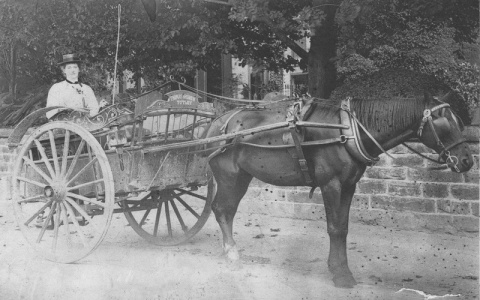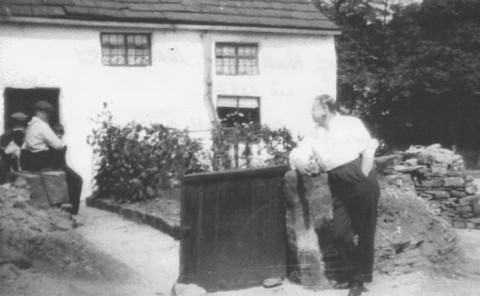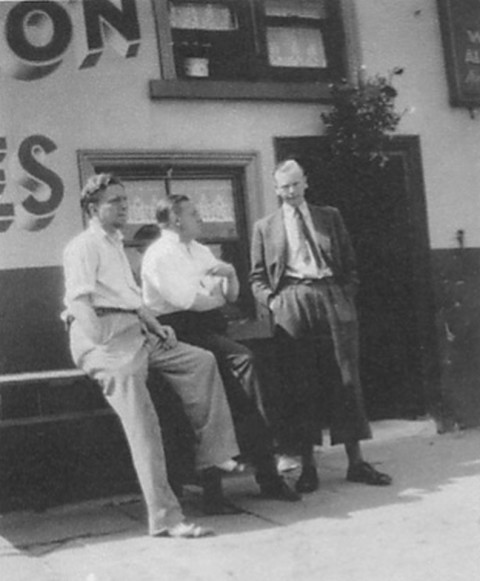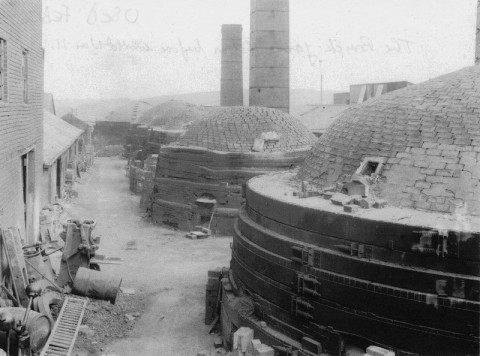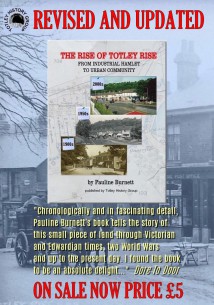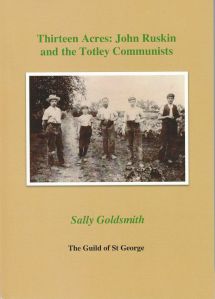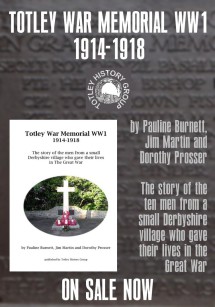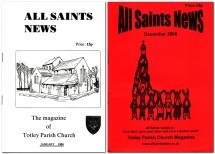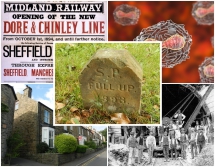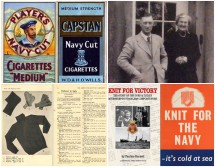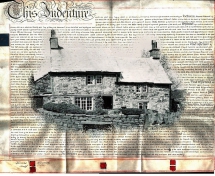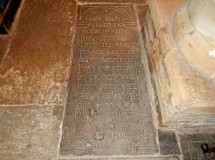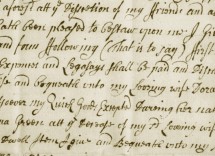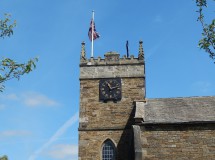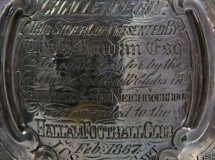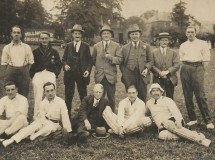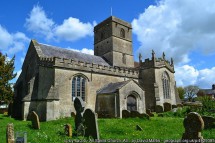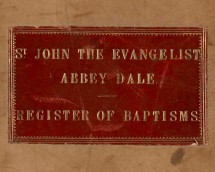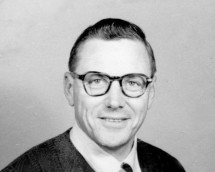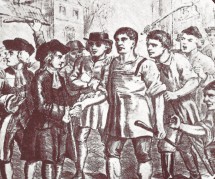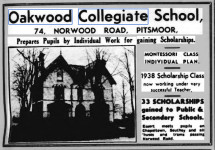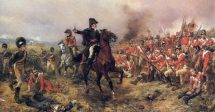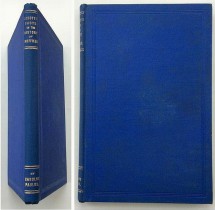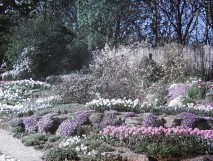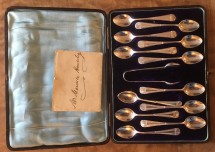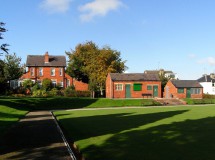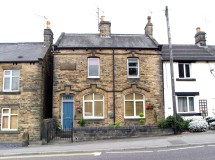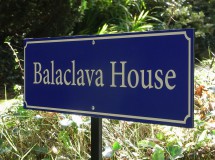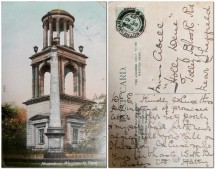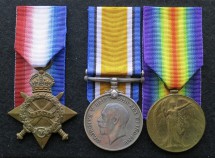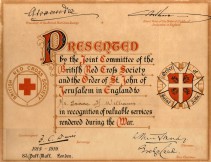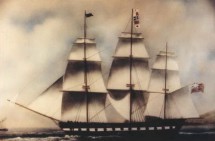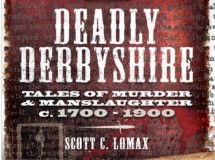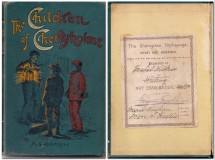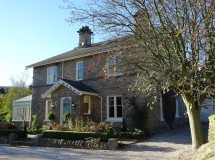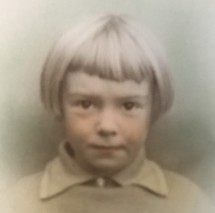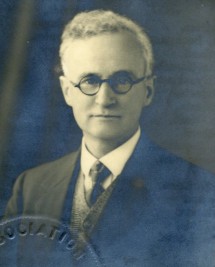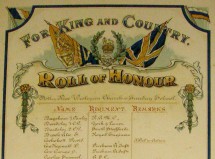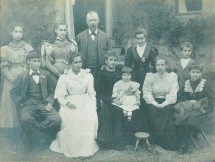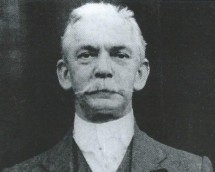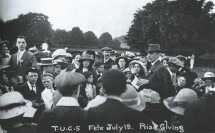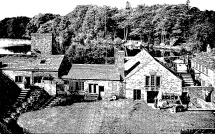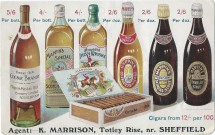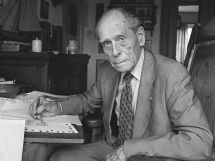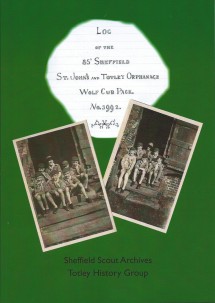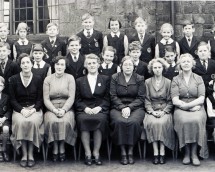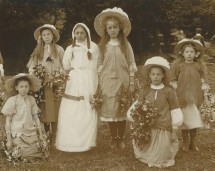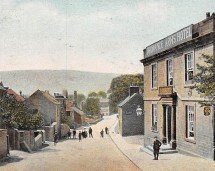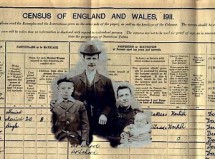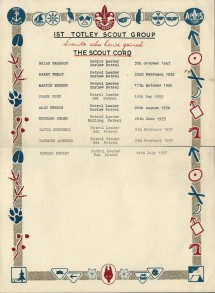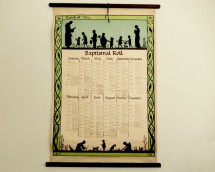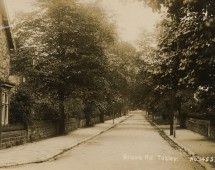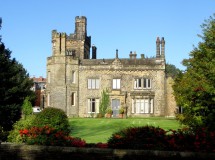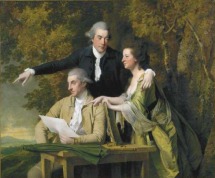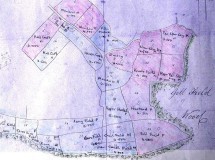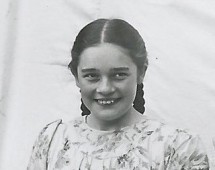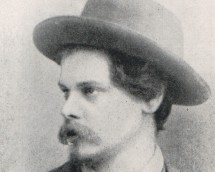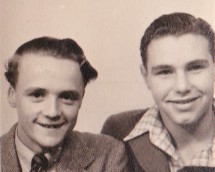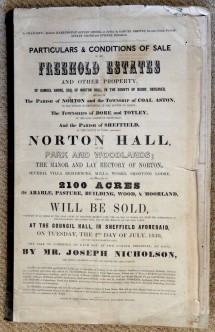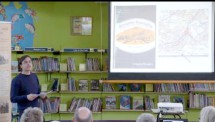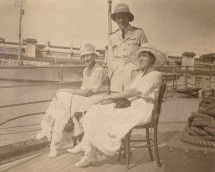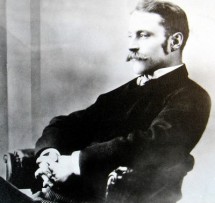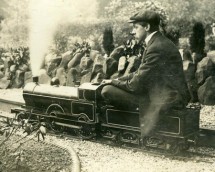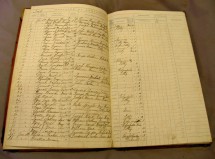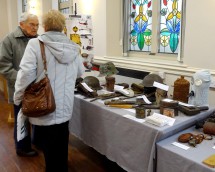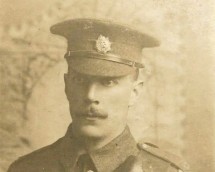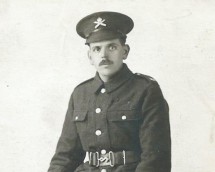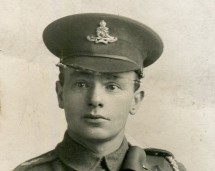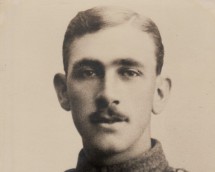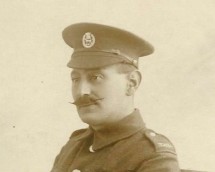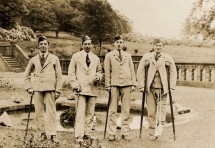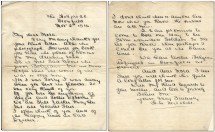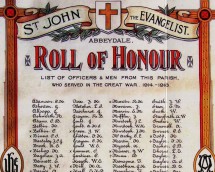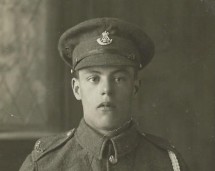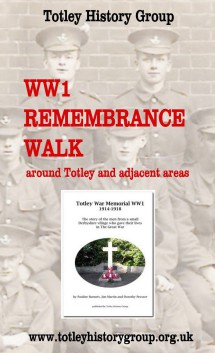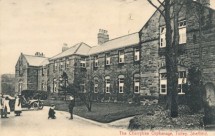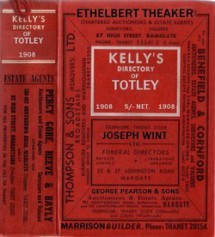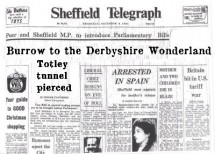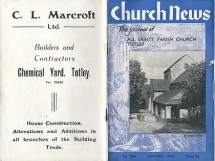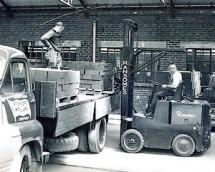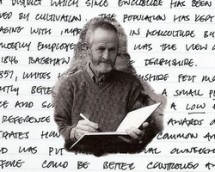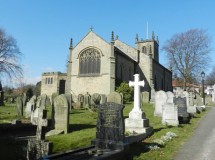Jo Rundle
Old Totley
Part One
It is a matter of conjecture as to what was 'Old Totley', and how far back one has to go, for every decade has some of the old and some of the new. In this case I am assuming that the person who wishes to know about 'Old Totley' means the life-time of the oldest members of today's society, the early 20C.so this is where I shall begin.
Life in the village was slow and comparatively quiet during the first decade of 1900, The Boar War was over, although there were still those with memories who talked about it, and sang the songs of the time. The dirt roads were surfaced with limestone chippings, not easy for the horses who pulled the Stage Coach every morning from Sheffield to the 'Changing-post' at The Cross Scythes Hotel farm on its way to Bakewell. After the steep climb from Totley Rise an overnight stay in the 'Baiting-shed' (Now demolished for new housing) must have been very welcome to the horses, to be ready for the return journey to Sheffield next day about 4.30pm. In 1912, the Parish Council asked Norton District Council if they would surface the road from Totley-Rise to Totley Village with tar macadam as they had already done up to Totley Rise, and the Council agreed, but, due to the outbreak of the first World War this was delayed until 1917 The Council members were obviously very proud of the new road for they instructed the Clerk to the Council to send a message to the Scavenger to ask him not to empty the ashpits after the roads had been swept on Saturday by the District Council. This obviously referred to Grange Terrace and those houses on the new road as the District Council were responsible only for the main roads, the Parish Council being responsible for those in the village.
The road sweeper was Joe Marshall, recently moved from Shrewsbury Terrace to the cottage at the end of Hall Lane, whose job it was to sweep Hillfoot Rd/Town Street, Penny Lane, The Bents, and Lane- head Road, every day, including collecting all the horse droppings, which almost certainly ended up on the front garden of his cottage. About 1923 Hall Lane, and the stretch of Hillfoot Road through the village, were surfaced with tar- macadam, but only the centre of the main road up to Lane Head was given the same treatment, leaving about 6ft. of limestone on each side. The footpath was still bare earth with chippings, except for a 12" border of grass that strengthened the edge against fouling of the surface drains.
The children at Lanehead were very happy, especially the boys, for now they had somewhere to play with their 'Whips and tops' on Shrove Tuesday, and iron rims made by Mr Bradshaw the blacksmith in his forge in the Chemical Yard. Using the hook specially designed to control the rim they travelled down the new road at a mighty speed. Even the girls created less dust as they dashed around with 'Shuttle-cock and battleboard'. This part of the main road was not fully surfaced until about 1924 along with the rest of Hillfoot Road, Penny Lane, the Bents and Lane-head Road. My Brother (2 years older than myself) and I remember seeing barrels of tar being deposited at intervals on the edge of the main road, followed a few days later by the appearance of a Steam- roller and other mysterious contraptions.
One morning a gang of men appeared and all the children at Lane-head watched as two men tipped one of the barrels of tar into a large container on top of a fire-box on wheels, and were fascinated to see the tar appear through the holes in a long perforated pipe as it was sprayed onto the surface of the road. A gang of men followed as they spread limestone chippings thickly over the tar and using long-handled rakes spread them over the surface before they were rolled in by the steamroller following behind. Very soon after this the whole road was surfaced as far as Baslow.
There was only one car in the village, a 'Crossley' owned by Mr. Milner of Totley Hall, and, although Totley Tunnel had been opened in 1993, travel out of the village was by Stage Coach until the arrival of the first Horse-bus in 1911. Goods were brought into and sent out of the village on Jimmy Larder's dray to and from Dore Station, and it was always possible to beg a lift from him if, and when necessary. There was, however, much horse-drawn traffic for milk-floats, and farm carts passed daily on their way to Sheffield carrying swedes, clover, and grain to the city farms, returning with loads of manure, otherwise difficult to dispose of, and welcome to the country farmers. A letter to the Parish Council on 16th October 1912 from John Wood Headmaster of the Church of England School requesting, 'that a Motor 'School sign' be fixed on the main highway just above Post Office drawing attention of the drivers of motor cars to the proximity of the school', suggests that there was some motor traffic through the village at the time, although most country folk know that a galloping horse's hoofs can be more dangerous than the slow moving motor cars of that time.
Soon after the road was fully surfaced, in 1924, a small 'bus belonging to 'Batley's Charabancs' of Sheffield, carrying one or two passengers, passed once a day on it's way to and from Baslow, soon to be taken over by the first Sheffield Corporation bus to Baslow and Bakewell at 10 o’clock in the morning, passing the cottages on it's return journey about 4.30 in the afternoon. A lone waggonette passed Lane Head occasionally, believed to be that belonging to an elderly couple Mr. and Mrs Hawes who lived in a cottage in the lane leading from Totley Rise to the Chemical Yard, and soon there were one or two cars each day, but they could be heard well before their appearance around the comer at the top of Lane Head Road, and we had plenty of time to pick up our tops and shuttle-cocks and move out of the way.
Boys in the village made trolleys out of orange and apple boxes begged from Mr. King the greengrocer at Green Oak, or from Mr. Evans at the shop in Hillfoot Road, and my brothers were no exception. Elijah, the eldest, made a trolley with such a box, and a set of pram wheels, perhaps donated by my Mother or kind neighbour or, more probably found on the Brickyard tip. Trying it out for the first time on this lovely new road he was just picking up speed when the Bakewell 'bus came around the comer above Lane Head and followed ever more closely behind him until, on reaching the War Memorial and the last stretch into the village, there was no escape but to dive for the gutter and hope for the best. Luckily both brother and trolley survived, and the bus-driver had the last laugh!
Part Two
There was no electricity, nor street lighting, at Lane Head until 1929, although there may have been some lighting on Summer Lane and in the immediate village. The only outside light was a single bulb attached to Kirby's barn, where it was the custom, even in those days, for the male population to congregate for their favourite pastime of gossip and teasing the passers-by, usually girls. If a light were needed, it might be a carriage lamp, a candle in a jam-jar or candlestick or, in my family, a pit lamp, the use of which sometimes caused great interest, or cynical humour. It happened one night when my Brother Elijah found himself on a journey to the 'Top shop' carrying my Father's safety lamp to provide illumination. When he reached the corner of Hall lane, there was the usual congregation of males enjoying the gossip of the day and ripe for a teasing session should one arise. This time it was my brother who hit the firing line, when one bright spark started teasing and attempting to blow out the lamp; no matter how hard he blew and poked, the offending light refused to disappear until the blower was in danger of losing his reason and stamping on the offending lamp. Luckily, the rest of the men realised that the fun had reached the point when interference was called for, and my brother made a very rapid dash to the shop.
When eventually electricity reached Lane Head it was the opening into another world, to say goodbye to the paraffin lamp, to sit on the sofa to read instead of all having to sit round the table reading in lamplight; for my Mum to have a little electric cooker instead of always relying on the fire, a simple switch to light my way up the stairs to bed instead of the candlestick and the fear of someone catching my last leg as I ran upstairs to bed and knelt in trepidation of the same spirit when I knelt beside my bed rapidly gabbling a prayer, but the greatest joy for my brothers and myself was, after listening on the 'Cat's Whisker' that Mr. Turner my Father's bowling-club friend had loaned, was our own dome-shaped wireless that made us rush home from work every evening to crowd around and listen to Henry Hall and his dance orchestra every evening at 6 .15 to 6.30pm a quarter of an hour of sheer bliss, that brought grunts and groans from my Father in protest at this new-fangled music that compared very unfavourably with Excelsior, The Old Organist, Nellie Dean, or even Kathleen Mavourneen. And we had a streetlight! under the tree at the Memorial. No longer was the walk home in the dark to be feared, nor even in the moonlight, as when I was 12yrs.old and returning home from Chapel, when, just before reaching the Memorial I saw a huge white shape rise from the gulley just below the cottages at Lane Head that shone in the moonlight and floated slowly, very slowly down the centre of the road. Mesmerised I walked in trepidation as it floated nearer and nearer twisting and turning gently in the breeze. Should I dash for the Memorial and hide?, or turn round and run? 1 stopped, staring, as it floated nearer and nearer now growing just a little frightened. It reached the Memorial and, just as I was about to panic and run for my life it floated gently to the ground and I realised with almost hysterical relief that it was a whole sheet of newspaper that had obviously been lifted out of the ravine by the breeze and carried so gently until the breeze was diverted by the trees and the Cross. I was very happy to see the new street lamp at the Memorial a year later, probably more welcome than Henry Hall.
Totley was well served with 'Pubs', all with their distinct clientele The Cross Scythes Hotel and farm, until the first horse- bus arrived in 1911, was the Changing-post for the stagecoach horses that were fed and kept overnight in the Bating-shed (Recently demolished for house building). It had changed hands many times since my Great- Great- Grandfather Thomas Fisher left there for Hallfield farm in 1851, and was popular with Stagecoach travellers and later the passengers who ventured into the country in the first Horse-bus in 1911. There were others who enjoyed its somewhat more superior appearance and possibly more sophisticated customer. The 'Fleur de Lys' was the 'Local' for most village men and farmers, although a few years earlier the Ale House in Town Street, (Later Walter Evan's shop, until he built and moved into the shop at the top of main Avenue) had been handy for 'Take-a-ways', as even children could buy and carry mugs of beer through the streets provided they were covered with the official 'Tamper free' seal.
John Green had been the Tenant of the 'Flu' for many years until he bought it during Lord Middleton's sale of local properties. After John Green's death there were a few tenants, the last George Creswick from 1889 until John's daughter Martha Fearney returned in 1891when it was passed to John's Grand- daughter Harriet Fearney, now Mrs. Thomas (Tom) Kirby, and it is the Kirby's who were the most associated with Totley village than all the other publicans. From the late 19th.c Totley Hall Lane farm was owned by Heald Unwin from Dore, whose son Fred built the semi- detached houses on the S.W. of Baslow Road above the Hill-foot junction about 1904, moving into the bottom one 'Fern Mount' after his marriage. Miss Harris, music teacher to my brother Elijah and myself lived in the next house until she moved to Main Avenue in 1926. Heald Unwin sold the farm to Arthur Fearney, brother of Harriet Kirby and went back to Dore, but Arthur was not a very good farmer and in 1923 he sold all the land behind the 'Flu', on which Stock's Green is now built, and as far as the rear of Totley Hall, to his sister Harriet thereby creating a new farm at the comer of Hall Lane and the Main Road that was managed by Arthur, Tom's younger son. Tom Kirby died around 1923 when Thomas, his elder son took over the Fleur de Lys, and Harriet, his Mother, left Totley for a time, returning about 1926 as Mrs. Cross, when she built and lived in the farmhouse on the comer of Hall Lane.
In 1929/30 Arthur Kirby married Catherine Parkinson, Grand- daughter of Thomas Andrews previously of Totley Hall Farm and later of Mooredge Farm, at the comer of Moorwood Lane, Holmesfield. The Crown Inn in Hillfoot Road, The Cricket Inn and The Grouse Inn in Totley Bents were all popular 'pubs' with there own special atmospheres, although, of course women did not enter 'Pubs' at that time, for it was the surest way to lose one's reputation! More about 'Pubs' later.
Washing day was a weekly occasion, done by hand with a Tosher', a 'Scrubbing board' and a 'Peggy-legs' by the housewife kneeling beside a large tub with corrugated sides that could be used for scrubbing larger articles, or work clothes that required an extra strong rub. Systems varied, some housewives sorted the clothes on Monday and put the 'Whites' to soak in cold water overnight, others did the washing on Monday without previous soaking, whilst others did the brushing of suits, emptying pockets, securing or stitching-on buttons where necessary, and re-hanging those items that weren't for washing this week. My Mother belonged to the last group, for a good reason, as, like many other wives, the drying-ground had to be shared. This was the day of large families compared with today, of cottons and woollens, blankets and unbleached sheets, frills and flounces, flannel shirts and starched collars, which all required clothes lines and hanging-out space more than the usual yard would permit, for there were no electric dryers. So, sharing and planning was the name of the game, share the yard, share the clotheslines, share out the days! You do yours on Monday, I'll do mine on Tuesday, and that's what my Mum and Mrs. Smith next door did. It had other benefits too. Try folding a heavy Whitney blanket, or four hill-sized unbleached cotton sheets, or even bleached if you were lucky enough to have them, on a good breezy washing day without one of the corners hitting the dust, and you would soon know how good it was when Mrs. Smith, or Mrs. Salt, as the case may be, came out to help. Two housewives standing facing each other, deftly gathering the ends of a sheet sides to middle, rocking back on their heels; pulling and stretching; folding and stretching twice, then one passing to the other for the final fold, all creases gone, no ironing needed, just put through the mangle and on the clothes-horse to air.
The same system, in various modifications were practiced in most households, organised days of baking so you could borrow a couple of loaf tins if necessary, shared mince pie tins at Christmas, and the inevitable 'Cup of sugar' when required. It all went with the ever-open door, the cheery call "How are you?" "We're going blackberrying, are you coming?" or, in the village those neighbours who went gathering firewood in Gillfield wood, returning with huge bundles strapped on their shoulders and laughing their way through the latest gossip.
Part Three
At our house washing-day started before breakfast when Mom disappeared down the stone steps into the cellar kitchen and lit the copper fire, filled the iron copper with cold water, and put the whites to soak in cold water in the peggy-tub. Breakfast over, kids gone to school, something prepared for their dinners at 12 o’clock (It's lunch these days!) and work began. The soaked sheets were put through the huge mangle rolls, and put back into the emptied tub, now filled with hot water from the copper, a pile of clothes on the flagged floor to kneel on and rubbing and squeezing began.
First were the white sheets for they took longer to boil and needed long drying-time, After rubbing where necessary the peggy-legs were brought into action, twisting one way, return and twist again, ponch down and twist again, it went on for minutes, until the sheets were deemed clean. Then the action that always mesmerised me when the ends of the sheet were grasped in both hands and twisted; grasped further down and twisted again; repeat until the whole sheet had been twisted and rung-out, as it gradually curved around Mum's arm up to her shoulder like a snake in an Arabian night's opera. The action was repeated for the rest of the sheets and the whites until, all done, the tub was emptied and filled again with water from the copper, and the procedure was repeated, the second time finished by a turn through the huge mangle rollers, and back into the now emptied tub filled with cold water for a good rinse. The final squeeze was through the rollers twice, tightening the cog-wheel a little for the second turn, and out into the yard to hang on the line by all four comers where it filled with wind like the sail of a racing yacht.
The same procedure was followed for all the wash in rotation; whites, coloureds, towels, work clothes, as deemed necessary. In between there was dinner to cook for the kids at 12 o'clock, usually something that could be put in the oven and checked from time to time as convenient. Plus a meal for Dad when he returned from the Pit about three o'clock after setting-on the afternoon shift at Strawberry Lee Pit. My favourite was oven bottom chips with fried egg, but the boys never seemed to mind, except Elijah who liked bread and butter pudding sometimes made with a left over teacake, whatever he had first.
Of course Shrove Tuesday was pancake day, when Mom made a huge yellow bowl of batter and stood at the fire-place making pancakes until we had all had enough, or until there was just enough to make one for Dad, because he would cry his eyes out if he didn't get a pancake on Shrove Tuesday.
There were two shops in Totley, one dating back into the 19th century still owned by Charles Thomas Jackson, known, and usually referred to as Choppy Jackson, or Shoppy by some people depending on the reason for the name. Shoppy referred to his occupation. Choppy to his habit of chopping a little off a bacon rasher when the scales went down too fast. Choppy had a strong sense of humour and was popular, but a 'Canny' sort of human being both as shopkeeper, and as baker. His bakery was in a separate building on the comer of Hall Lane and the narrow lane behind the shop leading to Grange Terrace.
As a young man Choppy organised his day so that he could take a late afternoon/evening siesta and start working in his bakery about ten p.m. to produce the first loaves by opening time. By mid-afternoon all baking was finished but the ovens were still hot, so housewives could take their loaves, already mixed, kneaded, and risen, and have them baked for 1d. per loaf, an arrangement fully appreciated by the housewives, particularly those in Hall Lane who took full advantage.
Walter Evans's shop in Hillfoot Road was previously an Ale House at one time run by John Fisher, and probably still had the licence for selling liquor, for I can remember seeing bottles on the shelves that could have been 'Pale Ale'. The shop was very different in the twenties, as the entrance at that time was down a path to a side door, passing by a large window that displayed all kinds of goods, some on stands, others on shelves at the sides and at the back. Everything but fresh meat could be obtained there, but, as at Marrison's at Totley Rise and other shops that sold groceries, most items were displayed in bulk, or in packages weighed out by the shop-keeper into bags of various types and sizes.
Sugar was sold in 1lb. and 21b. blue paper bags, with tops folded and sealed with glued paper from a large reel such as the one on the counter used for immediate sales. Preserving sugar, particularly during the summer jamming season, was often sold straight from the sack as required or, for busy times, weighed out into 3ib, bags for quick service. Flour and Grist, was sold ready weighed into large white paper bags weighing ¼ stone, ½ stone, or l stone (14 1bs or 6 ½K), similar to the Chandlers of today who still serve flour, grist, wheat etc straight from the sack. Biscuits were served straight from the large square tins on display on the counter or shelves, and many items such as ginger, pepper, cloves, and cinnamon were served from tall glass jars displayed on shelves, using a small scoop, and it wasn't unusual to be served sweets in a cone of paper deftly twisted into shape by the shopkeeper. Most sweets were 2d a quarter so the Saturday penny spending money could buy 2oz. of Blue Bird chocolate toffees, and the penny from Mom on Friday was a bonus. Prices between the wars seldom changed, a tin of salmon was always 3s 6d. and a loaf of bread 4 ½d, but then wages remained the same, unless awarded for extra responsibility, training, experience, or heavier workload, not annually as today.
There have been so many changes since the 20s and 30s that it is difficult not to become boring, "I've heard it all before" "Things have changed Mum" "Move on", but, though some changes have brought easier and more interesting lives and prosperity for so many people, memories don't move on. Imagine a bright moonlight night shedding light over the fields and moors, and somebody says "Let's play Holler", and all the kids at Lane Head, boys and girls, divide into two teams, the foxes and the dogs. The foxes set off down Lane Head Road, shouting and hollering as they race down to the Bents and up Moss Road, or Strawberry Lane, and spread out onto the moors. The dogs follow, hooting and calling "Shout Holler or the dogs won't toiler", and a Loud "Holler" comes back from the Bents, Strawberry Lea or high on the moors the Brickyard or Gillfield wood. The dogs keep shouting, the foxes keep hollering back. It could go on for hours, but the mums and dads never worried, they could hear where we were, and knew what we were doing, knowing that when the foxes were caught, or everybody had had enough, we would all return safely and go to bed without any prompting after a wonderful evening.
We played 'Peggy' when a short stick was placed on the top of a wall and in turn, using a long stick, would strike the 'Peggy' and watch it fly through the air and see who could send it farthest. No prizes, just honour!
Part Four
The recent changes in the centre of Totley village have completely transformed it from the one known throughout the years, it seems almost since Domesday, for the farmhouse on the corner of Hillfoot Road and the main road, opposite the market cross and entrance to Cross Scythes farm, had been the heart of the village since before the new turnpike road was created from Owler Bar to Sheffield in 1818. Summer Lane, possibly one of the new developments resulting from the more easily accessible village, had been known by various names, Ogden's Walk in 1880 after an important resident who lived here. New Row in 1891, when residents were diverse characters and occupations, some moving in from other parts of the village.
One such was Joseph Ward, stonemason, with his wife Ann, son Henry and daughter Eva. Henry, later known as Harry Ward, lived in what was then known as Chapel Walk, now referred to as Chapel Lane, in one of the houses overlooking the path. Perhaps there are some Totley residents who remember Harry's son Ernest, who married Doris Turner, daughter of Mr. Turner, one of the leaders at the Chapel, who lived in Lemont Road, Green Oak. Doris was a member of the Chapel choir and both she and Ernest were members of a local choir, the name of which eludes me, but should any of the Wrigglesworth family still live in or near Totley they may know, for, after Ernest's untimely death, Doris was for many years a member of the choir created by Dick? Wrigglesworth.
William Green, file cutter, who with his wife Elizabeth and children Amelia 11, Harry 8, Effie 5. Arnold 8, now lived in New Row and this Harry, I believe, was the friend of my Mother, who often spoke of his sister Effie. In the 20s Harry was the joiner and coffin-maker who lived on Glover Road at Totley Rise, and about 1930 was the last publican at the old Fleur-de-Lys in 1932, and first in the new one in 1933. There were so many file-cutters in Totley in the early 20th century, in Hall Lane, Lane Head, New Row, and Hillfoot Road, that one is led to think that they might have been out-workers for the forges in the valley, much as the 'Little-Mester' farmer in Cordwell, Elijah Green, who was a tortoise-shell penknife finisher for a cutlery firm in Sheffield. There may be records somewhere for anyone who has the interest and time to search.
Two elderly sisters, Olive and Alice Green lived in one of two cottages nos. l and 2 that still stand at the entrance to Summer Lane, next door to the Kenworthies, already mentioned in a previous article. Until his death, James Green their Father lived there with his wife Millicent, sons James and William, and Olive and Alice. Another daughter had married my Mother's Uncle, Henry Peat, a besom maker, son of John and Ann Peat of Piper Cottage opposite the top gate of Blackamoor. The records describe James Green as a carpenter, but my Mother often spoke of him as being a famous clock-maker, more correctly a clock cabinetmaker, his work apparently known for many miles around the district and Sheffield.
Those Totley residents who attended the Wesleyan Chapel in the 20s will remember Olive and Alice Green, for they were two stalwarts of the congregation, unique, prim, always walking with their rolled-up umbrellas, the backbone of the Chapel. James's son James was also a cabinet case maker, but William his youngest son may be better known to the older residents; He lived at the far end of Summer Lane and worked as a gardener at Totley Hall. He was a well-known character with a pronounced rolling gait that brought many humorous remarks from the lads. William was father of ? 'Cobby' the main butt for the ridicule of the Headmaster, John Wood's sarcasm, and Harold ‘Nobby’ whose wedding was the first to be held at the new Church on July 25th 1924. It was at his wedding that the custom of locking the gates first started when the lads of the village, as a prank, fastened the gates to the Church and made the bridegroom pay a fee of half a crown (2/6) to have them opened. This was supposed to be a 'One off, but became a habit and, in 1936 after my wedding, my new husband made sure he had a half-crown in his pocket to pay the toll.
The farmer at the comer of Hillfoot Road, more correctly the cow keeper was Joseph Wainwright, son of George Wainwright, Great-Great-Grandson of George Wainwright a Methodist Preacher and Weaver, who was born at Dons in 1717, whose portrait hangs in the Cutlers' Hall Sheffield. The Cutlers' Company had an ingenious way of raising funds to celebrate important occasions, as they did in 1809 to celebrate George III's Jubilee, by inviting a group of very notable citizens to dinner at the Cutlers' Hall who, in return for a donation to the Company's cause, received a self-portrait. The oldest guest was George Wainwright, whose portrait was painted by a Leeds artist by the unusual name of Schwanfelder. In 1926 the portrait was given to the Cutlers' company by a relative, W.G. Mitchell -Withers and still hangs in the Cutlers' Hall, Sheffield.
Joseph Wainwright had three children George, Harriet, and Sarah who, though very proud, were sadly not very bright, and none of them ever married. There was only a small amount of land and a cow shed close to the farmhouse so one assumes that the cattle were turned out during the summer to graze in local fields, as were those in the city farms in Sheffield. After Joseph's death in 1897 the shed and land were used for a few years by a local man and, though derelict, the shed was still there at least until the end of the war in 1945. By 1898 three cottages had been built on the land at right angles to the road at the end of the bank down to Summer Lane, whether by George, Joseph's son, or by sale of the land to a local builder is not known. The family stayed at the farm until 1900, when George and his sisters moved into the middle cottage in Baslow Road, where they remained for many years.
In 1909 Emma Fisher lived in the far cottage with three of her children, when she left Hallfield Farm after the death of her husband, Francis. As a child, Emma was one of the last pupils to attend the National School in Hall Lane, at a cost to her Father, George Hodkin, of one penny per week. After the Wainwrights left, the farm house was sold and became the first Post-Office in Totley, when my Great Uncle, Arthur Bradley and his wife Alice moved from Butts Hill cottages and Alice became the first Post-mistress. Arthur continued working at Totley Hall as Forester and acting Head- Gardener until 1904, when David Lewis, a newcomer to Totley, became the new Head-gardener with Arthur Bradley as Forester and Under Head-gardener. On the same day in 1904, Mr. Thomas and his wife, parents of Archie and Ernie Thomas, came to Totley to take up the post as the first Butler at Totley Hall.
On the outbreak of World War I, both men were called-up for war service, in jobs that allowed Mr. Lewis to return to the Hall at certain times to keep his eye on the glasshouses, and Mr. Thomas was employed in special work in Electricity, and during their absence the duties of Butler were taken over by the Parlour maid. David Lewis returned to the Hall after the War and remained there until Mrs. Milner left in 1933. Mr Thomas continued to work in his wartime job in Sheffield and the post of Butler at Totley Hall ceased.
Archie Thomas was a fast runner, later to become a member of the Sheffield Harrier's Club, but when he was about 11 or 12 years old, he became a life-line for Alice Bradley for, although Totley could receive telegrams, they were unable to deliver them outside the village and, according to the Parish council minutes, there had developed a little animosity between her and the post- mistress at Totley Rise, over the delivery of telegrams. Archie stepped into the breach and started delivering telegrams from Totley Post Office destined for Holmesfield and Cordwell Valley, the only long distance deliveries from Totley, and this solved the problem of the postmistresses. Archie said he could run up the Park and down Millthorpe Lane to Carpenter's cottage in 2mins, but it took him a little longer to run back! By the twenties, Totley had it's own public telephone box that stood outside Choppy Jackson's shop, a boon for the residents
Another well-known resident of Summer Lane for three decades was Emily Green, daughter of William Green, a file cutter who had moved from Hall Lane to the house and shop beside the post-office. It was a two-level house, the living area reached by an outside flight of steps, where William lived for some years. The shop at ground level sold almost everything in the way of sweets, knick-knacks, dressmaking accessories, pens and pencils of all makes, in fact, if anything were needed, try Emily Green's first. However, Emily really was a dressmaker with clients for miles around, whose working rooms were also upstairs at me back of the house, whilst her niece Mabel, a demure little person, effusive in her smiles, helped to serve in the shop below. About 1930, Totley's first chip-shop was opened by Tom Kirby, son of the Fleur landlord, on the main road next to the old barn where fish and chips cost 3d, (2d for the fish and 1d for the chips); the fish being a thick slice from a huge Cod, not the fillets as sold today. It was a favourite meeting point on Friday and Saturday nights by the young folk, and sorely missed when it closed a few years later.
However, it was not long before Emily, a true business woman, opened a new chip shop in Chapel walk, next door to Harry Ward, which was reached by a flight of steps next to the Wesleyan Chapel. Although somewhat out of the way, it was very popular, and Mabel seemed to smile even more as she deftly served fish and chips. There were of course other means of obtaining the necessary things in life when Mr. Gillespie came round once a week with his covered dray, bursting with household goods such as pots and pans that hung from hooks around the sides of his dray, plates and dishes and fancy pottery, floor-cloths and dusters and almost everything necessary to the general cleaning of the house and, most important, paraffin for the lamps for, although Emily Green sold paraffin along with everything else useful in an emergency, it had to be carried home, whereas Mr. Gillespie brought it right up to the door, a boon for a busy housewife.
However there was stillroom for another delivery man nicknamed 'Pot-mold', real name Philip Coates. Pot-mold earned his name on account of his habit of shouting "pot-mold" all the way up the main road to announce his arrival. Pot-mold, a hard yellow natural stone that cost 1d per piece, was used for rubbing around the edges of steps where decoration was not the primary intention, whereas Donkey-stone, also sold by Pot-mold for 2d, a pre-formed block was used where a little decoration was called for, or a more refined look like the front door step. Of course, Pot-mold sold all other things one might need in the way of polishes for shoes, furniture, brushes, dusters, in fact, between them Mr. Gillespie and Pot-mold supplied everything one could possibly need for the running of a happy household, including the garden and toilets. For disposal of the worn-out, shrunken, and otherwise unwanted items there was the Rag and Bone man, who came round once a month with balloons flying in the wind from his dray full of cast-offs, throw- outs, shrunken jumpers and clothing too small for further hand- me-downs. However small the item begged by the children from Mum, in return was the gift of a balloon, a paper windmill or, if the goods warranted it, a penny.
Then there was the Trumpet man, a very refined and polite man, who had a large clubfoot and walked with a pronounced limp. We never knew his name, but he came round about once a month, when the weather permitted and stood in the middle of the road, playing songs and well- known tunes on his Trumpet. He obviously was a good musician, much appreciated by the residents at Lane Head, especially when he played one of their requests, and they were very generous with the money they put into his hand when he finished.
The opening of the new main road had allowed the village to expand and soon there was a new lane. Lane Head Road, that allowed access to and from Moneybrook and the Bents, without the necessity of walking along Penny Lane, up Chapel fields to the village to catch the Stagecoach and later Hatty's 'Bus to Sheffield, or out into Derbyshire. An early map of 1845 shows a building at the top of the lane, occupied by a fanner, Samuel White, and there was still a pile of hewn stone in the fenced-off area at the top of Butts field when we played there throughout (he twenties. By 1875 a cottage had been built on the opposite comer of the lane with a cow- house, a shed, and a file shop that was also occupied by a fanner, Samuel White, who could be the same man who wanted more buildings, or the first Samuel's son.
The remains of the cottage and buildings were still in the old farmyard throughout the twenties and thirties, when the shed was used by Billy Gascoigne, as a garage for the big traction engine that he drove for Pickford & Holland, and the farmyard gradually evolved into Gascoigne's garden. By 1875, three houses had been built at the top of Lane- Head Road, below the cottage and cow-house, one of which, in 1883, was the home of Edward Abraham Salt, my Grandfather, his wife Julia and their seven-month-old daughter Isabella.
Part Five
Ben Salt, Edward's brother lived next door with his wife and family. Both Brothers worked in their father Joseph Salt's clay mine on Totley Moor, (mentioned in an earlier article) which, about 1899, was sold by its latest owner, Mr. Batley, to Joseph Holland, to become part of Pickford and Holland's. In those early days, the Brickworks were open to the sky, when Jack Slack passed our door every evening just before dark, carrying his lantern and 'Snap-bag', knowing that he would probably have company through the night, for Tramps passed regularly up the road from the Workhouse at Sheffield on their way to the next Workhouse at Bakewell, and a warm night and the possibility of a mug of tea was not to be missed. The Kilns then were open to the sky, the light from the fires being visible for miles around and it was not unusual for a tramp to walk in and have a cup of Jack's tea and a warm seat for an hour. The outbreak of World War II changed many things, especially the Blackout, and very soon a roof was built over the whole Brickyard site in order to blot out the light from German planes.
We do not see tramps these days, but before WWII they called at our cottage regularly, on their way from the workhouse in Sheffield to the next one in Bakewell, asking for a pot of tea and a bite to eat, and my brothers and I swore that there was a mark on our gate telling all the tramps and gipsies that we were a soft touch. But, as my father explained, they were respectable men who were either looking for work or they preferred that way of life. He also explained that, according to the Vagrancy Act, anybody could be apprehended in the street by the Police, if they suspected that a person had no means of paying for a night's lodging; if not they were taken to the nearest Police station for the night as a vagrant.
The Workhouse system avoided such disgrace by giving the man supper, a night's lodging, and breakfast, in return for some simple work, and next morning giving him a sandwich, and a shilling, to offer to another workhouse for his next night's lodging, thus avoiding arrest as a vagrant. It now seems a strange law, that asking at someone's door was different from begging in the street, for under The Beggar's Law, the police could arrest anybody and take them to court for the latter, but not for doing the same thing at someone's door, because, I presume, he had money to pay if asked, and of course, he never was. Such are the finer points of the Law.
A few years ago I asked a policeman friend if these two laws had ever been rescinded, and he said that he had never heard of them, but would find out. He contacted me a few weeks later with the news that no one else in the office had heard of them; but had investigated and, yes there had been such laws, and they had never been rescinded, just faded away through not being used! Father said we were never to turn away a Tramp and my Mother said the same about gypsies who called regularly, selling lace in the early 20th century.
Part Six
The Bents was a thriving community of seven farms, two in Moss Road, one at Moneybrook, another at Moneybrook Rise, two in the Bents, and another across the fields at Old Hay. The Hamlet of Old Hay had been a thriving community in the 19c, with its forges, mills, and John Dalton's Paper Mill, but throughout the twenties and thirties, it was the playground in winter for Totley residents of all ages, who skated on the frozen Dam. The experts like Charlie Coates taught those who couldn't skate, and the young ones used the icy surface for making perfect slides, and all ages had a wonderful time. Sadly the dam was filled in years later, after a local man had used it to commit suicide.
About 1885, a cottage and two small three-story houses were built into the hillside on the main road at Lane Head, on allotment land that was under the Jurisdiction of Rev J.T F. Aldred, Vicar of Dore, and in 1889 a plot of land 1222 sq. yds. with a frontage on to the main road, containing four houses, three newly built, and a cottage, was sold at auction by Auctioneers in High Street and Castle Hill, and Solicitors 'Burdekin, Benson, and Burdekin' of Norfolk Street, Sheffield.
At the time of the sale, two of the new houses were occupied by Messrs. Handley and Coates, and by 1891, James Green, File Cutter, had moved into the third one with his wife Ann and their children. Sampson age 22, also a File Cutter, Tom 14, Jessie 9, Steven 3. James, a later son was also to become a file cutter, who still lived in the same house with his wife and son Harold during the 20s and 30s. Jim Green's hobby was breeding canaries, a hobby that made him famous for miles around. As children and playmates of his son Harold, he occasionally allowed us to enter his cellar and look aghast at the beautiful birds in the cages that lined the walls, all different in colour, shape, and song, due no doubt to Jim's clever interbreeding.
In 1891 Edward Dalton of Lower Bents Farm, descendent of the Daltons, Yeomen farmers of Lower Bents farm and Overseers of the Poor for two centuries, died, and his wife, nee Elizabeth Peat, my great, great Aunt, moved into the first cottage at Lane Head, and Albert Fox and his family moved into Lower Bents Farm. Kate, one of Albert's daughters, married Joe Burgess, a local man, and for many years Rose Burgess his daughter lived there with her husband, Bill Taylor, until her death.
I was born in the Old School House in Hall Lane in 1915, leaving there with my parents and 3 year old brother Elijah in 1916, for our new home in the same cottage at Lane Head that was to be my home until I married a Sheffield Policeman in 1936. Residency was stable at Lane-head for a number of years after 1916, until the Putrells, our next door neighbours, left in 1925, and the Ramsells joined the small community at Lane Head.
The top house was the home of William Gascoigne, who drove the big traction engine for Pickford and Holland. Maurice Jobnson with his wife and five sons resided in the second, James Green in the third, with Arthur Ward, his wife, son Arthur, and daughter Bertha, the long-standing residents of the other cottage in the middle of the row. The Ramsells were next on the opposite side of the steps down to the back yard, whilst the Smiths were well established next door to us, the Salts in the bottom cottage. This situation lasted for thirteen happy years, during which time I had left to be married, until 1938 when the Smiths moved out and became the new residents in the Old School House in Hall Lane, now enlarged inside by putting in a new floor/ceiling to create more bedroom space than the original building.
Soon there were new residents at Lane Head after the cottage and the two bottom houses were sold and the daughter of the new owner moved in. After many years of negotiating between my Father and the new owner, he finally moved to Moorwood Lane in 1947 and there have been many changes since then. The rest is modern history!
A year after John Wood became Headmaster of the Totley Church of England School he, and the Headmaster of Dore School, organised a Pageant to commemorate the anniversary of the meeting between King Eanred of Northumbria and Ecgbert, King of Wessex in 829; whose symbolic Wyvern is displayed on a Stone on the village green at Dore. When Ecgbert finally conquered Mercia, he continued north, following the boundary between Mercia and Northumbria.crossing the Mytham bridge at Hathersage, following the boundary between Mercia and Northumbria, over Big Moor, finally reaching the ridge over Totley Moor to Dore. However there was no battle, for Eanred surrendered to Ecgbert, who now became the first Overlord of all England and was crowned King at Winchester, the Capital, a month later. Sad to say, his triumph did. not last long, owing to the Danes, but that does not detract from the fact that Ecgbert was the first King of England. According to the account told to me by our neighbour, Arthur Ward, when I was a very young girl who hardly understood the implications of what he was saying, without describing the actual formation of the soldiers, explained that the positions of the respective armies were reversed at the pageant, when Ecgbert's army of Mercians on the ridge at Dore, were Totley pupils, whilst Eanred's soldiers of Northumbria in a field at Avenue farm were pupils of Dore school. This might have been symbolic in the fact that no actual battle took place. Who knows?
Perhaps the most memorable event in our teenage lives was the advent of the Talkies. Not that Totley residents made a habit of 'going to the pictures', for the nearest Picture-house was six miles away at Abbeydale, near Broadfield Road. The cost of a seat in the stalls was 9d, which is just about the same as today .considering that no man in the twenties earned more than two pounds a week, and most were nearer one pound. Youths were lucky if they earned fifteen shillings a week, which was handed over to Mother for housekeeping (Father in our house), in exchange for spending money.
I was eight years old when my Father took me, my brother Elijah, and Nellie Smith from the house next door, to Abbeydale Picture House to see one of the classic silent films, Charlie Chaplin in 'The Gold Rush'. It was impressive, especially when Charlie's hut was blown away in a gale and he was left at the top of a precipice, eating his boots. A year or two later, when the Talkies 'The Singing Fool' and 'Showboat' came to the cinemas the effect was even more impressive when we actually saw the kneeling Al Jolson with pleading arms raised to Heaven, singing 'Sonny Boy', Such was the interest in this new phenomenon, that soon there was a cult of filmstar worship, sometimes heart-throbs or strictly as actors.
Even my father soon had his favourite actor, Alistair Sim, whose cryptic sense of humour never failed to tempt him into Abbeydale Picture House, and soon the faces of famous Stars replaced those of footballers and animals on cigarette cards.
Part Seven
In 1948 the new Health Service came into force and at the time it was applauded as a means of free treatment and medicines for all and, had it not been treated as a free handout for every minor ailment, it might have weathered the advances in medical technology and increased costs of treatment and fulfilled the dreams of Beveridge, Churchill and the Government. From the moment that the N.H.S. was created many doctor's surgeries and outpatient departments were inundated with requests for simple things like aspirins, plasters, and treatment for the smallest cuts or minor wounds that hitherto had been treated at home.
Very soon it was evident that some restrictions should have been included, and the purpose of the N.H.S. more clearly defined as being for more serious illness and hospital treatment. Some members of the community wondered why the new system was so essential when, until the end of W.W.2. no-one in the village had been denied treatment when necessary. Totley was not alone in such thinking because as part of the existing Voluntary Hospitals System most villages, and areas of towns and cities had their own Hospital committees. Friendly Societies and other organisations dealt with emergencies and since W.W. 1 it had been considered a pleasant duty to work for the hospitals, even the children played their part.
During the war Mrs Colin Thompson, wife of the Totley Rise butcher and her daughter along with Nellie Gill, Sister of ‘Choppy’ Jackson, and other local women had been nurses at the war-time Hospital for injured soldiers in St. John's Church Hall Abbeydale (More later), and both ladies were also members of the Totley Hospital Committee. My Father and Mother (the former also representing the Parish Council), were both Committee members with Mrs. Milner of Totley Hall their Chairman. As a School Govemer Mrs. Milner was well acquainted with some of the problems of the children and their parents and once a year the ladies of the committee were invited to the Hall for a very informal afternoon tea when the welfare of the village was the main topic of conversation.. As with all committees each member had his/her special responsibility and my Mother's was to collect the hospital contributions from all working men. Many years later she told me that no man paid more than 2d a week, for the average wage was about £l-10s (£l-50p), very few reaching the princely sum of £2; some of them also subscribing the same amount to Dore Friendly Society in case of future need.
In Totley, whether through illness or death of a husband, we had the occasional call by a lady from the village asking to see my Father as representative of the Parish Council for his help in obtaining the 'Parish' i.e. the amount paid to a widow on the death of her husband, or, in case of illness, the amount allowed for children. On such occasions we children were instructed to "Take the lady into the room" and ask no questions. (the 'Room' was the sitting-room or parlour at our house) The amount of the 'Parish' allowance was 2s 6d (12.5p), with additions for each child, not a lot today but in the 20s and 30s it could have been an eighth of a labourer's wages.
However, the hospitals did not have to rely on subscriptions because the committees were constantly working at some project to make money, by whist-drives, usually in the school and, after the Labour Hall was built, an annual dance when all the refreshments were given by the public. The greatest effort, however, was the work put in by everybody during the annual food collections organised by the Committee to supplement that provided by the hospitals themselves.
Many houses kept a few hens if they had either a back-yard or an adjacent piece of land large enough to house a small shed and, during April the main egg-laying season, the older children, often accompanied by younger brothers and sisters, went round the village with baskets of all shapes and sizes collecting contributions of eggs for the hospitals to lay down in large pickling-jars of Isinglass to be used for cooking throughout the year. Contributions could be one egg, possibly two or three, but occasionally a whole half dozen would bring a broad smile from the collector. Of course the greatest contribution was from the large houses and farmers, in which case the responsibility fell on the adults; anyone who owned any mode of transport, bike, motor-bike, or car, covering the distant farms, the 'Shank's pony' (Legs) collectors joining in groups and calling on those nearer to the village.
The committee were responsible for delivering them daily to The Royal Hospital Sheffield throughout April and the 'Pickling pots' were soon full for another year. This was followed by a similar collection of jam-jars ready for the fruit season starting with raspberries, strawberries, through to plums, damsons, and apples. Collecting continued throughout the long school holidays, but most of this crop was donated from the larger houses (Grove House, Totley Hall, The Grange), with smaller donations from small gardeners according to the sizes of their crops.
Of course with all these pickled eggs, bottled fruit, jams and jellies one might criticise the patient's diet, but every basket of eggs or plums meant that more money could be made available for other items that constituted a healthy diet and, if a patient fancied something different like an occasional fresh boiled egg, it could be brought in by a visitor and deposited in his/her locker. When the patient fancied a boiled egg, his/her name was written on it before boiling and it was served up just like at home.
This system continued for the first years of the N.H.S at least up to 1954, when one visitor brought in a few shrimps and it was found essential not to wait too long before having them served for tea in case the other patients rose in protest at the aroma coming from the locker! There has been much criticism of food in the old hospitals, rice pudding in particular, but, with experience of today's food the old variety of rice pudding was far superior to that of to-day, and those who have experienced modern hospital food I fear would not award a very high mark for quality.
Possibly the most important contribution to the hospitals was the voluntary service of the Doctors and particularly the Surgeons. There were two Doctors serving Totley. Dr. Parsons, who was also the school Doctor visited the school at the beginning of every term to examine the new intake of pupils, and attended most children at home when necessary. Dr. Marshall, a Doctor, and also a Surgeon, attended the Royal Hospital on Tuesday each week as a volunteer for work in the Theatre. Dr. Parsons standing-in for emergencies in the village. Neither Doctor had an appointments system; if a visit were deemed necessary, you just went and waited your turn to be seen. Dr. Marshall's surgery was more like a small hospital as Mrs. Marshall was a pharmacist and all medicines prescribed by the Doctor were dispensed by her immediately; any other items like ointments, plasters, and readymade lotions being handed out by the doctor himself.
Over the years the cost of treatment by the Doctor has often been criticised and mis-understood, for the Father's contribution covered his children as well as himself, and treatment for his wife, either surgery or hospital, was subject to a means-test, and the assessments were very generous. In 1934 an eighteen year-old village girl had to have long-term hospital treatment for gland infection and during her first visit the Almoner (income assessor) asked about her father's occupation. He happened to be a well-known business man who was asked to attend the Almoner's office in order to assess his financial situation. Interview over, assessment complete, and he had nothing to pay; the long-term treatment was necessary and free.
All children looked on these summer activities as another game, what's more, an adult game in which they could take part and feel 'Grown-up', for although there always seemed to be plenty to occupy the adults there was little for the very young at Lane Head, particularly for the two youngest girls, myself and the girl next door who was not always well enough to play outside, and I was often quite alone. My Father would not allow me to play in the village or in the Bents, the two places where I could find those of my age; he liked to know exactly where I was and what I was doing.
Luckily my Mother had a wonderful capacity for inventing games, usually one in the form of house-work. Friday morning was always the time of day when she black-leaded the big Yorkshire range in the living-room and, seeing her 4yr.old daughter 'moping around' one Friday morning, obviously without a playmate, she suggested we play a game of 'Black-leading'; I would do the basket fire-place in the 'Room' whilst she did the one in the kitchen, "And", she said, " let's see who can get the brightest shine". From her basket of brushes an old shaving-brush of my Dad's was produced, then a larger, nicely curved one with a handle to hold whilst polishing and a small piece of velvet for the final shine. Finally a small tin lid was retrieved from the bottom of the basket in which she mixed some Zebo powder to a paste with a little water. With one of her aprons tied firmly around my middle I was in business. Brushing on the Zebo with Dad's old brush was easy, though it was a good job that Mum had thought to cover the floor and hearth with lots of newspapers. The polishing was exhilarating; brushing this way; brushing that way; into the nicks in the carved design, not getting any into the tiles on both sides of the fire basket, with an occasional run to the kitchen door to see whether the Yorkshire range had a brighter shine than mine, then back again to give a final rub with the piece of velvet, all ready for Mum's verdict. ‘Oh my, oh my’ was the cry as she entered the room, and my chest was puffed out like a pigeon's when she added, ‘well we can see who's won this game can't we?’ There never was an outside game that came anywhere near the satisfaction of that morning.
It was around this time that I became acquainted with other kinds of houses quite different from our little cottage with its stone-flagged floor that Mom scrubbed and swilled every Saturday morning, for there were two ladies who lived in a big house in Victoria Road (later Queen Victoria Road), with bay windows much more impressive than our little casements. They were the Misses Dawson, two very elegant ladies whom I had seen sometimes at Chapel, who may have been responsible for the Mothers’ meetings held there, but I knew them as the ladies who held a monthly sewing-meeting that mothers with pre-school children could attend.
Dressmaking had been my Mother's favourite occupation since her schooldays so this was an opportunity she couldn't miss. I eagerly looked forward to the sewing meeting days to play outside in summer with boys and girls, not only from Totley but also from Bradway, Green-oak, Totley Rise and the Chemical yard. After about an hour cups of tea and small buns were served to the sewing ladies and the children were allowed a small glass of lemonade and a biscuit, but the really wonderful experience for me was walking on the lovely deep carpet that covered the floor, not like the ‘Clippy’ rugs that covered our stone flags. It was the first time that I had seen a whole floor covered with such luxury and I wanted to roll in it, to bury my face in it, and never to leave this house again. But, of course, it was only dreaming, and after two hours it was time for home and the ‘Clippy’ rugs, happy and already looking forward to the next time. ‘Clippy’ rugs, for those who are not familiar with the term are those made from the good parts of cast-off clothing, old skirts, jackets, trousers, anything that could be cut into 6" lengths, which, using a special ‘Clippy’ tool could be attached to a piece of hessian, a washed sugar or flour sack, or other piece of hessian that could stand the hard wear of hobnailed boots and countless comings and goings of many feet.
There were of course different ways of making rugs, some of them peculiar to the area, as the ‘Proddy’ rugs of Northumberland and Durham that are still made on special frames that in some houses are still kept in the corner of the room ready for making a new rug next winter. I was initiated into making ‘Proddy’ rugs in the 30s when I visited my new in-laws in County Durham and found them very easy to make, the frames taking the weight of the hessian backing. ‘Knotty’ rugs are those made with ‘Thrums’, the short lengths of special wool, such as the ‘Readicut’ variety that were made draped over the knees as were the ‘Clippys’, but each type needed it's own type of needle. The ‘Clippy’ needle looked rather like a weapon with its sharp pointed nose for cutting through serge, alpaca, and other heavy cloths, with a lever worked by the thumb to open jaws in which to insert the piece of cloth and pull it through the hole. No knots were needed for the rows were set close together, each one securing the last.
‘Proddy’ rugs are also made on hessian with balls of rug wool or long lengths of fabric approx. ½" wide either old or new and, in the case of wool can be individually designed and even reversed. This is not so with those made with cloth, for, although some form of design can be achieved by use of colour, there are bound to be ends of cloth on the reverse side due to using varying lengths. The needle used for the ‘Proddy’ rug is hollow with the end of the ball of wool or cloth passing through it from the top to the point at which it enters the hessian. As the point of the needle enters the hessian the end of the wool is held underneath by the other hand whilst the needle is pulled up again and inserted about ½" away thereby holding it in place and producing a stitch on both front and back.
Most people will be familiar with the ‘Readicut’ rugs that are made in a similar way to the ‘Clippys’, but the needle is not pointed because they are made on canvas, not hessian, and the ‘Thrum’ is grasped in the centre thus forming a loop through which the two ends are pulled thereby forming a knot. If that was boring then, for fear of becoming even more boring the following will be the last of the stories of the young folk in Totley early in the 20thC, for life today bares no resemblance to that of yesteryear. However, should anyone be around who remembers those halcyon days they will know who I am talking about when I mention Annie Nutty.
Part Eight
According to my Mother I had slippery feet for I was always asking to visit somebody, perhaps Mrs Coates who lived around the corner in Lane Head Road, or Mrs Siddall and the children at Strawberry Lea Farm their moorland home in the field near Blacka Moor. Mrs Siddall's husband Thomas was the Gamekeeper and Warden of that area of the moorland and, as an old neighbour of the Fisher family at Hallfield farm, was no stranger to my Mother when we moved to Lane Head.
Thomas and Florence Siddall lived in one of the cottages near the spring at the end of the short track opposite Moneybrook farm. We were at the end of the water pipe-line at Lane Head and had become used to the supply running out for one reason or another, and it wasn't unusual for the first one home from school at dinner time to be handed the big jug from my Mother's dressing-table and told to run down to the spring and fetch water for dinner-time drinks. I must confess that when it was my turn there was as much water spilt on the way back as there remained in that heavy jug by the time I arrived home.
Before we were old enough my Mother had done this and over the years the two mothers had become good friends and when the Siddalls moved to Strawberry Lea Farm it became a ritual once a year during the school holidays to pack a carpet bag full of 'Goodies' and set off early in the morning down Lane Head Road, up Moss Lane that led to the moor and the steep mountain path. Then came a short stretch where a little care was needed to avoid the nests of snakes on each side of the path in case one was the resting place of a poisonous adder. The last stretch around the mountain took us to the little latch gate that led into the huge expanse of open field where we could see and, after negotiating about 500yds of grass, pass through the gate in the high wall that surrounded the farm and into another world. Huge leaves of rhubarb filled an area as large as two allotments and quite obscured the potatoes, cabbages and other vegetables that grew on both sides of the garden path leading to the farmhouse door.
The routine was always the same: after unpacking the Carpet bag, and everybody having feasted on its contents , the boys went out to play with their new-found friends and I stayed inside absorbed in the quaintness of the farm house and the two great jars of fermenting 'Bumble-bee' wine on the high mantle shelf in which the 'Bees' floated up and down, around and around in a mesmerising rhythm whilst turning honey and sugar into wine. On the floor beside the fire was a large wooden cradle just like the small one my Father had made for me out of an ammunition box in which to rock the rag and china doll that Florence Savage had given to me on my first birthday. Its high sides and flat- topped hood kept the baby inside warm and cosy and to keep company with the constant conversation between the two mothers, Mrs. Siddall's leg fuelled the huge wooden rockers as the cradle rocked from side to side in a constant rhythm to match the 'bees' and to soothe gently off to sleep the latest addition to the family, a baby girl called Muriel with the most beautiful titian hair I have ever seen. After a few years, possibly when the moors were sold, our visits came to an end when the Siddalls moved into the Chemical Yard off Victoria Road.
There were other friends of my Mother to whom we occasionally paid visits but the one whom I most liked to visit was Mrs. Marshall who lived in the bottom cottage in Hall Lane. Mrs. Marshall had a son called Dennis, a few weeks older than myself, and I often heard the two Mothers reminiscing about the days when Dennis and I took our morning bath together when we lived opposite to them in the Old School House, or when both babes were held in our respective Mother's arms near farmer Unwin's well-yard whilst watching the huge horse that the farm lad tethered to a pole over the well every morning and left for the rest of the day to walk round and round drawing water for the farm. I loved Mrs Marshall almost as much as my own Mother and visiting her was a delight, but another reason why I loved to visit Hall Lane was a chance to play with my friends again.
Phyllis Ward, daughter of Fred and May Ward, who lived in the cottage set back in the garden near the old well was a few months older than myself and just beginning to talk when I was born. It was Phyllis who gave me my 'Nick-name', Dene, by which I was known throughout my school-days and youth because she could not yet say Josephine, And there was Gladys, one of the Cartwright sisters next door to Toft House, who years later gave me the idea of working at Totley Hall. All three remained friends throughout our schooldays even into marriage, but pre-school days were the memorable ones when we all played in the lane below the Hall gates where there was a huge oak tree growing high on the bank, its bare roots forming a roof over the lane under which farm carts and drays could pass.
How old the tree was no one could say, but Mrs Stubbs, Mrs Ward, Mothers, Grand-mothers, and even Great-Grand- Mothers since the 18c. knew Annie Nutty's tree and had played the same game. There was a ritual; little legs climbing up the bank and sitting there whilst knocking on the huge old black root and calling "Are you there Annie Nutty?", and if there was no answer the knock and question would be repeated until, if we were very quiet, the answer came, faintly but clear, "Yes".. Then came the next question, "Are you alright Annie Nutty?" the same question that had been asked for centuries, and when the answer came again " Yes", all would be well, for everybody knew that if Annie Nutty was alright then so was everybody else.
Now, you might say that this was only a child's game, but many, many years later whilst visiting my youngest brother Jeff,. in his restaurant in the old village of Whalley near The Trough of Bowland, I saw in all the surrounding shops black hooded witches hanging from shelves, or flying through the air on broomsticks, and Jeff told me that these were the Pendle Witches. Everybody in the area knew the Pendle Witches, some of whom had been drowned in the village pond as a punishment for their evil ways, but no-body knew what had happened to the most well known, Annie Nutty, who seemed to have escaped in the 1700s and was never seen again. I wonder what happened to Annie Nutty when her new home for the last 200 years, the old oak-tree, was removed to make way for the building of a College that G.H.B. Ward, looking down on it from Moorwood Lane in the 50s, described as a "Huge packing-case"
Inevitably little girls grow up and during the years at school there was little time for playing as they were kept occupied at home either dish-washing, ironing with the heavy flat-irons heated in front of a red-hot fire, or helping Mother with the cooking, especially in the larger families. Most boys aged 12 had morning, evening, Saturday or Sunday morning jobs delivering papers, meat or fish, either to earn spending money or to supplement Mum's housekeeping, whilst others delivered milk and did odd jobs in the evenings and weekends for farmers in the village and surrounding district, maybe singling turnips/Swedes in summer, chopping them for animal 'Fodder' in winter, or mucking out the stables and grooming the huge Shire and Ayrshire horses after a good day's ploughing.
On leaving school there was still farming for those who chose to have an out-door life, others could usually find jobs on building sites, either as bricklayers or joiners, labourers, or as tea-makers, until something else turned up, for Totley was expanding and local builders were taking advantage of the demand for houses.
Part Nine
The highlight of the year for both children and parents was the Totley Show that was organised by the Parish Council during the long school holidays in August with help from members from various organisations and judges for all the craft sections. There was something of interest to everybody of all ages and talents, and those who only came to watch and have a good day out were never disappointed. Activities began a week before the date of the show when lorry loads of stakes, ropes, trestle-tables, chairs and other curious pieces of equipment began to arrive in Earnshaw's field opposite Totley Grange with its picturesque setting framed by the huge horse chestnut trees in the avenue.
One piece of equipment of vital importance was the huge white sheet to be suspended at all four corners on suitable posts just inside the entrance gate at the bottom of the field, opposite Grange Lodge, (Now demolished). This was, of course, before Hassalls built the houses in the corner of the field. There was no avoiding the sheet for it almost filled the gateway and shouted out for pennies or any other donations to be tossed in and, although this was an unusual way of asking for an entrance fee, it obviously worked for by the time the show closed the sheet was almost full and sagging under the weight.
However, the really interesting money-spinner was the penny-trail that was strategically started off early in the afternoon by one of the organisers, who carefully placed a few overlapping pennies on the curb stones as an enticement for others to follow. The `Penny trail' was probably the most popular item on the agenda as more visitors left the field having made sure that they had a few pennies in their pockets and as they very carefully placed them on the curb stones the trail gradually grew longer, and longer, and longer. You might ask "At this moment in time?," to use a modern expression, "How did they stop the kids pinching the pennies on such a long stretch without any obvious supervision?"
The answer is, I am sure, not that they were more angelic or well-behaved in those days than the kids are today, although when their parents were around they knew that they might earn a cuff behind the ear if they dared even think about it; but they were interested, and hoping just as everybody else was hoping for that trail of pennies to reach Choppy Jackson's shop and an even bigger hope that it would turn the corner to continue down Hall Lane and break the record. It takes just a small thing sometimes to get everybody into the same mood doesn't it? Now back to the Show.
There were of course races of every kind, running for toddlers, Mums, Dads, and children in all age groups; egg and spoon, skipping, three-legged, sack, and wheelbarrow races for those who liked something more venturous and didn't mind being laughed at when things went a bit awry; it wasn't easy to stop the egg from wobbling without sticking your tongue out a `mile'; making sure your feet did what your brain told them to when skipping, you can't please everybody all the time!
Totley show, however, was not for sports alone, it was really for the results of a year's work for gardeners, artists, craftsmen and women; to show how they had cheated the weather, had coped with all the hazards and handicaps of home and work, in spite of which they had produced an abundance of food, flowers, plants, fine works of art in all media from pencils, pens, pastels and paint, through wood, glass and pottery, and that most important ingredient of life food, food in all its shapes and sizes, in pies, scones, cakes, biscuits, sweets and tit-bits; plants that are every showman's pride and joy, and flowers. It wouldn't be a show without flowers, those things that appear to provide nothing for food, unless by chance you like fried marrow flowers, but do something that no other commodity has the power to do, to raise the spirits and appreciate beauty and the aesthetic sense and science of the beautiful.
All these things were represented at Totley Show, many by the school children from the earliest age when egg-cups and jam jars displayed bouquets of wild flowers, older girls and mums showing their prowess at flower arranging for table, sideboard, or any other place the show committee could think of. Of course, picking wild flowers today would be frowned upon, and many species are forbidden, but in those far off days wild flowers were abundant; cowslips, violets, primroses, moonpennies (Matricaria maritima), field scabious and poppies, bluebells and wood anemones, and that bright yellow flower that little girls held under the chin to see if they liked butter, the Meadow buttercup, about which, it was said "If a few buttercups were hung round the neck in a bag they were thought to cure lunacy" food for thought!. A host of others filled the hedgerows, woodlands and pastures, which we were allowed to gather and the privilege was not abused.
When we were very young my next-door friend Louie Smith and I played in the butts field at the top of Lane Head Road where we sat contentedly in summer making daisy-chains, or gathering a few Milk-maids (Cardamine pratensis) from the little stream that came down from the brickyard, and under the road near the first Butt. A few violets might be found in the shade of the wall at the top of the field, eagerly handed over to our mums who accepted them with profuse thanks before arranging them in egg-cups to be proudly displayed on the window-sill.
Older girls and Mums showed their prowess at the show in the flower arranging classes, and there were many to choose from, for table, sideboard, or any place the organisers could think of, and young boys and girls showed the results of their own efforts in miniature gardens, on plates, in dishes, or any other container that Mum could spare for a day.
The older boys, however, were much more ambitious, and proud to show their expertise in woodwork through book-ends, trinket boxes, picture frames, and cricket bats, or occasionally more ambitious items, all produced under the eagle-eye and unstinting patience and guidance of John Wood, the Headmaster of the Church School. He it was who also tutored them through their drawing sessions following on from their earliest efforts with Miss Emma Marsden their first teacher as infants, who planted an artistic streak in many of her young pupils, and gave them a hobby for life. Drawing was my brother Elijah's forte, especially in his portrayal of animals, and every year at least one coveted 1st prize card would appear beside a skilfully- crafted, lifelike illustration of a 'Doe with Fawn', or a `Stag at bay' that could have put Landseer to shame.
As with any public event, whether for entertainment or otherwise, there had to be the usual refreshment marquee for the occasional cup of tea to keep the crowd happy and encourage a few more pennies to appear from their pockets for the day's good cause. However, the two major events of the show came towards the end, although one had started much earlier when the competitors of the Steeple Chase on the firing of the gun had circled the field then set off down the main road and Main Avenue to the field and the gap in the hedge to Joseph Salt's field on the edge of the brook where they crossed the wooden bridge and struggled up the field to Woodthorpe Hall, then the home of Mr. Wing a dog breeder. The dogs were kept in the open behind a 12ft. high fence surrounding the Hall and soon their barking could be heard down the valley indicating that the first of the steeple- chasers had reached the farthest point and were now on their way down Wing's field, across the wooden bridge over the brook in Gillfield wood on their way across the fields to Hall Lane.
Very soon the cheers of the crowd lining the lane when the foremost of the runners were seen could be heard on the show-ground, which was the signal to everybody to move towards the gate and form a tunnel of cheering clapping onlookers shouting the names of their favourites, and encouraging those at the back to "Go on, go on, get a move on". Then, as at the end of all long races, came the final run around the boundary of the field where the race could be either won or lost in the final sprint amid cheers, or tears dependent on whom you might have set your hopes on.
The last item on the Show programme couldn't be anything but the Tug-of-War the pride of the village, twelve proud men trained by Bobby Bagshawe, successful in competitions against the teams of Dore, Holmesfield, Dronfield- Woodhouse and other Derbyshire village teams. But none quite so important as the final on their home ground. My Father was a member of the team who one year could have put the `Cat amongst the pigeons' quite unintentionally, when after running in the chase, he collapsed on the field, for a reason still unknown, but serious enough for him to be taken to the medical tent and treated by the ambulance team where he remained for over an hour. Fortunately he suffered no lasting harm and was able to take his position on the rope, and the 'Pull' carried on without further mishap.
Sadly the Totley Show as it had been known for many years had to come to an end around 1925 due, it is thought, to the death of Mrs, Earnshaw and the sale of Totley Grange, The sports now became the School Sports organised by the headmaster John Wood and transferred to the Sic. (the cricket field in the Bents,) and they were still as popular for the children and parents although many said how they missed the excitement of the old Totley Show, even though one race, the steeple- chase did have a second lease of life when the oldest boys took to their heels and raced for their lives around the boundary of the field, ending through a tunnel of supporters shouting as loudly as they had ever done for the men.
Much later, about 1957 Hassalls the builders, having built the cottage in Hillfoot Road between Turners house and Rose Cottage and replaced Mr. Rimmington's cottage with the house that exists today, now transferred their energies and expertise to the bottom of the show-ground where they built the two semi-detached houses now standing under the trees where the white sheet once held court. I have fond memories of Totley Show; the mirror left from the dressing-table set that I won for whatever race that I happened to be running in; the pair of scissors not yet worn out, left from the set in their beautiful crocodile leather case; the photograph album, and the Rosary of black beads that I didn't know what to do with, but still kept in a drawer. All just memories and I guess there are those who are still living in and around Totley who have memoirs from their own efforts at Totley Show in the 20s and 30s.
Part Ten
For a few, both boys and girls there was ambition, and for them the Sheffield night-schools beckoned with subjects to broaden the mind either practically or academically, and exams for those who aimed higher and continued studying through correspondence courses leading to teaching or managerial careers in Industry or Horticulture, or simply to improve Maths, English and other subjects that might lead to a better job. If the need were there, there was a Course through which to study, and many of the successful residents of Totley during the last century have achieved their aims in this way. As our parents often said "Where there is a will there is a way; if you want it, go get it!". This attitude was enhanced very much by John Wood, the much maligned headmaster who, as most people know, gave a sixpenny piece to every scholar in his class when leaving school, with the words, "Keep on learning".
It is a fact of life that the negative things about a person are the ones best remembered leaving the good ones obliterated over time, and sadly this is what happened to John Wood. Although there are a few who remember, and are grateful, for his sound teaching, his consideration, both for boys and girls, and his help and respect for those who were diligent, who wanted to learn and do their best in life. Some of the boys of that day, who are now men at the end of their careers, remember with gratitude his help and interest in what they were doing, in woodwork, art, and science, that set them firmly on the road to a happy and successful career. Certainly there were moments when he caught a pupil off- guard and made him the target of his sarcastic rebuke, sometimes with a little ear-tugging in the case of one unfortunate lad who never seemed to change his ways.
However, the girls didn't always escape a little sarcastic rebuke for I remember the humiliation of such a moment when, growing bored at the continuing explanation of the uses of Prefixes and Suffixes in an English lesson, my mind wandered and the observant Headmaster, obviously seeing the glazed eyes, loudly shot the question, "Josephine, what is the young thing that feeds on sap?. I rapidly responded, "A baby Sir". The Headmaster's response was rapid and relentless when shouted "Sap girl, not Pap" to the accompanying titter from the rest of the class, and I felt well and truly chastised and humiliated. Throughout the centuries boys had acted like boys in a strange sort of behaviour that had been passed down from Father to Son as a kind of achievement that had always been classified as just mischief and was accepted, but not welcomed, by those at the receiving end.
The residents of Grange Terrace were often at the receiving end; an easy target as their front door handles were all inline and easy to tie together from the top of the row to the bottom. The chimney pots also had easy access for those brave enough to climb over the roofs, and there were always one or two willing to risk their necks, in order to stuff the chimney pots with grass sods, crumbled paper or old rags. It took only a few minutes before the unfortunate victims started tugging at the door handles to the delight of the young delinquents. Similar activities continued throughout the 20s. many quite harmless and put down to high spirits or just pranks, others were more serious, not by intention but by just not thinking about the consequences.
There was a man, Jack Fox, son of Albert and Kate Fox of Lower Bents farm who was a man of mature age and not married. He lived in a hut on the railway tip at the corner of Hillfoot Road and Penny-lane. Jack was a pleasant man, voiced in all country matters, who made a living by repairing shoes. He lived alone and was quite self-sufficient and harmless, consequently he was very, very hurt and bewildered when a group of 10-12 yr. old school lads set fire to his hut causing much damage. Poor Jack Fox was more upset because somebody had wanted to do this to him, rather than the damage because he was a good man and he thought everybody liked him. Amongst the culprits was one of my brothers and my Father assured Jack that this was true, when he explained that, of course they hadn't intended to set fire to the hut, they just wanted to set off a few fireworks and it was too windy outside, but one went wrong. (How many times do we hear that excuse these days!)
The final straw for the local policeman Paskin was the breaking in to the lockers in the cricket pavilion. I had seen what was happening and sat on the sofa trembling whilst waiting for Paskin's knock, as I knew he would come and report to my Father. "You know Mr. Salt you will have to control them lads o' yours, or I shall have to report these antics". How my Father did put an end to it I won't explain, suffice it to say that the antics did stop! No official record of complaint has ever been found. It was after all only tradition; boys will be boys just like their Fathers! This attitude by the police was very liberal with regard to the antics of young boys whilst still at school, possibly because in most households there was discipline from the Father to the point that if a child got a clip around the ear at school he also got another when he arrived home.
For even in the poorest home there was a certain amount of pride in a good reputation. The now redundant Totley Police-station, as shown by the plaque on the wall, is situated in the farmyard of the old farm that existed there before Grange terrace was built and that corner of old Totley was developed into houses and a shop with a bakery. Sergeant Wood, who lived in the police station with his wife and two children was in charge of Totley, Dore and Holmesfield police and was seen regularly driving his motor-bike and sidecar around the three villages, but very seldom was seen on foot; that was left to 'Bobby' Bagshaw who lived in Grange Terrace with his wife and three children.
Inis, his elder daughter, whom I knew little of as she was about ten years older than myself, son Billy and daughter Susie, who both attended Totley school. He was a popular man who was very involved in the community, not least by his achievements in training the 'Tug-o-war team after W.W.I. The team practiced in the field behind Cannon Hall farm and, it was said, were very successful in competition with other Derbyshire teams; a mixed group of local men including my Father, Joe Wortley, Tommy Duddy, Oscar Creswick, and 'Bummer' Reynolds who was the Anchor-man. Another young policeman called Brindley also lived in Grange Terrace but he was only occasionally seen at Lane Head, then Paskin arrived in the mid-twenties obviously experienced in village life as he appeared around every corner where the young lads were playing, and he knew exactly how far they could go before he took charge.
In 1929 a new face appeared; a young policeman by the name of Andrews who soon received the nick-name 'Babyface Andrews' on account of his round very young face when he lodged with Mrs Green at Lane Head. He was young and enthusiastic and showed by his rather aloof manner that he didn't really understand life as lived in an old village, one never the less that had expanded during the last decade first to New Totley then to the Heatherfield Estate and by 1933 to the new Aldam Estate when it was obvious that the area needed another policeman and Andrews moved to Aldam Road where he soon found a niche with the residents in his own Beat and was as popular there as Paskin was in the village.
Part Eleven
There were activities and pastimes, some for all ages and sexes, others strictly for men only, the pond in the wood being the main one for a time in summer during the early twenties. The river Sheaf rises in a heap of rocks in the second field on the south-west side of Moorwood Lane just past Mooredge Farm from where it flows down the field and under the road at its lowest point and continues down the fields and through Gillfield Wood, part of the Totley Hall Estate, when it is known as Totley Brook.
Early in the century Arthur Bradley the Forester and other employees at Totley Hall had damned the brook just above a bend and excavated an area 18ft square by 3ft.deep to make a fish-rearing pond with a pipe inserted to drain off the water into what was intended to be a swimming pool, however, in a short time the tank completely filled with silt and was abandoned. Some time in the early twenties Frank Taylor and Arthur Kirby approached Mr. Milner for permission to re-excavate the site and create a swimming-pool for the lads of the village, to which he agreed.
The pond was not an ideal situation because, still being a part of a flowing stream it was constantly being silted-up and fowled by vegetation from upstream, and although it was often a source of great hilarity, as when one of the village girls dared to gate-crash and was dunked for her efforts, and many of the youths learned to swim in it's muddy waters, it soon became impossible to keep it clean enough even to play around in and was abandoned. By 1920 it was clear that some other form of relaxation was essential to challenge the youth of the village and a possible solution and the idea of a youth club was born. It was the brainchild of Mr. Foulstone, the Lay-preacher, who conducted the religious services in the small classroom of the school affectionately called `The Tin Tabernacle'. Mr. Foulstone was concerned that there was nowhere for the youth of the village to spend their evenings and other spare time on something more productive than standing around in groups, or draping over walls gossiping; nowhere to create an atmosphere of social intercourse where they would at least be doing something more active both for the brain and body through reading, entertainment, and games.
His answer was a Social club with facilities for reading, conversation and discussion, a library, billiards, and for more energetic pursuits, a football team and a cricket team, thereby covering all seasons and all weathers. The opportunity came when the upper room, once used as a hay- loft over the cow-house of the old farm, (now obsolete), in Town Street/Hillfoot Road, became available. How long the farm and cowshed had been empty, or who had lived in it, no-one seemed to know except that the cowshed had been fitted with double doors and used as a store by Mr. Evans, owner of the shop and house in Hillfoot Road.. The hayloft had been used from 1918 to 1920 by the newly formed Branch of The British Legion, and for a short time after, without permission, as a pigeon loft by Mr. Procter, who lived in the cottage in the corner of the old cobbled farm-yard.
I have never found with any certainty a connection between the cowhouse and the cobbled yard, for there was no entrance to the cowhouse from the yard. It has been suggested that a door from the cottage had existed when it was a working farm, whilst the other larger cottage backing onto Hillfoot Road was the actual farmhouse. In the late twenties this cottage was occupied by Sam Coates the scavenger at the time, and later by the Otter family. During the late twenties and thirties the Totley Social Club was the pivot for the youth of the village for there was something to occupy the mind and activities for all who could afford to pay for what it offered.
One of our neighbours, Arthur Ward, was one of the founders and for about five years was secretary of the cricket teams, whilst Secretary of the club until 1930 was Archie Thomas. Earnest Drury was Treasurer, the fee for membership being 5/-(25p) per year. Soon after its formation the club boasted two 3/4 size billiard tables, two football teams, and two cricket teams, as well as an extensive library of a thousand books, including a bound volume of the magazine `Punch' from its first edition, the latter donated to The Athenian Gentlemen's Club in Sheffield in 1930.
Totley had no library until the first one was opened many years later at the bottom of Bushywood Road, and though for members only and opened only one night a week, it was invaluable for those members who were intent on knowledge, or simply a quieter form of relaxation. The membership fee of 5/-(25p) a year was a reasonable amount out of the wages of most youths and young men, but 20d for 20 minutes for a game of snooker, strictly timed by an alarm clock, was not so easily afforded by the younger members of the club some of whom were apprentices on very low wages for 7 years, whilst others were studying at evening school and paying for the necessary books and bus-fares.
From the age of 14 my brother Elijah was an apprentice cabinet- maker at the Sheffield firm of Walsh's, whose handmade furniture was renowned throughout the furniture world, and on becoming a member at the age of 16, though watching and wishing, he could not afford the luxury of a nightly game of snooker. Snooker on television today is absorbing, and sometimes exciting, but the time that some players spend on measuring, contemplating, and considering, whilst profusely chalking the tip of the cue, one does tend to sympathise with one player, (no name no pack-drill) who threw the alarm clock through the window because it went off before his game had finished.
The Totley 1st. football team in which my brother Elijah played was in the Hope Valley League that, at that time, boasted only one Division, and when the Totley Social Club finally closed in 1938 the teams probably joined together and retained the name Totley in their new one `Totley Sports' that still plays in a Division of the Hope Valley League now with so many that almost every area in Derbyshire appears to be represented. I know little about the cricket teams except that one of them played on the pitch in the Bents on Saturdays during the season, the other possibly playing away.
The Social Club unfortunately was for men only, no women allowed for reasons unknown, which wasn't unusual as in most men's clubs women were not admitted. It could be that discipline was easier to enforce in an all male society, or simply that women had other things to do than hang over walls gossiping and membership for them was not deemed necessary, who knows? However, in 1929 the men decided that a football match should be played between the ladies of the village and a visiting team or, it is possible that the idea was planted in their heads by the women themselves for there were about half a dozen who regularly followed the teams and probably wanted to have a go.
Whatever the reason a team was assembled with a nucleus of the older unmarried ladies (18- 24's), including 'Tiss' Andrews from the Bents, Mary Holding, who I believe lived in Ash Cottage, Butts Hill, Flossie, Edith, and Nellie Fox of Butts Hill, and Rene Gill sister of Edgar Gill soldier in the Horse Guards who visited the village in his bright uniform when on leave who lived in Shrewsbury Terrace. It is possible that the match was arranged by Archie Thomas a member of the Hallamshire Harriers, who had a ladies football team and the game was to be played on the men's pitch on the `Sic'.
Part Twelve
I knew little about football, having watched only occasionally when my brother was playing, and had little empathy with the remarks of some of the females on the side-lines, who seemed more interested in the bodies of the players than the game itself, cheering when the ball happened to land where it wasn't supposed to. But then, a thirteen year old girl wasn't supposed to be interested in such things, was she!
The day arrived and I was told to play centre-forward but I hadn't a clue what I was supposed to do, except kick the ball when I could get near it. The men were very supportive and the match had attracted a big crowd, and I wasn't happy until one of our neighbours took pity on me, "Don't thee worry lass" he whispered, "all tha's got to do is kick t'ball in't net as often as tha' can an tha'l be alreet". I followed his instructions, not always hitting the goal and it was fun. The match was deemed a success by the men, and so, in the summer of 1930 a cricket match was organised between `The Bing Boys' the cricket team attached to the Hallamshire Harriers.
This didn't seem to bother anybody until the day the team turned up fully dressed in all whites, with black caps and looking everything like a professional team and I, for one was scared stiff, and not without reason. I had watched three or four of the older players, one in particular, Tiss Andrews, for she had the stature and confidence of a man and handled the bat like a man and I knew that I was nowhere near as confident and just wanted to go home. But you can't do that when you're in a team and eventually my turn came. I knew a little more about cricket than football having played on Blackpool sands with the rest of the family, but we had played with a tennis ball and I knew that this one would be very hard.
My turn to bat arrived and I stood in the crease, bat at the ready when I saw the ball coming straight at me; I shut my eyes, landed out with my bat and prayed. Stumps flew off, there was a cheer, and I was unhurt, my prayers had been answered. However, there was more to come for I had been told the week before that I would be one of the bowlers and I hadn't a clue how to bowl overhand like Maurice Johnson and the other regular players. However, I had a brother who could give me a few lessons, and although I stretched his patience to the limit, I wasn't too worried, after all we weren't supposed to be professionals were we? The other bowler finished her Over and it was my turn. The first ball landed nowhere near the wicket but the batter managed to hit it almost to the brook before it was stopped by a fielder. The second was a bit nearer but still earned another two runs, and my arm ached, my shoulder wasn't used to this over-arm bowling; then I remembered reading somewhere that in the early days of the game the bowling was done underhand, and this just fit in nicely with the bowling that my Father had taught me on the Bowling-green at the Cross Scythes. The ball left my hand and went straight for the stumps much slower than the player expected. Obviously uncertain she stood for a moment, then lifted her bat, got the timing wrong, and the ball landed straight on the stumps.
The cheers from the crowd were encouraging as another player took to the crease, and again miscalculating the speed as her colleague had done. It was too much to hope for a repeat from my last ball as cries "Go for it" "Get a hat-trick" came from the crowd, and the player was on guard and better prepared so it called for precision and a steady hand. Perhaps more by luck than management, because by now I was growing a little nervous myself, the ball left my hand a little slower than the previous two, straight for the middle stump, and the player missed, leaving me very relieved and thankful amongst the cheering at the thought that I had possibly wiped out some of the embarrassment of my batting fiasco.
Of course we didn't win the match, for these excellent women players soon found a way around my slow bowling and we hadn't expected winning anyway, they were far too good for us, and it was fun! This was the year 1930 that saw the end of the Social Club as it had been known, for Mr. Foulstone decided to retire and live in Bakewell. His invaluable services to Totley and the Church were celebrated by a huge party in Greenoak Hall when, according to the huge crowd who attended there were very few who stayed at home, such was his popularity. It was not the end of the Social Club for Archie Thomas became the secretary in 1930 and continued until 1938 when there were too few men to keep the snooker tables busy, and the possibility of war was imminent. The women were allowed to take over and a few years later the club closed.
For a number of years Mr. Foulstone's daughter Freda had taught standards two and three at the Church School was leaving Totley to marry a butcher whose shop was in the square at Bakewell but, before the family left she followed in her Father's footsteps and started a Youth Club that met in the school on Saturday evenings where members played games, learned to dance, did a little drama and organised their own functions. I remember one concert when the Pearson Brothers caused great hilarity as Egyptians with arms, hands and heads nodding like oversize ducks across the stage and back again keeping time to the music with shuffling feet on the layer of sand on the boards. The new enthusiasm for dancing had been encouraged by Elva, the younger daughter of Mr. Scott, the landlord of the Cross Scythes who had recently returned home after training as a dancing teacher in London and started to hold dancing classes for children; the usual Tap and Ballet. When the rumour spread that dances were going to be held in the new Labour Hall at Green Oak, the young women, who had danced around the maypole, tapped their feet through Morris and Country dancing at school and entertained the crowds on the lawn at Totley Hall at the May Queen crownings, knew how to move around to the music and put their feet in the right positions, and were only too ready to show the youths what to do.
By the end of 1932 when the dances in the Labour Hall had become an established Saturday night out they were ready. The Dance Band came from Sheffield and brought with them a regular following of experienced dancers who soon became popular with the ladies and many romances were fostered at the Totley Saturday night dances. The price for entry to the dance-hall was 6d not a lot, but sometimes difficult to raise, however, my friend Ida always called it just a 'Sneck-lifter' because we knew that if we could get in somebody would buy the coffee and chocolate biscuits at the interval. The youths of Totley were a great bunch of lads, sometimes with a bit of bantering and teasing, and occasionally `Testing the water!' but there were occasions when everybody, of all ages and sexes joined together having fun. From November we could expect snow and as soon as it was deep enough out would come the sledges, irons polished, brakes in order, and down Hall Lane we trouped to Mr. Tym's field (where the College was built in 1957).
There was no particular order in loading the sledges; some had their own singles, or bigger ones to carry two persons, and some of the youths had larger ones for four riders. Norman Taylor's was the largest with a huge platform on which six girls, young boys, anybody who didn't have a sledge, could squeeze together behind Norman, provided all feet were kept firmly on the sledge or wrapped round the person in front. Safety was important as the heavy sledge travelled fast towards the stream and the hedge at the bottom of the field. Sometimes a young boy or girl fell off a sledge or someone else got in the way causing Norman to make a quick change in direction, and the sledge would turn over landing us all in a heap and added to the excitement. I remember the exhilaration and sheer happiness on those walks back home with half the village, in the dark or sometimes in bright moonlight.
Part Thirteen
Now, moving from the aesthetics to the essentials perhaps some readers may wish to skip to the end and miss the next section as it's only, but necessarily, about `toilets', those things that the English soldiers who came home after the first World-war, called "Loos", why?, because the small, shoulder- high buildings in the middle of the streets in Paris had 100 on the door, and they interpreted it as "Loo", and I'm sure you know what that means without any explanation from me.
As Shakespeare said, "What's in a name?". We could split hairs and argue for hours as to what is the correct name, for some householders call them `Privies' as they do indeed provide a semblance of privacy, whilst others use, what may be considered by some to be the correct description, the 'Closet', a small room for retirement and privacy; a side-room or recess with doors for storing things in, and this is the description afforded those at Lane Head. However, our loos, toilets, closets, at Lane-head were also the midden; what the dictionary calls, a dung hill, a prehistoric refuse heap, or a kitchen- midden, dependent on which dictionary you might be consulting. Our midden- cum- toilets- cum closets were in the back yard, a building about twelve feet square with access doors for the scavenger in the wall facing the field, the adjacent wall holding up the entrance road from the highway into the allotments. The other two walls formed a right-angle facing into the yard, one housing the two toilets, the other having two deep recesses at waist height, one with a stone flag floor for throwing-in tin cans, bottles etc. the other an iron grating, through which the housewife could riddle the fire ashes and retrieve all the re-usable coke to back-up the fire as necessary; a task considered part of the housework therefore never done by a man!.
The scavenger in 1908 was John Fisher, could be my Mother's uncle, but, as there was a John in every branch of the Fisher Family of Hallfield Farm, and every generation passed the name on to the next born, I can only hazard a guess by his age, and so assume that he was the son of Francis who inherited the farm when his father Thomas Fisher died in 1885. There were two toilets for the three houses in the first group at Lane Head; one for adults, the other having a lower seat more easily to accommodate children, and as there was no water supply when the cottages were built a deep well was sunk in the back-yard in front of the toilet doors that was supplied from a stream flowing from deep in the hillside opposite.
When the other houses were added in the top yard, which were sold by auction in 1898, (see previous article), a new supply line was installed and the well, considered of no further use was sealed over allowing the stream to flow under the entrance road into a ditch running down the side of the land that, by arrangements with Rev Aldred of Dore around 1900, became the allotments, and was used by all the allotment holders in the top section throughout the second war and beyond. I have recently learned that the brook has been dried-up for a number of years and can only assume that it was filled-in and sealed when the middens were demolished to make way for a garage, but what happened to the stream I can only hazard a guess.
Cleaning the toilets each week by the three housewives was a painstaking task for each one of them as a reputation might be lost in the doing. This was one occupation when artistic talent could be displayed so, after scrubbing the seats until they were as white as butcher's benches, and the floors were scrubbed and dried, out came the donkey-stone that had been bought a few days before from 'Potmold' and, after dipping it in water, the designing began. Dependent on the mood of the day, and time available the design could be a simple scallop at the base of the two side walls, or maybe a Greek design of lines in zig-zag squares.
Whatever the result it really was the door-step that was most important for, as all housewives knew, if the passer-by saw that the front door step was clean then so was the house, and it befitted great care to make sure that it was, the same criteria befitting the toilet, so the design must look perfect for all visitors. The same attention was not given to the toilet paper, not for Lane Head the neatly cut squares hanging on a string from a hook in the wall, time usually was the matter of the moment so whatever paper happened to be to hand was grabbed on the way down the cellar steps to the yard without bothering to see whether the printers had been over liberal with the ink that day, if it could do the job, then so be it.
Lane Head, of course, was 'out on a limb' and somewhat remote from the happenings in the village except for school and shopping, but with much more contact with the outlying farms and other areas through intermarriages. The Daltons with the Pearsons, Wards, and Fishers, the Fishers with the Pearsons and the Salts, the Greens with the Salts, and the Greens, Fishers and Wards with the Peats, all branches of my own family, from the turn of the 19th century when Joseph Salt walked across the moors from Brampton and opened a clay mine on Totley Moor, that later evolved into Pickford and Holland's Brickworks, and in 1819 married Martha Greenwood from Brampton.
In 1828 Henry Peat, also from Brampton, came to Stoney- ridge farm near Fox House and, through his son John, a besom-maker, brought together Mary Jane Peat and Samuel Fisher, my Great-Grandparents in 1865 through Thomas Fisher who arrived from Brampton in 1836 to live and farm at the Cross Scythes, and from there to Hallfield farm. Of course, by the time that we are exploring, the early 20th century, it is the young members of these old families that are interesting as they themselves started moving around, first into other Derbyshire villages then, as transport improved, much further away. I would bet my bottom dollar as they say, that however far they travelled, and for whatever reason, they all remember where their roots are. Wouldn't it be wonderful if they, or their descendants would all write in and tell us why, where, when, and how, they arrived at their present destinations? I am sure it would make interesting reading.
Part Fourteen
England had been very reluctant to follow the lead of France and Germany to provide free education, regarding it to be entirely the responsibility of voluntary or private enterprise, as was the first school in Totley in 1827, which was built on land given by D'Ewes Coke owner of Totley Hall after much discussion and consideration of various sites. Today one of the sites, the sic in Moss Road on the edge of the moors, was considered at the time as most unsuitable, but at the time the thriving community in the Bents must have had legitimate reasons for consideration.
However, money and rents from land donated by 17 local dignitaries had been mounting during the last century and D'Ewes Coke's offer of a free site in Hall Lane appears to have been the decisive factor, and in 1827 Totley children had their first school for which their parents paid the price of 2d. per week. From the directory of 1841 ‘The School has £6. per year partly from land allotted as an enclosure, soil belongs to various owners’. ‘Soil’ referring to the land from which the rents were donated by various dignitaries (an earlier record in 1821 states). 'Partly from an endowment'; the School had no affiliation to any other Society, and was known throughout the 19 th C as The Totley Independent School. For some time the State had hoped that the Church of England, the Catholics, the Nonconformists and other dissenting churches would join in an effort to provide a national system of voluntary education, but discordant views prevented such a move, and two voluntary societies were created, one by the Catholic Church, the other by the dissenting societies, together known as The National Societies.
In 1829, two years after the opening of the private school in Totley, the Catholics, recently liberated from restrictions, were able to build their own schools, but the Church of England could not raise finances to provide schools for all the growing population and their need for free education. In 1833 state intervention began when the government made a small building grant to the dissenting societies, which, by 1839 were administered by a newly established committee of the privy council, leading eventually to State education.
The Education Act of 1870, stated that every child between the age of 5 and 12 yrs. should have free primary education in schools provided by the Churches or by Boards of Governors elected from local dignitaries, councillors, or other prominent citizens, with one proviso, that the curriculum must allow for ½hr. each morning for religious education from which those other than the established Church could abstain by absenting themselves during that time.
The Church of England had been considering the possibility of building a Church in Totley since Totley and Dore had become two separate parishes in 1834, the main consideration as well as the cost of building was the land on which to build it. With the passing of the 1870 Education Act it was possible that if the church did not fund a new school the local dignitaries would be compelled to do so, and an additional tax would be levied for building and for upkeep. This had been the situation at Dronfield Woodhouse that had been separated from Dronfield and become a parish in its own right in 1844 where, although having a chapel they had no Church, nor any desire to have one, the inhabitants were apparently satisfied to attend the Church at Holmesfield. Consequently the new school, paid for by local taxes and opened in 1875 with a Board of Governors, was always known as Dronfield Woodhouse Board School.
Circumstances were different at Totley for the Church of England, having planned for a Church in Totley for many years ,it could not afford to build both a Church and a School. Religious Education was already available through the Wesleyan Chapel and a Church School was urgent in order to comply with the new Act to avoid the alternative of a Board School and must have priority. Therefore, the Church was delayed, and a new School was built and funded by the Church of England in accordance with the above proviso, which was later upheld when children from Cherrytree Orphanage, some of whom were Scottish, others from various parts of the Empire, were allowed to attend at 9-30a.m. when the short religious service was over. I recall hearing my parents discussing how the Parish Council, the Church and other organisations had been involved in building the new Church School, including comments from my youngest Aunt who often spoke of her schooldays when she attended until the age of ten in 1904.
An entry in a Totley Directory of 1875 states, ‘Totley School for 140 children, average attendance 28 boys, 27 girls and 20 infants, Miss Louisa Yates and assistant Miss Pattie Yates’. Both sisters had taught at the 1827 School, which was too small for such a high number of pupils, an indication that the old School had closed and the new Church School was in use for two years before the official opening in 1877. The date of the entry was at first confusing, yet it is not unusual for a School or College, or even a business, to delay the official opening for various reasons: South East Northumberland Technical College, (changed to North Tyneside College of Further Education during the boundary changes in 1974) was opened for students in 1963 yet the official opening by The Princess Margaret was ten years later in 1973.
The first entry in the records of the new School states ‘2nd January 1877 officially opened, New School opened on 4th January. Miss Yates only teacher until January 1878 Martha later in 1878’. An inspection in 1882 refers to Miss Louisa Yates and her sister: another in 1884 tells us that, ‘Miss Louisa Yates left, Martha stayed on’. Yet the Census of 1891 tells us that the Residents in the Old Schoolhouse. were Louisa Yates Headmistress, Martha sister 24 assistant mistress, Agnes sister 22 assistant mistress, Ethel sister 15 pupil teacher, Martha Yates 60 Mother: all a bit confusing, yet it appears to confirm my memories of a large painting of a beautiful woman that hung on the wall overlooking the piano in the big room of the School who, we were told, was the first teacher of the Church school Miss Louisa Yates.
For two years before I left school I played the piano every morning for assembly, when Louisa's eyes followed every movement of my eyes above the hymn-book: not the stern face of Hannah Wild whose picture now hangs in that place. My Aunt had spoken about Louisa Yates as an extremely popular Headteacher, who appears to have changed places with her sister Pattie by 1899 just after my Aunt joined the Infants class when the directory states that Miss Pattie Yates was the Head-mistress and Louisa and another sister Agnes were assistants.
This partly confirms what my Aunt said, that when she left Totley School in 1904 the Head-teacher was Miss Pattie Yates. These little differences are not very important, except that they tend to dispute the belief that All Saint's School dates back to 1827, when, in fact it was known, at least until the mid thirties, as Totley Church of England School. It has been suggested that because the Vicar of Dore visited the Totley Independent School it was a Church School, when he was simply fulfilling the wishes of the parents.
Throughout the 19th century and the first half of the 20th century the Christian Faith was extremely important and, before there were Teachers of Religious Studies as we have today, many Private Schools either took their pupils to the local Church once a week, or like the Private School at Totley Rise, the local Vicar, in this case St. John's Church Abbeydale, was requested to visit the School and talk to the pupils. The Vicars of Dore, the Rev's Aldred and Gibson were recorded as visiting Totley Church of England School, and Rev. Jermyn Hutton visited once whilst I was a pupil, but they were probably courtesy visits for I don't remember him entering the classrooms nor speaking to pupils.
The new Church provided Religious Education, therefore one can only assume that they were courtesy rather than official visits, as the compulsory morning Assembly was always conducted by the Headteacher. In 1928 a suggestion from the Headmaster that the school should have a uniform, resulted in a red beret being chosen for the girls and a black school-cap for the boys, both having a badge on which the word Totley was embroidered above a quartered Shield bearing in the four quarters the letters C of E.S. My brothers refused to wear a cap, as did most of the boys, but I loved my red beret, that cost my Father 1s. 6d. I don't know when the name was changed to All Saint's; I left school in 1929, was Sunday School infant teacher in the infants’ room from the age of 16 until 21, when I left to get married in 1936, but I cannot recall the change.
Part Fifteen
When the new Church School was finished and running smoothly attention turned once more to the prospect of building a Church to fulfil that part of the 1870 Education Act that demanded half an hour of religious education. It is not hard to understand the delicacy of the situation if the children of the Church School were dependent on the Superintendent, or the Minister, of the Wesleyan Chapel for their religious instruction, or am I being too sceptic?
The situation as I understood it at the time, although I was only 9 yrs. old, was that a Church was urgent, but where was the land on which to build it?. This is where Mr. and Mrs. Milner came to the rescue, as they had done on many occasions since they made their home at Totley Hall in 1884. Now they offered land in Hall Lane on which to build the Church, and very soon work began. Although this was a few years before the 1929 Wall Street crash and the official `Depression' there was little work for the untrained men in the village except in the local mines and farms.
However, Totley was well equipped with craftsmen, Masons, Bricklayers, Metal- workers, and Joiners, each one ready, willing, and proud to have a hand in their new Church. The design of the new building soon became a talking-point; a disappointment for some traditionalists who had expected a 19 th C. Church like those at Dore and Holmesfield: "This one is nothing like a Church" said some critics, others just turned away not knowing what to think.
Soon the news spread; the new Church was the same design as a very popular Church at Buxton; the Architect was famous for his designs; it was just right for its position, and the work was outstanding to the point that, we were told, another Church was to be built exactly like it somewhere in Sheffield. At this it was accepted with pride, and when The Rev. Jermyn Hutton arrived to become the first Vicar of Totley there was great celebration for there never was a more popular Vicar than Mr. Hutton with his strong sense of humour and throaty, chest-heaving laugh, his, and Mrs. Hutton's friendship and kindness, and above all his entry into village life, including his Sunday morning visits after morning service to the Cross Scythes to have a drink with the men, by whom he was greatly respected.
I cannot think of the Rev. Jermyn Hutton without thinking of his words when he spoke as an old friend of the Bride during the toasts at my Wedding Reception. The charge for a marriage at the time was 7s.6d, but it had been waived by the Vicar because I was a Sunday-School Teacher and, bearing in mind that my new husband was a policeman; my maiden name was Salt, and this was 1936 when there was much more decorum than in this free-speaking age, to say that the guests were surprised is an understatement when, after saying a few words that an old friend might say, his smile turned to a broad grin and ended in a rip- roaring, throaty, belly-laugh, as he finished with the following words, "The Bridegroom can never say she wasn't worth the money, because he didn't have to pay. It's the first time I've put handcuffs on a policeman and what's more, I've managed to put a bit of salt on his tail" I'm sure you can imagine the response from the guests, at first unbelieving, then with a resounding cheer.
A new Church of course needs a Congregation, a Choir, an Organist, a Sacristan, a Crucifer, Servers, and Sidesmen and inevitably it had an effect on the other Churches and the Wesleyan Chapel, now almost a hundred years old. The following are those that I remember because most of them were members of the Cross Scythes Bowling Club whom I met each year on Ladies Day and, occasionally when my Father took me to Morning Service on special days. Churches did not allow women in the Choir, so my Father saw no reason for me to leave the Chapel, until I was thirteen years old when I wished to join Miss Martin's Bible Class. Anything to do with the Choir I have relied on a little help from my Brother.
Perhaps readers will remember other things that I have missed. Mr. Foulstone of course was the Licensed Reader, The first Crucifer was Herbert Crowther Jnr., Sacristan, Percy Crookes, first Server was possibly Ronnie Steer, although I remember Earnest Pearson more easily. There were twelve men and boys in two rows of the Choir, including Mr. Platt and Mr.Nunn, both from Heatherfield, and my Brother Elijah whom my Father had allowed to leave the Chapel for that purpose. The first Organist was Mr. Eccleston, a bachelor from Main Avenue, followed very shortly by Mr. Linfoot. The Sidesmen were Mr. Billy Wise, Mr. Lake, my Father, Mr.Colin Thompson the butcher from Totley Rise, Herbert Crowther Snr. and Mr. Wm.Tym of Totley Hall Farm, whose services rotated, provided there were always four on duty at one time.
One very happy memory for me is the occasion when my youngest Brother Jeff, age sixteen who, for the first time as the Crucifer, carried the Cross before me on my Father's arm as I walked up the aisle on my wedding day. He said many times that it was the proudest moment in his life. A year later my son Arthur Scott Rundle was born, we little knowing that, as a young Graduate he would spend eight years as an Antarctic Explorer, be awarded the Antarctic medal twice, and have a Range of mountains named after him, `Rundle Peaks'. They can be found on the modern maps of Antarctica at the top of Byrd Glacier. The beginning of the Century produced many unexpected things, despite all the disadvantages quoted today, but that's me, on a 'Hobby-horse' looking back.
Part Sixteen
During the 20th century Totley boasted three Inns, one Hotel, and one that in turn was a farm, an ale-house - or just a domestic residence, as it regularly changed hands until sometime after WWII. By the 20th century they were all simply thought of as `Pubs', with little thought as to why one was an Hotel, whilst the others were `Inns'.
So what was the difference? In the days before the Crusades the name Hospitium described a place where guests, (hospes) were received, and the related adjective Hospitalis where sick and injured persons could receive medical care and could occupy a bed during their stay; as opposed to ambulatory outpatients who returned home after treatment. Hospitalis evolved into the related forms of Hospice, Hopital, Hotel, Spital and Hostel, all in some way indicating a home for the sick; here the critical word is `Home'. Of these the word Hospice has become familiar as a long-term home for the sick, whilst in England the word Hotel has become synonymous with a place for guests, in some cases as a home reverting to the original meaning of Hospitium. We are all familiar with the word Hostel, the type of place where holiday-makers, young travellers and ramblers stay, a temporary home, as some frequenters have been heard to say "It's home from home". It also described a building, or home, where travelling workers were employed in hop-picking, flower gathering, and other seasonal work in industry, the owner becoming known as the Hosteller or Hostler.
In 1446 it was necessary to introduce regulations for the proper government of what was now deemed a profession, but by 1473 the name Hostler, and Ostler, had been corrupted into meaning only a servant and the Hostellers chose to become known as Innkeepers. The word `Inn' is related to the preposition `In' that can be used as a verb `to lodge' or to `Put-up' as when referring to pilgrims, travellers, and wayfarers where, by ancient decree, the Innkeeper could not refuse a plea for shelter and lodging, although in earlier times he was not bound to provide food and many travellers carried their own food as well as personal bedding.
The Inn in Bethlehem indicates the real service of the Inn when the travellers were offered only a stable, not due to poverty, but to fulfil the Innkeepers duty to provide shelter of some kind. In order to do this for a growing number of travellers on the ancient tracks over lonely moorlands and to remote villages in England many Inns were built with imposing arched entrances into large courtyards surrounded by stables and apartments to accommodate travellers and their packhorses.
The `Green Man' at Ashbourne is just such an Inn once used as a refuge for travellers to and from Buxton and the Pennines, with the ancient `Green Man' looking down onto the travellers, (Now motorists!) in the car park. It is almost certain that the Cricket Inn was not built as a haven for travellers as it is so close to the Crown Inn, and not on an old Packhorse Trail, but on land that was given to the people of Totley for their use and recreation under the jurisdiction of the Vicar of Dore, the Rev. J.T.F. Aldred during the sale of the Manor of Dronfield by Lord Middleton, and shown on the 1875 Valuation Map as belonging to `The inhabitants' It was always known as the Sic.-referring to the name of the brook that flows down from Moneybrook, and was to become the playing field for cricket, football, celebrations of all kinds, and later the playing field for the Church of England School.
The valuation map of 1875 does not show a building on the site, but The Cricket Inn is shown on the 1980 Ordnance Survey Map, indicating that it was built between 1875 &1880. The Inn itself, with the windows of the long tea-room overlooking the playing field, and the long flat wall on which to sit and watch the games, were obviously designed for viewing the field and children loved the informality and freedom, provided they behaved themselves, and the name ‘The Cricket’ seemed to be a very appropriate name. The Sic, as is now well known, was not always used for pleasure, for whilst Totley Tunnel was being built some of the workers found lodgings with the residents of the Bents, maybe six or seven in a small cottage, as did one of my ancestors, William Fisher who lived with Fanny Ward in her small cottage with five other workers, but the majority were housed in tents that filled the whole field.
The Sic was put to the same use during WWI when soldiers were billeted in tents as an overflow from those on the Rifle-Range. The Grouse Inn in the Bents was built much later in the 19th century as a farm, probably acquiring a license later as an Alehouse. Throughout the twenties Tommy Wright was the Licensee and was very popular with farmers and the local men. He had one son Tom who worked at the brickyard who was a popular member of the cricket team. Tommy Duddy, an Irishman who worked for George and Fred Creswick at Moorwood Lane Farm, Holmesfield, walked down to the Grouse every evening whatever the weather to sit comfortably gossiping the night away in the Grouse.
On Saturday nights in the early twenties, at the end of his own shift on the farm my Brother Elijah walked down to Lane Head with Tommy, often in fog so thick that, without him he would never have arrived home, but Tommy Duddy never faltered for he had done the journey so often that his feet knew exactly where to go without even a thought. Tommy was quite a character with many stories to tell; it was his job every Saturday morning to take the horse and dray to Truswell's brewery in Sheffield and bring back a load of hops. The horse galloped happily on the journey down, but with a full load of wet fermented hops the return journey was another matter and at the end of the flat where the brickyard hill faced him, he always called a halt and refused to go a step further. Relief came when Elijah arrived with another horse Taffy and after hitching him to the dray the two set off happily for home.
When Tommy Wright left the Grouse, Harvey Barber became the next landlord until, a few years later, he moved to Storth Farm off Moorwood Lane, and later to Owler Lees farm on Fanshawgate Lane. By 1930 the next Licensee of the Grouse was Jack Pearson who lived in Shrewsbury Terrace but, as he was not a farmer, Harvey still farmed the Grouse land. Jack Pearson was a very popular man and an exceptionally good Landlord, perhaps because many Totley people had, and still did, enjoy their trips to the St. Ledger at Doncaster and Pontefract races in his pony and trap. In the early twenties he took a group of women from the village to the wedding of Lady Rachel Cavendish at Chatsworth on an exceptionally hot day and they all arrived home complaining of severe sunburn.
Years later when I was about ten years old my Mother bought a small aluminium container holding about a tablespoonful of the first Snowfire face cream that cost 2d. After trying it out she said." My I wish we had had this when Lady Rachel got married, it would have been a Godsend".
Part Seventeen
When Jack Pearson left I believe that the Grouse ceased to be a 'Pub' and reverted to a farm, for the next tenants were the Clarkes who for a few years had a dairy and a milk round, but later the house became a private residence. The sites of the Grouse land may at first seem rather peculiar but better understood when considering the geography of the land between Hall Lane and the main road to the stile leading to Gillfield wood.
The first field was part of the land given by Arthur Fearney to his sister Harriet, Tom Kirby's wife (mentioned earlier) that was entered from the back road above Stocks Green where, in the summer of 1925 a newly parked caravan was seen in the corner of the field above Hall Lane by Louie Smith and myself and being curious we moved a bit closer to see that the door was open. A voice called "Come in, don't be afraid", and, although we were very wary, having been told by our parents of the danger of speaking to strangers, we went inside and, as invited, sat on one of the seats indicated and an old man gave us both a small glass of lemon-water.
He was an 84yr.old Englishman who had arrived a few days before from America, and I was soon listening intently expecting to hear about girls wearing stetsons and chaps and the exciting things they did on the Range with the Cowboys, but his story was quite different. Having left England in 1857 at the age of sixteen for a better life in America, returning 10 years later after trying all sorts of jobs, he missed the great wide prairies and returned, finding himself one day in Salt-lake City, "Where that Tribe o' Joseph Smith's were settled in". He found plenty of work for there was a new City to build and miles of sand to build it on. Story followed story until the light was fading and parents would soon be growing anxious, yet the old man repeated over and over again "Oh, such a den of iniquity, den of iniquity, I couldn't stand it any longer" he repeated. "Oh evil City, just a den of iniquity, that's when I decided to come back home to England".
We thanked him for his refreshment, and made our way home, and soon after he had moved on also. The next two fields were part of the Grouse land, the first entered by a short track up the bank on the left side of the main road above Hill Crest, the third, by a stile in the high wall opposite our cottage at Lane Head where dad kept his pigs in huge stys and poultry in sheds that Elijah made whilst he was a Cabinet maker apprentice at Walsh's in Sheffield. The fourth one opposite the top of Lane Head Road and the sixth and last one above the little Plantain were both Kirbys that were reached through a farm gate on the main road below the Brickworks and up the cart- track that is part of the original 1718 Turnpike. The fifth, a small field in between the last two was another Grouse field where the children of Lane Head enjoyed the most exciting time during the summer. It was set back from the main road behind the Plantain and the shed where Jack Pearson kept his lorry, later rented by my Father until 1947 and used as his garage.
All the children at Lane Head looked forward to hay time and harvest when we were allowed to play in the hay-field, provided we stuck to the rules and didn't get in the way of the workers. It was one of the highlights of the summer when we played hide and seek around the hay- cocks until, tired and hungry, we sat with backs leaning against them whilst we drank Mum's nettle beer and ate jam sandwiches that were as good as a King's feast, whilst the horse and dray with my Father, Charlie Smith and Joe Wortley moved from one haycock to the next the men plunging their long handled, two pronged hay-forks into the haycocks and lifting them high above their heads onto the dray until, the last one safely in place, the dray was driven back to the corner of the field where Mr. Smith joined 'Shite' Barber (not a swear word, he was always known by that name), who was waiting on the top of the now huge stack of sweet-smelling hay shaking and spreading it to dry out before being covered by a huge tarpaulin ready for winter fodder for the livestock.
Needless to say that hard work on a hot day deserves an occasional rest and refreshment, but beer was not allowed in the hayfield or harvest because their was a danger that the workers would fall asleep and put an end to the job so it was the custom to serve them with nettle beer, which revives the spirit and leaves the worker well stimulated to continue the job in hand. As soon as the nettles were about six inches high in spring Elijah and I arrived home from school one day when Mum set us off into the Butts field each with a carpet bag and a pair of scissors with which to cut off the top three inches of the young growth, until both bags were full. Dad provided the sticks of rhubarb to be topped and tailed and washed with the nettles, all to be put into the largest of the pancheons with sliced lemons and sugar, and then Mum would cover them to the rim with hot water and leave until tepid. A slice of bread was then toasted and covered with crumbled Yeast and put to float on the surface of the beer, and about two hours later bubbles started rising, indicating that fermentation had begun and the pancheon was set aside out of the way.
About ten days later bubbles had ceased to rise showing that fermentation had ceased and it was time to sterilize the bottles and start bottling. Those of you who make, or have drunk nettle beer will know that it is very sharp and `Fizzy' and without great care in storing will soon blow the top, or bottom off the bottle so, as a precaution they were very carefully stored in the cold cellar kitchen, on the bench that Dad used to cure bacon and hams.
All farmers knew that pigs were slaughtered only when there was an `R' in the month, so from April to November they conferred with each other so as not to clash, and usually Dad's were at the beginning of April and the end of November, which for my Mother was an exceptionally busy time, for she cut-up and rendered down the leaf fat to make scraps, and provide plenty of lard for baking, and used the choice pieces of meat from the cutting-up to make pork pies, two or three for present eating for Sunday tea, and a big three-pound one in November to set aside for Christmas Day. Dad of course, saw to the cutting-up and preserving the carcass for bacon and hams to be cured with salt and salt- petre; dried, put in muslin bags, and hung on hooks high on the walls of the staircase with batons of wood behind to allow air to circulate around them, and to prevent damage to the wallpaper.
Dad was a good provider, and a very shrewd man; he always cooked Sunday breakfast of ham with tinned tomatoes or wild mushrooms when in season, the latter finished off with sufficient water to create a tasty gravy needing lots of bread to soak up, not only the gravy, but the fat from the ham as well. Consequently, if we didn't rise from our beds on the first call, he didn't worry; we would have to eat more bread. The only thing he seemed to care about when we did appear was that we were all well and truly awake!
The pigs were Dad's pride and joy, he loved them, particularly Sally the Sow who produced many a fine litter of little piglets which, as soon as they were big enough and needed exercise, he could be seen every Sunday morning driving them around the field and back to the sty where Sally stood contentedly whilst he stayed for a while scratching her back. He said "A contented pig gives the sweetest meat".
Part Eighteen
In relation to the three Inns in Totley the Cross Scythes Hotel is quite different, and much of its history has already been written. Although the actual date of the building is still uncertain, it is very likely to have been built shortly after the completion of the new Turnpike Road in 1818.
My grt.grt. grandfather Thomas Fisher moved to Totley from Brampton Derbyshire in 1836 to 'The Cross' farm in Town Street, at the same time taking over the Licence of the Cross Scythes Hotel from Samuel Hopkinson. At the time the Hotel was little more than a changing post for the horses that pulled the stagecoaches from Sheffield, but was soon to become an Hotel in the true sense. Thomas brought with him his wife Jane, son Robert, 2yrs.old, and daughter Jane 1yr. old who both became pupils at the school in the Old School House when they reached the age of five. The rent for the Hotel and farm was £50.00 a year but, bearing in mind that there was an upper limit to the price disclosed to the public for large businesses and large private Halls and Houses, the actual rent could have been more. In a directory at the time the rent for Totley Hall, and a farm at Dore were also £50.00 per annum.
Thomas Fisher was a farmer at heart and he left The Cross Scythes Hotel and farm in 1846, and migrated to Hallfield Farm (also £50.00 per annum), at the bottom of what was to become known as ‘Fisher's Moor’ close to the entrance to Blacka-moor at the bottom of Shorts Lane. By this time he had produced three more sons, the youngest, Samuel in 1843, who was to become my Great-Grandfather. Landlords at the hotel changed at least three times during the next twenty-six years until Thomas Bown became the licensee in 1872 by which time the hotel was taking-in more guests from the stage-coaches and becoming more profitable than the farm; a fact that didn't worry Mr. Bowes, for he was also a blacksmith, a skill he picked up in his young farming years and, according to my grandmother, was a 'dab-hand' at making and repairing farm implements and tools.
My grt.grandfather on the Distaff side, William Bradley, was a table-knife forger in Sheffield who, like many other manufacturers, took advantage of the lucrative market for English goods created by the wealthy new settlers in America, and twice a year he made a ‘sales-trip’ taking, not only his own goods, but also those of his father, Joseph Bradley, a silversmith in Rotherham.
In 1875 my grt.grandmother died and William found homes for his two daughters where they would be safe and happy during his absence. Julia age 15 became a paying guest at the Cross Scythes Hotel, and Vina age 8, at the Fleur de Lys Inn. On the 1881 census Vina is described as ‘servant’ in compliance with the tradition that Inns did not take paying guests, which was not unusual as daughters were often described as ‘servants’ in the census reports. However, the traditional purpose of inns had by now died a natural death due to the gradual spread of local railways, a service that proved of great convenience for travellers. William's elder daughter Julia remained at the Cross Scythes for three years until her marriage to Edward Abraham Salt, my paternal grandfather, at Dore church in 1878, where Julia arrived in a white coach pulled by white horses; and said to have been the most handsome couple to be married at Dore Church. I wouldn't know, but I see from the photographs I have that she certainly was a very handsome woman.
Vina remained at the Fleur de Lys until 1884 when, at the age of eighteen she accompanied her father on another business trip to America when, during heavy weather and storms, their ship was lost at sea for three months. Vina having been put off sailing for life, refused to return. However, hoping that she would change her mind William left money in chancery but, as fate decreed; Vina stayed, married, and raised a family with a wealthy black man and as family records show, lived happily ever after. So far as I am aware, the money is still in chancery unclaimed!
A few months ago I learned of the recent alterations at the Cross Scythes Hotel, as what appeared to be old bedrooms had been uncovered. This, I thought was not unusual for, as an hotel that was it's purpose, and, on reflection, the following information may be interesting. Thomas and Jane Bown already had four children when they came to the Cross Scythes, Hannah Elizabeth, age 8, George age 6, Mary Elizabeth age 5 and Margaret Elizabeth age 1. as shown on the 1871 Census. Mrs Ann Hill, a widow, became their living-in charlady, with her two children Lucy and Gerard. By 1881 Julia Bradley had left, and Hannah Elizabeth and George Bowns had obviously moved on for they are not mentioned in the 1881 census, however, Mary Elizabeth now age 15 and Margaret Elizabeth now age 11 are. Of course, every child did not enjoy a bedroom to call it's own as today, and children often slept four or five to a bed, or three at the top and three at the bottom (even in the twenties and thirties!), sex was of no consequence.
In 1881 Charlie Smith age 23 was described as a 'Spring Striker' (an occupation of which I haven't a clue, but a male reader may know!). Mary Ann his wife and their daughter Martha age 1 were also living at the Cross Scythes Hotel when a note in a directory states that Martha Ann was the grand-daughter of Joseph Maxly the postman, age 57 and his wife Martha age 61, which may indicate that Mary Ann's name was Maxly before her marriage. After the death of his wife Mr. Bown married Mrs. Hill, and the family remained there until 1892 when Mr. North became the new landlord.
According to photographs of the Cross Scythes Hotel around the turn of the century the back door of the farm-house was approached from the main road through a half-circular wall at the side of the hotel, on top of which, and in the yard beyond, appear at various times a selection of crafts e.g. concrete tubs and garden ornaments; various plants and large shrubs; and one showing farm implements and a scythe reared up against the door. The latter possibly the efforts of Mr. Bown himself. Whilst Thomas Bown was landlord of the Cross Scythes Hotel it really did become what the name implies, a home.
My own memories of the Cross Scythes Hotel are a few years on in the mid. twenties. By this time, and for many years previously, the old farm-house had been partly demolished and the upper rooms made into a large tea-room and an open- fronted shed below with horse feeding cages along the back wall;. alterations that must have been done many years before, for I don't remember anything different. The shelter during my memory, i.e. from about 1920, does not bring to mind any grazing horses, but then, I didn't live in the village, nor frequented it at five-years old, so I must say, I don't know who put them there, nor what they were for. The upper room I do know as it was where my wedding reception was held in 1936, as were those of almost every girl who was married in Totley church, and every other tea-party for whatever occasion. It was also the place where those village girls who’s fathers would pay for the privilege gathered once a week from 1928 to learn dancing.
The landlord of the Cross at the time was Mr. Scott, who had two daughters, Eileen the elder, and Elva two or three years younger. Elva went to London to train as a dance teacher, and, after about four years returned, fully qualified to commence her first class. This was a great innovation for the girls in Totley and they all wanted to go. Some Dads however, said "no" including mine because we lived outside the village and I was considered too young to be in the village on my own! Strange, I reasoned, when I could walk to Totley Rise on my own and do the Friday shopping when I was only seven! What I did like was when he bought a new dress for me when I was ten years old, and took me as his guest to the first Ladies Day at the Cross Scythes Bowling Club in 1926 to play in the Ladies Bowls Competition.
He was Captain of the Cross Scythes Bowling Club and that year was runner-up in the competition for the Shield, having won the Yorkshire open competition the previous year, so I was very proud to have him as a teacher. The bowling green at the Cross Scythes was a crown green, the subject of my first lesson, as he held in his hand one of his set of three bowls and the white `jack' and explained how the bias on the bowl was used to counter act the effect of the bias of the Crown. Then, as the draw that decided which two pairs of competitors were to play in the first round I wasn't too nervous when I saw that my first opponent was Mr. Scott's daughter Eileen whom I knew quite well. After the toss for who should go first. Dad handed to me the jack with a last minute instruction as to where I should put one foot on the mat, crouch down and smoothly bowl the jack to the corner of the Green, a move that didn't seem very daunting. Picking up the first bowl he paused, then, what I thought at the time was very strange, he pointed and said, "Now, you see that little twig that's sticking up above the top of the hedge, aim for that". "But Dad" I said, seeing that it was nowhere near the jack, as he continued, "remember the bias lass, do as I say", and I did, and was amazed when my first ball ended just where he intended, just ‘kissing’ the jack (his word not mine).
Somehow, although it really was my Dad's success and method of teaching, and Eileen was very kind, and laughed profusely when I won that first match. After three more rounds Dad was very proud when I won the second prize and was presented with a black velvet-lined case containing a cut glass butter dish and a silver butter knife donated by Mr. Billy Wise. This was the first of four years playing on Ladies Day, adding a silver toast-rack, a silver and china jam-dish. The fourth and last was when I was thirteen years old and the contests were rained off and replaced by a whist drive.
I knew little about whist except when seeing my parents and friends, and knew what trumps and revoking meant. Possibly by good luck I won second prize, a picnic basket, later very handy for carrying my cat from Northumberland when visiting home every month in the 1970's. In 1916 when we left the Old School House in Hall Lane and settled at Lane Head, amongst our neighbours was the family of Charlie and Lucy Smith and their children Charlie aged about 11, Annie aged about 8, Nellie Age 5, William, (Billy) age 3, Louie age 3 mths. Mrs Smith talked sometimes about her life at The Cross Scythes, in particular about a friend called Olive, who, on reflection, must have lived there in between the census dates as my Grandmother did, for she is not shown in the records.
I think I did meet Gerard's wife one day in 1926, when Louie and I went to visit her in Rotherham. The occasion stays in my mind, because my Father warned us not to go near the Town Hall as there was going to be a big meeting there by the miners who were on strike. Of course we obeyed when we came within sight of the crowd, but being curious we moved just a little closer to listen to a man who was reading `The Riot Act', which my Father explained later was a warning to the rioters that those who did not disperse within a given time limit, would be prosecuted and sent to gaol. After watching for a few minutes, when the crowd appeared to be getting more violent, we took Dad's advice and made a quick departure through a nearby gate to the park and soon reached our destination. After all the excitement I remember little about Gerard and his wife, if, indeed it was they whom we visited.
Part Nineteen
The Crown Inn was built on the old packhorse trail from Houndkirk moor passing through the village of Dore and the now extinct Bentley Hamlet and continuing up Town Street to Totley Village. From here it followed the track down (Totley) Hall Lane to Woodthorpe and, circling the edge of Holmesfield Park to Dronfield Woodhouse arrived at the Mother Church of Dronfield carrying the coffins of the deceased before Holmesfield was granted a licence for its own Public Burial Ground in 1836.
The date 1813 would appear rather late until I am reminded some of the stories attributed to my GGGrt.Grandfather Henry Peat, who came to live at Stoney Ridge Farm near Fox House soon after the Dore Turnpike road was finished, and retold by my Grt Grandmother, Grt. Aunt Annie, Grt. Uncle Jack, my Mother and members of the Peat family. He was quoted as describing the Crown as a new building that replaced a smaller one, little more than a hut. Although it is better to be cautious of tales handed down from one generation to another by word of mouth (Oral History), there is the possibility that there was a previous Crown Inn.
Throughout the thirties the Crown was a popular ‘Pub’ especially for the youth of the village for, although not convenient for a casual drink, in the evenings and particularly at the weekends it was the meeting place for the youth of the village; the lads' pub. There were two very understandable reasons for their choice of venue, both of equal importance, for the Crown served beer from Truswell's small Brewery in Sheffield that suited their palates, and was considered by regular drinkers to be the best in the district. However, whether for convenience or cost, it was not served in the village.
The Crown also had a piano and the youth of both Totley and Dore were singers; as soon as a few of them got together, whether it be in The Crown or The Devonshire Arms at Dore, it was only a matter of moments before the rafters rang to the tunes of Kathleen Mavourneen, Nellie Dean, The Old Organist, or The Farmer's Boy, and at Christmas the old carols of Richard Furness, `Awake my harp my lute and cheerful voice', `Hail delightful sacred morn', On the dew-besprinkled lawn', etc., often continuing their chorus in the houses of Dore well into the night. No unescorted women, and never unmarried ones, frequented the Public houses until after WWII, and even into the 60's suspicious eyes turned on any female who ventured there alone, so I suppose The Crown really was the lads’ paradise.
It is therefore necessary for me to seek information from my brother that the publican in the thirties was Mr. Snowden, having taken over from Mr. Dungworth in the late twenties, when my Father rented the field behind the Crown to house his three nanny goats, a Billy goat, a shed full of hens and two ponies. In the early twenties it was also the weekend home for the pit-ponies when Elijah, 8yrs old, and I, 6yrs old, were allowed, under the guidance of Mr. Smith, the pit-pony man, to ride on the ponies from Strawberry Lea Pit into the field after the last shift on Saturday noon (sadly Elijah died suddenly a month before his 93rd. birthday).
The Fleur de Lys Inn in Hall Lane was quite different as it was also a brewery. I remember my Great-Aunt Alice, Grand- daughter of John Green, telling me that there was believed to have been another Inn on the same site in the 18th century, and during the passing years I have queried the possibility that a previous Inn/brewery may date back to the days when a mill and a brewery were two of the three credentials necessary for the Head of the Community to be granted the title Thegn, and the community to become a Vill (Village).
Great Aunt Alice was the daughter of Arthur Green, John's son. She married my Great Uncle Elijah in 1878 and from 1885-1925 lived in Grange Terrace next to the Police Station. One day she described how she, age 10, and her sister two years older, being barred from the Bar downstairs after opening time, were lying on the floor in their bedroom, and peeping through the gaps in the old floor- boards into the Bar below when in walked a man dressed in a flowing cloak and a hat like a highway-man Her sister was completely smitten by the handsome young man and said she was going to marry him. They met next morning to learn that he was the son of the Licensee of The Green Man Inn at Ashbourne; a Maltster who had called for the order for malted barley for brewing of ale. A few years later her sister did marry him.
The name Fleur-de-Lys is not the usual choice of name for Inns in England like `The Crown', `The Peacock' from the coat of Arms of the Duke of Rutland' or the patriotic `The George and Dragon', therefore, it is possible that the original Inn was built in the years of French influence, for the `Fleur di Lis was used in the coats of Arms of the Gentry and The Crown until the Reign of George III in 1760. For explanation in the hope of not being boring, Childeric, King of a tribe of Salian Franks, died in 596 when his son Clovis inherited the Crown at the age of 15, which included the Treaty relations with the Roman Empire and special powers in that part of the Empire at Tournai. Clovis's first aim was to conquer the district between the Somme and the Loire, on the outskirts of Soissons defeated the army of Synagries the last representative of Roman rule in western Europe. Clovis married the Niece of King Gunderbad of Burgundy, Princess Cholilder, a Christian who tried many times to convert Clovis to Christianity without success, until after a memorable victory over the Alamannie, the most formidable of the barbarian invaders of Gaul, who were occupying the area between the Vosges, the Rhine, and Lake Constance.
After this victory Clovis finally acknowledged Cholilder's God and was baptised by St. Remi, Bishop of Reims with 3000 of his warriors and in thanksgiving for the victory he is said to have gathered a bunch of wild lilies, known to us as Iris, which grew on the edges of the Rhine, and adopted them as his Emblem; the Emblem of the Frankish Crown. Louie VI used one on his Seal and coins; Louie VIII wore blue vestments embroidered with gold Lilies at his Consecration, and soon a blue shield sprinkled with gold Fleur-di-Lis was adopted as the Royal Arms. In 1376 Charles V limited the Fleur-dis-Lis to 3 in honour of the Holy Trinity and this association with the French Crown led to its inclusion in the arms of many Gentlemen and Municipalities in France. William of Normandy, as we all know, became the King of England bringing with him his own Coat of Arms, with the Fleur dis Lis.
From the Derbyshire copy of the Doomsday Book 1086 we know that Totley was a well established village, slightly bigger than Dore with whom the name was always associated, under Tholf the Thegn, who was also Thegn of Coal Aston. Other Vills as Barlow, Killamarsh, Old Tapton, Middle, Nether, and West Handley, Calow, Clowne, llkeston, naming just a few, were held by different Thegns, but all were under the same `Holder' of the land; the King, whose Standard was used until the reign of George III in 1760 signifies that the latest date that a new Inn would be called the Fleur dis Lis would be 1759.
When the properties and lands of the Manor of Dronfield were sold by Lord Middleton. John Green bought the Fleur de Lys, and after his death a number of short-term Licensees' and various members of his family continued to run it until early in the 20th century and, although it was an Inn, not an Hotel, there were on occasions others staying there towards the end of the 19th century, but by this time, Inns were losing some of their original intention due to the advent of an expanding railway system.
Part Twenty
The most important house in the village of Totley in the latter part of the 19th.C and the first quarter of the 20th.C was Totley Hall, and much of it’s history is already well known, from the Barkers of Dore, an old family whose history dated back to the 14th.C to the Rev. D'ewes Coke in the l9th.C, benefactor who gave the land for the new school in 1827. The building as shown in the sketch of 1875 had changed little by 1884 when William Aldam Milner and his new wife Sarah moved in, and it gradually became the pivot of the village, and centre of life of it’s people.
Three children were the product of their marriage, William, Marjorie and Roy, who, at the age of eighteen, was killed in the First World War a week after enlisting. Totley, of course, has it's own ancient history as we know from Doomsday records but, until comparatively recent times, Totley and Dore were considered together for administrative purposes, both being part of the parish of Dronfield, with ecclesiastical connections with the Abbots of Beauchief Abbey to whom all tithes were paid. The chief man in this two-village community in the mid. 14th.C was Radulpho de Dore, obviously of Norman origin who, by the end of the 14th.C, had acquired the English name of Ralph Barker, Trustee under the advowson of the Church of Dronfield giving him the authority to receive the Tithes from the community on behalf of the Abbots of Beauchief Abbey.
We pass on for many generations of Barkers to 1623, when they were owners of the Mill at Totley Rise, and built Totley Hall, leaving their `Coats of Arms' over the Fireplace in, what is now the front hall. Many conjectures have been made over the years regarding the 1623 plaque over the front door, and I remember joining in the discussions with both old and young servants in the early thirties. One conclusion was that it was the plaque from the old hall that was transferred to the new front edifice when the alterations were commenced in 1885 and the builder's initials G.N. with those of the new owner W.M. were added.
Mr. William Aldam Milner was said by the older staff of the Hall to be Director of Barclay's Bank in Manchester, to which, in the early years in Totley he travelled every day. The Milners were an old, comparatively local family who, over the generations occupied various Halls in the surrounding area since 1580. George Milner married the sister of Sir William Raynor in 1640, by whom he had two sons William, whose line died out in 1723 and Gabriel who married Alice Farrar. This was the beginning of the Line that led to William Aldam Milner, when Gabriel and Alice produced a son William who married Ann Elmshall and produced a son George and a daughter Ellinor. Ellinor married John Fell and produced a daughter Elizabeth whilst George married and produced a son Gabriel. Both lines now came together when Gabriel married his cousin Elizabeth Fell and had a son Gabriel who married Susanna Walton, an heiress from Thurlstone whose first son John died in 1861, The second, another Gabriel married Mary Pashley of Meersbrook Hall and their son, William, J.P. married Susan Aldam a relative of The Warde-Aldam's of Hokham Hall, Norfolk, from whom their son William, born at Wortley in 1854, was given his middle name Aldam. William Aldam Milner married Susan Elizabeth Roberts, born at Frickley Nottinghamshire in 1857, sister of Sir Samuel Roberts a well known Member of Parliament, of The Towers, Queen's Road, Sheffield, at Frickley in 1884 after which they came to Totley Hall.
It had been obvious that the Hall would need to be enlarged to accommodate a future family and the prospect of entertaining, and the extensive alterations, partly designed and created by the Milners, they took a number of years to complete. The old drawing-room was re-named the smoke room and a new, much larger drawing-room was built on the opposite side of the entrance hall, which, with it's huge bay window extended the front view of the house considerably. Two steps in the corner of the entrance hall led to a corridor and the old kitchens, the first of which, a long narrow room immediately opposite the steps that had been used as a scullery, was transformed into the Butler's pantry and furnished with rows of high cupboards for storing all the silver serving dishes, cutlery, and valuable china that was used for entertaining. Large benches lined the walls on one side and used for cleaning silver, cutlery, and other accoutrements for the table, and for preparing trays and serving wine for all occasions. At the far end were sinks for washing crockery and serving dishes by the Butler, or, on occasions of large parties, by the Footman. A little further up the corridor was a long narrow room that was transformed into the servants’ hall. It was a pleasant room with window looking out onto the side garden, a fireplace, and a long dining-table to accommodate all the domestic staff, and visitors.
There was always much bantering and gossip between the chauffeurs and ladies' maids as they jokingly exchanged gossip and recounted some of the events at their various houses. However, there was a golden rule; any recipe temporarily lent to the Cook from the Mistress's own private collection was never disclosed to anyone outside the kitchen. The same rule applied to anything said in the Servants’ Hall about the family or the visitors and was never repeated outside the Hall. At the top of the sloping corridor was an open area with the large still-room on the left beside a steep flight of stairs that lead up to the balcony and door to the corridor leading to the front of the house, and the new bedrooms, day and night nurseries, and the old bathroom, later used by the servants.
The entrance to the largest of the kitchens was at the top of the sloping corridor next to the stairs, where it overlooked the courtyard and the back entrance to the Hall. The old stables were next door, one of them converted into a scullery with gas oven, sinks, and tables, one furnished with coffee-grinding machine, and a huge, cold, stone-flagged floor, with door leading out to the courtyard. With a growing family and many friends, relatives, and visitors to entertain there was need for a large dining-room, and space was found for a new one behind the drawing-room with a new bathroom and bedrooms above, ending in what was named ‘The Turret Room’, a popular little bedroom for young visitors.
The kitchens of the old Hall had been adequate for the family of Barkers, but the new dining-room required new ones. The obvious place was at the end of the dining-room, but here the land sloped steeply towards the drive, much lower than the rest of the house, however, intrepid builders always find a way, (although these days I do wonder if this is still true) and George Newbold was evidently one of that calibre when he made use of the sloping ground and built a circular kitchen under the end of the dining-room with it's entrance from the drive, and added a circular iron staircase up into the end of it from where the food was served. The area now known as the Back hall was the extension that both Mr. and Mrs Milner enjoyed most. It filled the space between the new servants’ hall corridor and kitchens and the end of the new dining- room at the back of the entrance hall. It was a high ceiling-ed area with a balcony approached through the door between the front and back of the house, which led along the side and the back of the hall to a large carved oak staircase that filled the opposite side of the hall, and ended in an impressive, and often admired, turn with two wide steps to the floor.
The balcony continued as a passage, past the new bathroom and bedroom, around the corner past the turret-room, to the last bedroom over the Loggia. The Loggia was a favourite place for Mr. Milner after his semi-retirement due to gout; when he sat in his high armchair whilst weaving intricate patterns into the huge carpet that later almost filled the floor of the back hall, whilst Mrs Milner, a most artistic woman, designed, and supervised the installation of the stained glass window that filled the back wall overlooking the courtyard.
The back hall was not only the way to the upstairs rooms; it was also the place for entertainment. In the summer of 1931 the Mistress ordered a row of chairs to be provided on the balcony for all the staff, and I remember sitting there for almost two hours listening to Bessie, daughter of Mr. Lewis, head gardener, who was a member of the D'oyley Carte Opera Company Chorus, whose career Mrs Milner had followed with great interest. On this occasion she was visiting her family and a recital was arranged through her Father to take place in the back hall, to which all the staff and many family friends were invited. It was a fine, and very enjoyable occasion.
Part Twenty-one
My first personal encounter with William Aldam Milner was in September 1930, nine months after I left Totley School at Christmas 1929 age 14. There were no jobs for girls except in domestic service, in farm houses, as cleaners in the public houses, or as 'skivvies' as they were nicknamed, for the residents of the newly built bungalows on the Heatherfield Estate. The latter was not the most popular choice for the first few years due in part to the problems encountered in the actual buildings that caused some amusement in the old village. Fortunately, or unfortunately, dependent on which way it was viewed, my Father said that I would not go out to work; my job would be Mother's help now that my three brothers were growing up. I had mixed feelings, and so did my Mother who had helped on her Grandfather's farm and, although her life had been very happy, she had ‘Never had the experience of going out to work’.
I very soon had the same sentiments as my Mother who was very independent and did not really need any help, and I spent much time sewing and playing the piano, or fiddling about making fancy salads or trifles. A few weeks before Easter my old school friend Gladys and I were contemplating our futures and wondering where the Gods might lead us, when she suggested that I persuade my Father to let me spend the summer at Photo Finishers in Nether Edge. Her Sister Marjorie had worked in the offices there and had negotiated a job as seasonal worker for her from Easter to September, and they had a few vacancies left.
With the support of my Mother I sprung the question on my Father that night and was delighted and excited a week before Easter to find myself walking the three miles to the trams at Beauchief on the way to my first job. At this juncture I must explain my Father’s puritanical attitude as to work and pleasure. (1) Work is a virtue, and if you make work a pleasure and have to work all your life you will have enjoyed it! (2) He who pays the Piper calls the tune! He also believed that exercise was good for the Soul, and a good walk every day opened the lungs and improved the health. Hence the decree, that my Brother should walk to Totley station, take the train to Heeley, and walk across the city to Walshs workshops in Trippet Lane, and I should walk to Beauchief, take the tram to Broadfield Road and walk up to Nether Edge. No doubt a healthy programme, but sometimes a little unfair on myself as, occasionally in the busy summer season, staff at Photo Finishers had to work overtime in order to get all orders out for delivery by van at 7 am to places like Grimsby, Worksop, Epworth and chemists in South Yorkshire.
It was not unusual for me to miss the last `bus for Totley from Pond Street and walk past Beauchief Dam at 11- 30 pm ...not a pleasant experience for the nerves! However, walking did not change my attitude to my Father's principal that work was good for the soul and I enjoyed every minute of that first summer. September came all too quickly when Gladys said that she would walk home with me from Beauchief on this our last night.
As we neared the Cross Scythes, and knowing that I was not looking forward to a boring future, she asked what I was going to do next. ‘You know, they want a new kitchen-maid at the Hall and you could do that’. In my ignorance I asked ‘What does a kitchen-maid do?’ ‘Well, said Gladys, she must have to do some cooking, and you like cooking, so I'm sure you could do it’. On an impulse, as she turned towards her home in Hall Lane, I left the road to Lane Head and joined her. ‘I'll go and ask’, and in a few minutes I was standing in front of the huge carved front door viewing the great iron bell hanging from a bar about six feet above my head.
Reaching for the heavy chain attached to it, with extreme difficulty I pulled it and the bell rang throughout the Hall and into my terrified ears. William Aldam Milner answered the door bell, staring with a menacing expression, heavily bandaged gouty foot sticking out whilst he balanced on his stick and fired the question, ‘What do you want?’ ‘I've heard you’... I stammered when he interrupted, ‘You should be at the tradesman's entrance, go round to the back door’ whena voice came from the dim interior ‘What is it Aldam?’, as a hand pushed him aside and Mrs Milner stood there looking straight at me. ‘What is it little girl?’ she asked kindly, to which, no more afraid, I started to explain, until she interrupted with ‘Come inside little girl, into the drawing-room where we can talk. After a few questions as to why I wanted the job, and a few explanations as to what it entailed, she asked my name and I was puzzled by the change in her attitude and question ‘What is your Father's name Josephine?’ ‘Isaiah’ I said, and was even more surprised when she rose and with a smile held out her hand ‘Well Josephine, I shall be very pleased to have you work in my kitchen, and I will make sure that you like working for me’. With that she showed me out of the door.
Many, many years later in the 70's I had the answer, from a cousin seven years older than myself. She explained that my Grt.Grt. Aunt Julia, daughter of a Sheffield Silversmith, and sister of William, (mentioned in a previous article) was a great friend of this lady who was to become my employer Sarah Milner, and together they always attended The Cutler's Feast at the Cutlers’ Hall in Sheffield. It's a small world! It was with some trepidation that I went home after my encounter at Totley Hall wondering what reception I would have to face. My Mother was taken aback, and not a little worried about what my Father would have to say, but very understanding as to why I had done it. She had been in a similar situation at 12yrs. old on leaving Dronfield Woodhouse School when her Grandparents needed her to stay at home and work on the farm. She had always regretted not having the opportunity of going out into the world to work with other people, and was worried about my Father's reaction to the news. ‘This is the very thing your Father didn't want’ she said, ‘You going into Domestic service’. That night passed without her telling him and he rose early as usual and went to set on the morning shift at the Strawberry Lea pit, and I was out when he returned as usual about three o'clock after setting on the afternoon shift I understood very well her relief when she recounted what had happened. Dad was standing at the sink after scrubbing off all the coal-dust he had accumulated and was talking to my Mother when there was a loud knocking at the door and when she opened it in walked none other than Mrs Milner who, seeing my Father, hurried towards him, hand outstretched saying, ‘I'm so proud to have your daughter Josephine as my kitchen maid’, then pushing him aside she turned to my Mother and asked, ‘Does Josephine work at this sink?, and an amazed Mother answered ‘Yes Mm’ Out came a tape measure to measure the height of the sink, the depth from front to back and the height and position of the tap. ‘Is Josephine comfortable working at this height? ‘Does she have to stoop?, ‘Can she reach the back of the sink easily?’, I do have duck-boards, and stands to raise the bowls in the sinks if necessary. To which my Mother answered yes or no as befitted the question. Finally, ‘My servants must be comfortable at their work, and I am sure that my kitchen and scullery sinks will be satisfactory’. Then a final word as she made for the door, ‘I look forward to having your daughter as one of my servants Mr. Salt, goodbye, and Mrs. Salt and out of the door she went, on her way picking up the lead of her French Poodle, who had been tethered to our gate- post. According to my Mother, for once my Father was speechless. ‘What’s that all about?’ he asked her when he had his senses back, and speech, for my Mother said he had looked bewildered and had never said a word all through the action. Relief was all over hers. It was strange, she always knew when to speak out, and when to stay ‘strumm’ (Old Derbyshire for ‘silent’).
Arrangements had been made for me to commence my new job on October 1st 1930. On that day I walked down Baslow Road into a completely new life. My Mother had helped to pack a huge suitcase with all the clothes I would need, except my new uniform, for that would be waiting for me when I arrived at the Hall and she now carried it for me as we walked in silence past the War Memorial towards the Post-Office corner. Standing there for a moment she hugged me tightly, wished me happiness in my new life, handed me my case, and with a final hug watched me as I crossed the road, and with a wave of the hand made my way down Hall Lane.
The latch on the back gate to the Hall was stiff, and seemed not to want me to open it. The suitcase was awkward as I gingerly negotiated the flight of steps to the courtyard, but by the time I had taken two steps across the huge stone slabs, the kitchen door in the far corner opened, and a smiling, auburn haired, 24 year old cook came marching towards me, grabbed the suitcase and welcomed me over the threshold into a large warm, cheerful kitchen that would play a great part in my new life.
I could see that it was almost lunch time by the time cook, a local woman from Holmesfield called Lillian Pearson, had taken my suitcase up to my bedroom, where I found my new grey dress and large white apron laid out ready for me to slip into, and I was soon in the kitchen once more, and ready for work. It was almost time for serving lunch and my first job was to mash and cream the potatoes. Lily, as she told me to call her, had strained them from a huge black iron pan into a pancheon even bigger than the one in which my mother used to ferment the rhubarb wine, and with a huge wooden masher I began to pound them, sure that the muscle in my right arm grew harder with the effort, even harder as I used a large wire whisk and, with the addition of a jug full of cream, beat them into the finest, purist, white peaks that looked like a bowl full of ice-cream. “You'll do” said Lily, as she filled a serving- dish with my creation ready for Edna the parlour maid to carry with the rest of the lunch items to the mistress's lunch table.
Now it was time for me to learn how to do a job that would be mine and mine alone, except on my days' off which was laying the table for the Servant's lunch and now was the time when I really came to understand what my mother had told me; that Gentlemen's Service was completely different from 'skivvying'. She knew, because her Aunt, my Grt. Aunt Annie, who was the nearest to a 'Gramma' from the age of four, born in 1866, had at the age of 8yrs had (not unusually at that time in large families) been put out to Service at Dronfield Hall. This was the beginning of a career that ended as Chief Cook in the kitchens of two Sheffield Master Cutlers, when tammying, spit roasting, wine-making, sauces and ice creams were all the crafts of the cook, before all the bottles, tins and packaged mixtures of today were invented.
I think we all have reason to be proud of, and respect our ancestors. Sorry, ‘offside’, or is it a ‘foul?’ I followed Lily down the passage and into the Servants’ Hall, and watched as she went to a chest of drawers and brought out a large newly laundered tablecloth and put it on the table. “Now Joss” she said, for that was the name from that day forward that I was known by, and answered to. Very carefully opening the cloth, it was soon covering the table and being nimbly eased into place, taking care that the folds were exactly parallel, and of equal distance from the edge of the table, and the ends were exactly the same distance from the floor at both ends. Opening one of the two large drawers on the side of the table she withdrew a handful, and proceeded to set them in place according to how many would be taking lunch that day. The precision was quite breath-taking, for I had only heard of such procedures by my Grt. Aunt, and thought then that it was a bit weird. Every knife, fork and spoon, every mitred table napkin, every cruet and sauce- bottle, were set in their ordained places, the latter duplicated at each end of the table for easy access for all the diners without needless stretching. The only omission was no flowers, a fact that I didn't really notice at the time, but learned a lot about later.
Now, it was my turn. Everything was removed and had to be replaced in the same order, position, and content. Thankfully, by the time the Mistress had finished her lunch, I had ‘passed muster’ and could look forward to my first meal, and meet some of my future work mates. After lunch Lily sat down with me and explained some of the things that she knew had puzzled me, particularly all the care and precision for my Mother was careful in all she did, and had taught me many things, but now I understood why she had said to my father “She will learn much more than I can ever teach her”.
After washing-up was finished and everything back in it's place, free time was had by all until teatime, and this was the time for Lily to explain, and I listened very carefully. “You see Joss, the Milners are the County aristocrats, there are many in between them and the Monarchy, but they are important in the chain. Before being accepted in a Royal household the staff have to be trained and, to some extent, vetted or proposed by someone and those people form a chain, of which those like the Milners are the first rung of the ladder”. She continued “You know, if you learn the wrong way to do things, or one that other people don't favour, it's hard to change your habits but there are some basics that are accepted by everybody, and that's what this first rung does, and their reputation depends on it. The reputation of the servant also depends on it, because, when they apply for a new job and are asked for a reference and a list of the places that they have worked in, the reputation of those employers is even more important than the new servant's. The pathway of training is most important, and reputations depend on it. That's why we, and the Milner's, have to be strict”. Her final, rather flippant words made my heart beat a little faster, “You know Joss, if you learn to do things right, including courtesy, diplomacy, integrity, and are an excellent cook, you'll have no difficulty in getting a job at Buckingham Palace in about 1950”. Lunch time gave me a chance to meet and get to know a little about the rest of the indoor staff, including the canny old Isabella Forbes, a Scottish lady who had been the children's nurse until they were old enough to be independent, when she was invited to stay on at the Hall and using the old day-nursery as her private room. Now 75yrs old she was invited on some occasions to the front of the house and was a much respected member of the household.
The first child Marjorie was born in 1885, William (Billy) in 1888, and Roy much later in about 1896. Sadly, he was killed in World War I a week after enlisting, when the whole village mourned his passing. Both house maids were local girls and had been at the Hall for a number of years; Mary Bishop, the Head housemaid, whose family lived in Shrewsbury Terrace, and Gladys Lees, the Under housemaid from Totley Rise, who had adopted the name Annie, because the parlour maid at the time was also called Gladys and this might have caused some confusion. She was the daughter of Fred Wragg, who lived at the old Toll-bar cottage on the Holmesfield Road and had been allowed to take the job of kitchen-maid at the age of 13, although the school leaving age had been raised to 14 a few years before, because World War I had started, and there was an acute shortage of workers.
She had left Totley Hall in May 1930 to get married, when Edna Doe, from Old Whittington near Chesterfield became the present parlour maid and years later married Tom Cook who some old Totley residents will remember when he worked at Pickford & Holland's brickworks. Lillian Pearson, Cook, an old friend of Gladys Wragg, had come to the Hall in August, having been recommended by Gladys. She said one day “I'm still feeling my way”. So, as things turned out I was not the only new maid servant at the Totley Hall, but the one with no experience.
Part Twenty-two
During the break between lunch and tea on this my first day at Totley Hall, I had time to look around the other rooms that were going to be my responsibility. The kitchen, with its beautiful red-tiled floor, was about 15ft. square, one wall being furnished to within 2ft. from the ceiling, with large oak cupboards in which all the dry goods necessary for cooking were stored; the bottom row housing large utensils, chopping boards, and other equipment used during the process. The right hand wall was almost obliterated by the huge 8ft. high black Yorkshire range that housed two large ovens under a long wide shelf overhead, and one at floor level on one side of the largest fire-grate that I had seen, the other side being filled with a large water-boiler on which stood a huge black kettle that tomorrow morning I would have to fill for morning tea.
On first sight I wondered whether I would be able to lift, empty or full! The shelf, and a second one above, were filled with brass and copper pans of all sizes, two copper kettles, and an assortment of smaller utensils from bygone days, a collection that would keep me busy every Friday from now on. Standing out from the top of the topmost shelf the fireplace still boasted an ancient roasting spit with its turning mechanism and pulley wheel still attached, yet high enough not to be in the way. In the far right- hand corner of the kitchen a door led to the scullery, which had once been the carriage-room until a Crossley car replaced the carriage, when benches were installed and it became an addition to the kitchen.
One of the benches held a large iron coffee- grinding machine on which, every morning I had to grind coffee and make morning coffee, after lunch and dinner for the mistress and guests, with plenty left over with milk added to be heated next day for servants morning break, and anyone else who happened to be visiting i.e. chauffeurs, ladies maids, or Mr. Lewis the Head-gardener. The scullery was, in effect, the vegetable room, where, not only coffee, soups, and sauces were made, but also all vegetables were cooked on the gas rings or in the large oven, an extra facility that was able to roast all the potatoes or other vegetables on the menu when there was an influx of visitors for a dinner party of eight or ten guests.
I soon understood why Mrs. Milner had been so particular about the dimensions of the sink, much more so than some of the employers that my Father had criticised, for it was high! I was not a little girl by any means, but I was grateful for the duck-board already in position, with a second one standing by in case it was needed, for two hours of my working morning was spent at the sink preparing all the vegetables that were required for lunch and dinner for the whole household. With this responsibility during the first month I was very happy in the knowledge that there was cook next door if a calamity was to be avoided, which fortunately never happened. That was not quite true, there was one evening three months later when things went 'bottom-up' but that's another story!
The room next to the scullery and the last in this block that had originally been the stable for the carriage horses, had converted into the garage for the new car. However, it still had remnants of the stable in the abundance of rats in the loft, whom I was to hear more on the first night in my new bedroom over the scullery. The area at the top of the corridor from which rose the stairs to the back landing, also led to the still room where wide stone benches held large bowls of milk delivered every morning by Connie, daughter of Mr. Tym of Totley Hall Farm. In one corner stood a six-foot square, floor to ceiling, cold room that was used for setting jellies, partly-made puddings and delicacies, and for storage of meat and other vulnerable foods delivered from the grocer and Thompsons the butchers of Totley Rise.
Although shooting-parties were not held at the Hall any more, pheasants, grouse, and partridge were often sent by friends and Mrs Wilson (daughter) of Horsleygate Hall and as fridges and freezers, as we know them today, had not yet arrived in England, meat such as large whole legs of mutton and game were hung in a meat-safe, a huge cage with all sides made of strong steel netting, that was attached to the outside wall of the main bathroom from where meat and game could be retrieved when required in the kitchen. Lily now explained what my full weekly work routine consisted of, at first a little daunting, for I would be responsible for keeping clean the servants hall, lighting the fire every morning, dusting and tidying after each meal in case there were unexpected visitors, and a complete turn-out on Tuesday, including black leading the fire place, and cleaning the window. The scullery must have a thorough clean on Monday, when the gas-stove top, and oven, must be cleaned, all benches scrubbed, and stone-flagged floor scrubbed or swilled as necessary.
On Wednesday the stone benches in the pantry must have a thorough clean to clear any spilled milk or cream, and, with the aid of cook the milk bowls must be assessed, removed and washed when necessary, a task that should be repeated each day to avoid danger of infection. Cleaning the still room will be at the advice and help of the cook when necessary. As Thursday is the kitchen-maid's day off no work will be scheduled after breakfast. On Friday the kitchen stove must be black- leaded, the boiler drained and filled with clean water and the usual preparations for breakfast. After breakfast when all dishes and pans have been washed and put away, the floor must be scrubbed and left to dry. As this is cook's day off, lunch and dinner, or high tea, which will have been partly prepared by cook before leaving, will be finished off by the kitchen maid, and supervised by the parlour maid at the appropriate times.
After breakfast all copper pans, bowls, and other items will be polished and replaced in their original places. In between cleaning when cook is preparing meals cook may call for assistance, or wish to explain a method e.g. making a sauce, icing a cake, and it is the duty of the kitchen maid to learn and thereby help the cook in her work. I must rise at 6am each morning, when daily work will begin by clearing out the ashes from the fire grate left from the previous day's fire and, after rubbing down the huge fireplace, lay and light a new fire with sticks and coal brought in by the boots-cum-garden boy the night before. The kettle must be filled with water and set to boil and be ready at 7.30am for Mary, the head house-maid to make morning tea for everybody. The kitchen floor must be swept; all cupboards dusted; and table scrubbed, with boards, utensils, tools and cutlery laid out, and porridge and frying pans on the boiler top of the stove, all ready for Lily to prepare breakfasts. Mary will take a glass of hot water to the mistress's bedroom and a cup of tea for the master. I must take a cup of tea and call Lily, who will prepare breakfast for the master and mistress and Staff, whilst I dust and light the fire in the servant's hall, and lay the table for breakfast. Note. Mr. Milner died on the 21st January 1931, when, for a short time we had only the mistress to serve. Unless there were visitors, dinner was served at 8pm and this was my first opportunity to work with a cook, her right hand man so to speak.
Much of the preparation had been done in the morning before I arrived, but there was plenty for me to gain my first insight into the routine of preparing and serving dinner for the mistress, and I eagerly looked forward to my first full working day. After dinner on the first night we all relaxed in the Servants Hall when the clock chimed 9pm “Bed time Joss” said Lily, “you have to be up early, say good- night”. I had already seen my bedroom, but now had the first opportunity to appreciate what it really meant, and huge in relation to those in our cottage, and comfortably housed the two beds, wardrobes and dressing tables, leaving plenty of room between for a certain amount of privacy, and through my eyes, sheer luxury. It didn't matter that I had nothing to put on my own dressing table, it was mine, my drawers, my mirror, and I was rich, if not in money certainly in stature and a new-found confidence.
Undressing leisurely and savouring the moments, I had just fallen into the luxury of my new bed when Annie, the under- housemaid, with whom I was to share the room, burst in, quickly undressed, put out the light, and dived into her bed, and for a few moments was silent. It started with a faint shuffle, then a definite rumble, and soon the intense noise of running feet. Annie, silent throughout, turned over and in a matter of fact voice said “Don't worry Joss, it's only the resident rats having their village sports, they can't get through and they’ll soon stop, so get off to sleep”.
After such an exciting day it didn't take me long to do just that, and it seemed to be but five minutes until the little alarm clock that I had found on my side-table, burst out with it's warning notes, ‘get up, get up, it's time to get up’, and I did so willingly, eager to start my first day of independence, but not for the scene that met me when I opened the kitchen door. Right there in front of me about a dozen young mice, surprised by the sudden light, were frantically scuttling back to their holes somewhere behind the fireplace. Even a quick dash for a poker wasn't quick enough to catch even the last one, and there were tense moments until a roaring fire gave some comfort against their return.
Mary's appearance at 7.30am was a relief and surprise when she asked if I had seen any mice and, on hearing my affirmative, she had the solution. “Before you go to bed leave an oven plate reared-up just inside the kitchen door, and in the morning, open the door just enough to grab it before you put on the light, then make a dash and drop it on top of them, and you'll catch at least one every morning”. Following her advice I soon got used to the routine and after a couple of weeks they had all disappeared. I finished the first tasks of the morning with little trouble and finished well in time to deliver cook’s cup of tea, and make a start on the servants Hall. Weekends were much less hectic than the previous days as the gardeners finished work at 12 noon on Saturday, and all indoor servants were allowed a weekend off every six weeks, as well as Sunday morning to attend church if requested; a concession of which only Lily took advantage. Instead of the usual breakfasts of porridge, bacon, eggs, and toast, both mistress and servants had the same; grilled sausages and gravy on Saturday; boiled eggs on Sunday, and only essential jobs were carried out, allowing me two days of reflection, and preparation for the following week's work.
My job so far had been housework only, and Monday followed the same routine, until 8.45am when Mr. Lewis, the head gardener (David, whose photograph was in the Totley Independent no 306) appeared at the kitchen door to inform Lily as to what vegetables and fruit were available for meals that day. At nine o’clock the Mistress could be heard calling “cook cook” on her way to the still room, and Lily, now in clean apron, and with a final pat to her hair, followed. The list was discussed, from which both cook and mistress designed and planned the menu for lunch and dinner that day, including any items that were left from the previous day for, contrary to what is generally believed, all aristocracy are very particular, and clever in the practice of economy and, in my own experience, is sometimes a practice that results in some unusual and delicious recipes. Although, sometimes economy resulted in more time-consuming practice as when the 2ft by 4in bars of soap were delivered every three months with the grocery order, to be cut into 4in. squares and tossed onto the top of the kitchen cupboards, there to dry out for three months before use. When trying to raise a lather in the pancheon full of hot water for dish-washing it was time consuming, and very difficult. Discussion over, Cook returned to the kitchen and told me what had been arranged, and what I had to do. I was delighted, nay overjoyed, to hear that I was to be the vegetable cook, and must learn to prepare and cook all vegetables and fruit that the gardens produced. I wasn't worried, after all I had grown-up with a gardening father, and a cooking mother; until I was confronted by Chinese artichokes; little, one inch long, corkscrew shaped things, more like the 2oz of creamy whirl sweets that we could buy with our Saturday penny, than vegetables that needed the bristles of a tooth-brush to tempt every grain of soil out of the spiral grooves. Sea kale, asparagus, spinach, globe and Dutch artichokes, salsify and beetroot; endive, lettuce and all the other salad crops and herbs, forced or natural, arrived in their seasons, whatever was ready to harvest had to be cooked, or used in salads, not only the basic tea-time or lunch variety, but those for dinner parties, or when special guests were invited to high tea instead of the usual dinner.
These were usually on the occasion when Mr. Eric Roberts was appearing in a play at the Playhouse in Sheffield where he was one of the permanent members of the cast, and often chosen for a particular part in a play. The guest list always included his mother, Lady Roberts (Mrs Milner’s sister-in-law), Sir William Ellis, and The Hon. Violet Warde Aldam, cousin of Mr. Milner, Mr. Billy (son) and family; Mrs Wilson (daughter) and family, usually about 12 persons in all who left for the theatre after the meal to show appreciation of their talented relative. The lobster mayonnaise produced for this high-tea was a complete meal in itself, hence its suitability for the occasion. Designed and made on a 24" circular silver tray in patterns designed with cucumber butterflies, radish lilies, or carrot roses, outlined by borders of finely chopped chives, the smallest leaves of mint, or the orange petals of calendula. All to enhance the flavour, and sight of the huge cooked lobster prepared by Lily and displayed in the centre of the tray, its eggs arranged in small heaps, to titillate the appetite.
Eventually, it seemed that at least half my time was spent in the scullery for, as well as preparing and cooking vegetables every morning I ground coffee in the machine that was fixed to one of the benches to make morning coffee, after lunch and dinner, for mistress and guests, with plenty left over to which milk was added and served next day to the servants and anyone who happened to ‘pop-in’. A regular visitor was Mr. Rowlands, Mrs Wilson's chauffeur, a lively, handsome, friendly man who, although harmless, had the eyes and smile that, as my Great- Grandmother used to say, “Could fetch the ducks off the water” Sometimes the kitchen was full with chauffeurs, ladies' maids, visiting friends of staff, or Mr. Lewis who managed to hit on coffee time to deliver the vegetables. Much news was exchanged and stories told, including also a great deal of ‘banter’ when I, the latest and youngest member of the household made a hasty retreat to the safety of the scullery, there to continue with my daily chores. It was on such occasions when Nurse Forbes decided to have coffee with us, as a change from her own room, the old day nursery, times when we could escape into the servants’ hall, or she would follow me into the scullery. It was during these special moments that I learned about life at the Hall when the children were young. About the Christmas parties arranged especially for both indoor and outdoor staff and their families, and those held earlier every year at the end of the shooting season when members of the shooting party and farmers who had helped, or had been invited to join in the shoot, with their respective wives. The new dining-room was alive with merriment, its huge dining table decorated with pheasants laid head to tail down the centre of the table, with more on top, and on top again, forming a chevron of pattern in celebration of a successful ‘shoot’.
Sadly these occasions came to an end in 1929 when my Great Uncle Arthur Bradley, forester and deputy head gardener, had a stroke and died in the Old Schoolhouse, bringing an end to the breeding and shooting of pheasants. There were stories of the times when Mrs. Milner played the harpsichord, or grand piano in the drawing-room, and sang out with great gusto her favourite song, `Cockles and mussels alive, alive oh' It was surprising that I still got through all my chores when listening to Nurse Forbes.
Part Twenty-two
The 1891 census shows that the servants at Totley Hall were a Butler-cum-domestic servant Frederick Holland, who lived at The Lodge, Hall Lane; a Cook, Clara Boulton age 28; one Housemaid Ann Sherriff age 30, and a Kitchen-maid Mary A Green - all believed to be from local families, and Nurse Isabella Forbes, age 41. By 1901 there had been a complete change, for by then, Charles Western, age 26, who lived at Totley Grange Lodge with his wife Annie, was Domestic Coachman; Elizabeth Thompson, Trained nurse, was sick; Isabella Forbes Domestic nurse; Ann Bagshaw age 16 was Housemaid; Alice Gillott age l9, Housemaid; Minnie Stacey age 19, Waiting maid; Florence Smith, Cook - and Anna Wootton age 15 was Kitchen-maid.
This raises questions, as most censuses do. Why was Mr. Weston Coachman at Totley Hall, when he lived in Grange Lodge on the Earnshaw Estate? Was he, for some reason, Coachman to both families? Incidentally, he still lived in the Lodge throughout the twenties and early thirties until his death, when his daughter Muriel went to live in a cottage in the Bents. Mr. Milner was 47 yrs old and Mrs. Milner 44, whilst Roy, their youngest child was then 8 yrs. old. There was, of course, no record of Marjorie or William, because at that time Marjorie was a pupil at a school at 262 St. John's Road, Eastbourne, and William was at Evelyns School East Hillingdon, Middlesex.
By the beginning of W.W. I in 1914, another housemaid Gladys Wragg age thirteen, daughter of Tom Wragg of the old toll-bar cottage at Owler Bar was added, when children were allowed to leave school at the age of thirteen, provided they had jobs, a move made possible due to the call-up of all able men and women. Mrs. Hill, a widow who lived in the Bents, came every Wednesday to wash and iron all the handkerchiefs, for which she was paid 2s/6d.(25p) with lunch included, and she was still doing the same job twenty-five years later. Miss Marjorie married Major Wilson of Beauchief Hall at Dore Church in 1909, when there were celebrations throughout the whole village, and crowds turned out to cheer her return from Church amid the bunting that hung across Hall Lane for a week. Until then, Mrs. Milner had been busy supervising the alterations to the Hall, designing and making many of the furnishings, discussing and designing the new gardens with Mr. Lewis, during the years when the Master was travelling to and from Manchester each day to Barclays Bank.
She was an enthusiastic and accomplished gardener, and was often seen looking around the glass-houses, the lily-pond, and the shrub and flower borders, bringing in arms full of flowers and foliages which she arranged in the little room under the front stairs, and was always ready to encourage her servants to have the same interest. One morning, Lily returned from their after-breakfast meeting with the news that we were all invited to the large tropical glasshouse where bananas and other exotic plants were reared, many of them reaching to the roof. Mr. Lewis had informed her that the huge cactus plant that covered the end wall of the house from floor to ceiling, which flowered only once every seven years, was going to flower that night at twenty- five minutes after midnight, and we were all invited to be there to see this phenomenon.
Midnight saw us all, Mistress, Mr. Lewis, Fred Cook of Green Oak, William Green, of Summer Lane, another whose name I don't recall, and my cousin Thomas Ibbotson, just left school, and now the new Garden and Boots boy. We all waited patiently - some admiring the banana tree, others interested in the huge ferns and other tropical plants, when suddenly Mr. Lewis called, "Look, absolutely on time", and all eyes turned onto this wonderful Cacti, just showing a gentle movement, then more obvious, and suddenly, amid gasps of wonder, its petals opened into a giant flower almost filling the end wall of the glasshouse with red, orange, and yellow rays of light. There was silence for about five minutes as we savoured this wonderful sight then the petals began to move, slowly at first, then rapidly, until five minutes later, it was quite dead. There was a very subdued silence for a minute or two, then Mrs. Milner thanked Mr. Lewis, turned, and we all followed to return to our respective beds.
The outbreak of W.W.I changed life at the Hall dramatically when Mr. Roy was killed only a week after enlisting, a sad occasion from which Mrs. Milner never recovered, but, according to Nurse Forbes, she found some solace in working for the war effort. Sewing and knitting meetings were held every week, and throughout the War was seen regularly walking in the village with ‘Bogy’ - her large, meticulously clipped, black French Poodle dog on his lead in one hand, and carrying a large wicker basket full of whatever could be spared from the Hall gardens, or the kitchen, to be distributed to households where she knew the children were feeling the effect of the meagre rations.
Almost immediately after the outbreak of War, it was obvious that the existing hospitals were rapidly filling with wounded soldiers, and small hospitals were created to take the less severely wounded. Wherever there was a building near to a station it was turned into a small hospital with a local Doctor in charge, and voluntary nurses from the local community. The trains carrying the casualties always arrived at the stations in the quiet hours around midnight when the Station Master would be waiting with a number of volunteers to help the nurses to unload the wounded and see them safely into bed. One of these that proved to be one of the busiest was at Yarm in Cleveland where the Station Master Alf. Anderson, and his wife Helen met the train at 4 a.m. every morning for four years to help with unloading and carrying-in the wounded.
Most people will be familiar with a similar, but smaller hospital that was set-up in St. John's Church Hall, Abbeydale Road South, a stone's throw from Dore and Totley Railway Station. Mrs. Milner was one of the Committee who organised the arrangements for setting-up the hospital, which was manned by local women who had lightening courses in nursing practice. To find patients on whom to practice, she, with other Governors of Totley School, negotiated with John Wood the Headmaster to release some of the children from their respective classes for a few hours in the mornings until the first patients arrived.
The local Doctor, Dr. Mary Andrews was in charge of The Hospital at St. John's Hall, her nurses all local lady volunteers. Mrs. Colin Thompson, Mrs. Nelly Gill, sister of Choppy Jackson of the Top-shop, Totley, and Mrs. Wint, wife of Mr. Wint the Grocer. The War years strengthened the relationship between Totley Hall and the village community. Men respectfully bowed or nodded a head when encountering her in the village and women bowed a head, often coupled with a slight curtsy.
Part Twent-three
How soon the custom began after the war ended, but, by the twenties the Hall was the place for celebration of some of the memorable occasions - particularly of the School and Chapel. Whit Monday singing on the lawn followed by children playing in the gardens; the parade around the gardens of the new May Queen, followed by her crowning on the lawn by Mrs. Milner; or dancing around the maypole on May 1st - when the pole was firmly fixed in a barrel that was decorated for the occasion with foliage and flowers, rather than to dig a hole in the lawn.
On the 18th of November 1930, I celebrated my 15th birthday with a gift from all the servants, and became the proud and happy possessor of a cut glass bowl for my dressing-table. Later in the morning I had a visit from my eleven-year-old Brother who brought gifts from my mother and middle, 13yr. old brother, and a mahogany glove- box inlaid with ebony, made for me by my, nearly 17 year old, eldest brother, an apprentice in Cabinet-making. Altogether, a happy birthday.Christmas followed when all the servants received an envelope containing a ten-shilling note from Mrs. Wilson. I felt very rich indeed. However, our happiness didn't last for long, for, on the 21st of January 1931, the Master died, and, although he left all the servants a pound for every year they had served at the Hall, (which was increased to £2 for those who had served less than a year), it was a very sad time. Almost immediately after the Master's funeral, the house was in turmoil when the Mistress revealed that she had cancer, but had not told the Master. It was now urgent, and for the next three months life was changed when the pink room next to the Mistress' bedroom was turned into a theatre, and the nurses occupied the two over the Turret room and Dining- room. We soon realised that when there are nurses in the house they take precedence; in the bedroom, in the kitchen, in fact in the house as a whole, and cause a lot of extra work.
Another housemaid, Minni, a middle-aged woman from Dinnington, was employed for a short time until the Mistress was recuperating and well on towards full recovery, helped by two-weeks in a cottage on the west coast of Scotland, a respite that we all welcomed, when uniforms were discarded, except for Edna the parlourmaid, who had at all times to be ready in case visitors arrived at the front door, and Lily, who 'apron-clad' still kept us all well-fed and watered. I should add that it was rather more like a holiday than a respite. Less work meant more leisure time, most of which was spent sitting around in the gardens, watching the frogs in the lily-pond, playing silly games, or just relaxing and, instead of the Servant's Hall, the Drawing Room was a wonderful place in which to spend the evenings talking, reading, sewing, or just relaxing, but I especially was thrilled to have the opportunity of playing a harpsichord and a grand piano for the first time, when the rafters really did ring as we all together sang, ‘Cockles and Mussels’ just like the Mistress. The rest of 1931 was uneventful but, by November the house was almost taken over by a firm of household valuers who 'popped-up' in all sorts of unexpected places, still wearing their bowler hats, takingover the kitchen during morning coffee time. During that same summer, whilst enjoying my annual week holiday at Blackpool with my family, my father received a telegram from Mrs. Milner requesting that he buy me a suitable uniform because, on my return, I was to be under housemaid. A shopping trip down Bond Street soon fulfilled the request, and I duly returned, not to my beloved kitchen, but to a completely different world - ‘Upstairs’. I now worked with Annie who was now Head housemaid after, so I was told, a row with Edna the Parlourmaid. Mary was now one of many housemaids in a large Hall whose visitors regularly included the Prince of Wales and his friends, and the well-known Lady Iris Mountbatten. She kept in touch, and dropped-in to see us when visiting her family. One of my first jobs in the ‘Front house’ was with Annie, now Head-housemaid, with whom, every Wednesday morning we had to scrub the huge sandstone-paved front hall floor with cold water. She explained that it had to be cold water and no soap, as that would gradually change the colour of the stone, but it wasn't quite so easy as it sounds for, as soon as the water touched the stone it sank straight through and the answer was, to sink the floor-cloth into the bucket of cold water, and quickly slap it onto the floor and scrub, as hard and fast as possible, before it disappeared. I must admit that the cream sandstone certainly looked better for its scrubbing, provided no- one walked on it before it was dry.
Lily once said to me - "You know Joss, you either like housework or cooking, and I like cooking", and I agreed! We all knew that eventually the Hall as we had known it would change, and in 1933 Mrs. Milner bought the house ‘Tythe Barn’ at Baslow, re-named it ‘Tythe Acre’ and, after a huge sale at which my Father bought a few mementos, including the scales that had lived on the kitchen table for so many years, and now live on mine. She moved in, taking Lily as her Cook, Annie as her Housemaid, and David Lewis as her Gardener.
Totley Hall was let, first to the Allan family, and later during W.W.II to Colonel Tozer, his wife, and Daughter Pauline. At Easter 1933 1 returned to Photo-Finishers, this time as a member of the full- time Staff, graduating into the Commercial section in charge of picture- framing, where the glue-pot sat on a gas-ring, to be heated up every morning ready for the first batch of photographs, posters, or whatever had been produced by the Enlargement Dept. and ending my career in photography as Manageress of the Enlargement-checking Dept. when I left to be married to a Sheffield Policeman. Lily was a guest, by which time she had left the Milner household and was Head Cook at the Albany Hotel, Sheffield. She said, with no regrets, "We didn't quite make it to the Royal Household, did we?" Mrs. Milner died I believe in 1945. Totley Hall was sold and became part of Totley-Hall College in 1957/8, whose main building, when viewed from Moorwood Lane, Holmesfield, was described by H.B.Ward as a huge ‘Packing-case!’
In general terms, life in Totley during the early twenties was reasonably stable; men went about their daily work and women cleaned, cooked, and cared for the children, and kept house in their usual conciliatory manner, most of them proud to keep a clean, well-run house, and a happy home for husband and his ‘Flock’. In return, most men were proud of their wives, who turned them out each morning with a clean, carefully ironed shirt, and provided tasty ‘Snap’ or ‘Bait’ as some men called their snack lunch, for it gave them ‘Good standing’ (reputation), amongst their fellow workers.
There was no automatic annual rise in wages; all men were paid according to their jobs, a rise granted only with extra responsibility. However, to keep life on an even keel, so to speak, there was no automatic annual rise in food prices. A medium tin of salmon was always 3s 6d, and the combined prices of flour, yeast and salt to produce three loaves and a bread-cake was one shilling, and sweets of all kinds were never more than ld for 2oz. For most things it was possible to budget from year to year and enjoy the benefits from a few more coppers in the wages. However, like all things, nothing in life is constant for long and, in 1926, the Strike, started by the Miners with their demand for an increase in their wages developed into a General strike and sadly had repercussions on others, never considered by those involved in its making. Pits do not take care of themselves; there are pumps to manage to prevent flooding, pit-props to supervise and replace when necessary, and the inevitable falls of rock to monitor and remove; all necessary if the pits are to be safe for the miners’ return. The Managers were asked, and were willing, to work throughout the strike to ensure that they would be safe, and the miners jobs would be saved. After almost a year the Mine-owners were all on the verge of bankruptcy and the miners were ready to return to work to save their jobs. Unfortunately in some of the smaller pits, including Pickford & Holland, the single owners could continue business only if the Managers would accept a temporary half- cut in their own wages. This, of course, included my father, repercussions from which made a profound difference in my own life.
Fortunately, although I have occasionally been called "Feisty", as 'Simone Simone' a Spiritualist, told me when I was about eighteen years old, "Born a Scorpio, you will always have to fight, but you will always be able to fight" How's that for a legacy? In the aftermath of the Strike there was depression, particularly in those villages in the Peak District, where not only the miners and their families were struggling to survive, but also the farmers. By tradition, Miners had always been allowed one ton of coal every six weeks as part of their wages. Some of the smaller pits had put a temporary stop to the practice, and many people were finding it very difficult to survive. As if by an Act of Providence, a solution was near at hand in the form of the owner of a well-known coal dealing firm ‘The Hallamshire Coal Supplies’ of Sheffield, later known as ‘Burnett & Hallamshire Coal Supplies’ who handled some of the coal from the Strawberry-Lea pit as one of their cheaper items at the low price of 15s.9d per ton. After much discussion between the two men, my Father was asked if he could approach the people of Hathersage and Grindleford, and those in the farms and homesteads in the outlying districts to see if they would be willing to take delivery of coal in summer, at summer prices, sufficient to last them through the winter, and pay for it at a fixed price each month which my Father would collect.
Of course he agreed. He loved meeting people, had a great personality, and he already knew some of the people affected from visiting my Mother's relatives who lived in and around Hathersage. From the first week it was evident that the arrangements were a success and news soon spread to other districts through friends and relations, helped by the local men who worked at Moss Mine in Dore, also owned by Pickford and Holland, and managed by my Father. By the end of the first year (1927) there were enough interested people in Dore to start a new round and soon he was a very busy man with an early morning rise to set-on the first shift at Strawberry-Lea pit, and over to Dore to see those who had been set on by his deputy, returning in time to set on the afternoon shift, then home about 3.30 pm. for a meal and ‘Wash and brush-up’ before ‘Doing the rounds’. It was evident that some changes had to be made, and in 1927 he bought a motor-bike, an Omega, well named for the home journey, for he always said, with some relief, "Ome-e-go". Later he added a side- car when my Mother started helping, and in 1932 his first car that we called "The red bullet", a two-seater sports car, bright red, and his pride and joy! The ‘Coal business’ as we called it, continued, and the idea of ‘paying on the never-never’ developed into a way of life, accepted as a respectable system of paying for something as you used it and buying and selling through catalogues was a ‘Way of life’.
When I left Totley Hall and returned to Photo- finishers, my Father took it for granted that I would do the collecting on Friday evenings, in lieu of paying for my board, even though it was the evening when all the ‘girls’ had a night out together. At 5 o’clock he waited for me outside the front door of the old Chapel at Netheredge, and made a quick return to Lane-head for tea, a wash and brush-up, and a quick exit for the journey to Dore, dropping me off at the top of Townhead Road, where I commenced the weekly routine of collecting payments, signing receipt books, taking orders, and usually having a cup of tea, or whatever was offered.
About two hours later I made my way to the Devonshire Arms Hotel where I knew there would be a glass containing port and lemon waiting on a table in the Bar with a packet of crisps or nuts beside it, and a vacant seat beside my smiling Father and seats full of partly inebriated, smiling men, lounging around, and filling the room. I knew that all was well with the world. I was still seventeen years old. This was the pattern of my life and those around me for a few years, and life in Totley was comparatively stable, although there were two suicides, both men who obviously had problems, one in Shrewsbury Terrace the other in Summer Lane, and, although some things did happen in the village that we on the outskirts were barely aware of, nothing very dramatic was reported.
Two of my friends had left school in the last few months, and it was my turn at Christmas to say a sad "Good-bye" to the Headmaster John Wood, and receive the sixpence that he put into every one of his pupils’ hands on the day they left his care; closing his fingers over it and wishing them a successful life, and to "Keep on learning". Sad, but expectant, wondering what the world had to offer to me now when there was little that a girl could do in this quiet village, apparently miles away from opportunity, yet excited at the thought of being an adult. I was last in the line of six on the same journey as he watched us leave. He was still standing there when I turned to look back at the school when he waved, and I waved back.
Part Twenty-four
The two central pivots of village life until 1924 were the Wesleyan Methodist Chapel and the Church of England School. One might say the former offered spiritual guidance, the latter Discipline in the Community, for it was not unknown for a boy to be chastised, or even punished, for not lifting his cap to an older person in the street, and woe betide misbehaviour out of school if the 'grape vine' carried the message to the Headmaster.
Sunday was a day of rest from the usual chores in most households, including ours; my Father was very strict about observing the ‘Lord's Day’. If something had not been done by Sunday, it had to wait until Monday. We were not allowed to play outside on Sunday, no whips and tops, no shuttlecocks, no skipping, and even standing outside talking was frowned upon. Buttons must be stitched on, stockings darned, and all sewing jobs finished before Sunday. If, by any chance, something had been overlooked, it had to wait until Monday. Sunday was for Chapel.
Sunday school classes for various ages were held in the morning from 10am. The Superintendent, Ernest Elliot, and Jim Green from Mickley Lane, Assistant Superintendent, took the older classes, whilst Doris Martin from Totley Rise was the teacher of the younger children. Dinner was at 2pm, and the Children's Service from 3pm to 4pm. The latter sometimes taken by the Minister from the Methodist Church at Millhouses when he was scheduled to take the evening service. I was two years old when I started attending Sunday School, for the only reason that Nellie Smith, who lived next door, asked if she could take me. Evidently I behaved myself and so was allowed to continue.
Although primarily a centre for religious teaching, the chapel was also a meeting place for two temperance organisations. One of these was the 'Rechabites', whose origins were connected with 'Rachab' who had a son called 'Jonadab'. Jonadab abstained from all meat and wine, and a Rechabite was a disciple of Jonadab. The Rechabites therefore, was a Society of total abstainers. The other was `The Band of Hope', whose members were strictly forbidden to imbibe in any way. This, I believe, was the backbone of the Wesleyan Philosophy, and many of the senior members of the Chapel were complete abstainers.
The Band of Hope was a more exclusive organisation, fewer people belonged to it as a more strict organisation and, on reflection, it was rather more a rehabilitation society for alcoholics for it was not discussed quite so openly as the Rechabites and never organised outings for its members as did the Rechabites. Most people supported the Rechabites, not I think because they believed in its philosophy, rather for the benefits to its members, for it was the Rechabites who arranged many of the outings from the Chapel. Such trips were popular, whether all the trippers were members is debatable; and no pressure was put on anyone to abstain. One or two regulars had ‘pumper's elbow’ before the day was out, including the women.
One of the first outings that I remember was to Baslow, (don't laugh, 6 miles in 1920 was a long way!). And a six-mile ride on bare forms in a lorry was not exactly the comfort of a Channel Tunnel train! Tea at one of the cottages at the entrance to Chatsworth Park after a picnic lunch, and playing with bats and balls in the park all afternoon was a novelty and a veritable feast. I was a little older, about nine years old, when I remember an outing to Darley Dale, near Matlock, a journey of about 12 miles. We parked at the Orchard Cafe at Darley Dale, where we were later to have tea as part of the trip, and set off from there to walk to Matlock for a picnic lunch in the gardens there, leaving some of the party to play on the swings and roundabouts in the park opposite the Whitworth Institute.
My Mother had risen early as she always did on outing days, after working well into the night preparing clean shirts, socks, and trousers for the three boys, and pressing needlework knickers, petticoat, and frilly dress for me. There were sandwiches to make, and bags to pack with home-made scones, teacakes, and other goodies for four ravenous children who could gobble through mountains of food after playing in the open air, particularly in competition with their friends. The one who could eat most was the greatest! We were just approaching Matlock when there was an agonised cry from behind, "my sandwiches, I've lost my sandwiches". Poor Dorothy Gascoigne was distraught. She had been happily walking along with the rest of us when, looking down, she realised she was holding only the string; the parcel of sandwiches was somewhere back on the mile of road we had just traversed. Two people offered to go back with her to see if they could find the offending parcel, but without luck. All the parents had a whip round when we sat down in the park to eat our picnic lunch, but Dorothy could only wail for the loss of “my tongue sandwiches”. Ours were nothing so grand as tongue; just jam, home made brawn and potted meat, but at least, Dorothy didn't have to go hungry.
Our transport on these journeys was not the most comfortable. The vehicle was a lorry owned by Jack Pearson (who later kept the Grouse Inn in the Bents), and was garaged in the building called the ‘bates stables’ below the Cross Scythes. As a matter of interest, the stable got its name through it’s use as a holding stable for overstaying and exchange horses for the old stage coaches. The name ‘bate’ is believed to come from the old English meaning of ‘to hold’ or ‘to restrain’ as "He bated his breath" or "I'm batin' me time", expressions often heard amongst the old residents of Derbyshire). Others sometimes call it the baiting shed, referring to the fact that the horses were given bait (food). Jack hired his lorry out to the Totley football team when they played matches in the Derbyshire villages in the Hope Valley League. For their games two forms were positioned down the sides of the lorry, and the lads scrambled on board. For family outings there was a little more refinement, when extra care was taken to secure the forms to the sides of the lorry and, after letting down the back-board, a flight of three steps was set in place for easier mounting; refinements not always done for the footballers; not that they were concerned about such trivialities, they usually stopped on the way home at some Derbyshire pub and were too inebriated to notice, or care. In wet weather, a tarpaulin was drawn over a frame, the sides being secured by a looped rope on hooks around the sides, and blinds of thick cellophane sheltered the passengers from driving rain.
Transport improved for later trips, the outings became longer, and travelling more comfortable. By the time we went to Cleethorpes in 1922 when I was six years old, we travelled in comparative luxury in a 'Chara-a-Banc', which we always called a 'Chara Bang'! Nothing like the coaches of modern times, it had a rounded 'boat-shaped' body on high solid wheels, and the uncovered top was open to the elements, to be covered over in wet weather by a fabric roof fitted to a metal framework which folded back like a concertina resting along the back of the 'Chara'. The seats were a great improvement on the bare forms; we now had proper seats, later covered with leather, and were arranged in rows across the width of the body, with a pathway down one side, so that now we could see where we were travelling without too much craning and turning of necks.
Cleethorpes was a three hour journey, and exciting; not every day did we have chance to ride in so splendid a vehicle. For me there were plenty of people to listen to, and children to play with although, as I was only a little girl, it was difficult for me to see over the side of the vehicle. However, when we were well into the Lincolnshire countryside, there was a chorus of "oooh, look at all them poppies!" and my Mother lifted me up so that I could see over the side, and what a sight! All the fields were covered with bright red poppies and the glow seemed to stretch for miles as we turned each corner of the road; it was a sight never to be forgotten such as the poor soldiers must have seen in Flanders in the War only recently over, as we children were reminded by our elders.
I remember little of the actual day in Cleethorpes, except that there was a helter-skelter on the sands with an iron staircase to the top of the tower, where we sat on mats and sailed round and round to the bottom, taking a header into the sand. But, my Mother remembered the day very well. Summers in those days seemed to be much hotter than the ones experienced today, (1999 excepted), in fact it wasn't unusual for my Father, Maurice Johnson, and Charlie Smith to sit on the wall outside our cottage talking at midnight because it was too hot to sleep, and we children sat in the window listening to the gossip. The day we went to Cleethorpes was no exception. My Mother had made a new dress for me for the occasion, and I remember the excitement of wearing it for the first time. It was made of mauve checked gingham bought from Emily Green's shop at the end of Summer Lane. It had a fitted bodice with a Peter-Pan collar, short puff sleeves, and a full gathered skirt which I loved to pirouette in, seeing the skirt billowing round like a fully-opened umbrella. My Mother was very pleased with her creation, and it was greatly admired. All Mums liked to be appreciated by their friends, and they all took pride in the smart turnout of their children, no less than the smartness of their husbands.
But, woe for the hot day at the seaside, for, by the time we arrived home it was obvious that the sea air had taken its toll, and had removed all the colour from my pretty dress. It was bleached white. As we grew older there were trips without our parents, and on these occasions we always brought back a present for Mom, and the trip to Blackpool was no exception. We had been saving for the occasion from our weekly spending money. Mom gave us a penny each on Friday after Dad had given her the housekeeping money, and Dad gave us a penny on Saturday dinner time, usually when he was getting changed for his weekly visit to Sheffield. There was an extra penny for the lucky one who cleaned and polished his shoes for the visit, a penny well earned for he was very particular. I suspect partly because we were always drilled to do the job well, and partly it was another occasion for teasing.
By the time we set off on our trip we had at least sixpence each, although Geoff always had more than the others. Geoff was very thrifty; if by an unlucky chance one of us needed to borrow a penny from his earnings at the farm, he reminded us every day until it was returned. However, he never demanded interest, which was probably as well, for I'm sure it would have ruined the system. He was content to have all the debts called in when he needed them. Presents from Geoff had to be sensible and useful, nothing so frivolous as the little green cruet like two baskets of flowers that I had chosen for something pretty was what I thought most appropriate for my Mom. No! Geoff thought differently, Geoff was practical. He looked long and hard, and when, on the way home we compared purchases, he opened his parcel and drew out a serviceable white pudding basin. It had cost, he said, all of two pence. When I had blown all my wealth, namely sixpence, on my cruet; I came back broke, but Geoff was wiser, as he always was on holiday, he came back with cash still in his pocket, seed to sow towards saving for the next trip. Chapel was not all fun and outings, there were serious things to make children more conscious of the needs of the rest of the world, and one I shared with two or three friends was collecting for the Methodist Missionaries. My Missionary box sat on the end of the big dresser in the living-room where it collected a few coppers according to the generosity of our visitors, and once a year I went round the village collecting ready for the great ‘unsealing’ day, when we competed with each other for the highest amount.
There were four highlights for the children in the Sunday school calendar, Whitsuntide, the Anniversary Sermons, Harvest Festival, and the Christmas Concert. On Whit Sunday every little girl wore white, and it was the custom always to have something new for that day; if it wasn't a dress, or new white shoes, it might be a pair of socks, or a new white hair-ribbon. There was nothing so sure in the folklore of Whit Sunday, that if you didn't have something new to wear, the birds would poop on you, and that would be bad luck indeed. The custom of the community at Lane Head, and I have no doubt, in all other parts of Totley, was the visit to the neighbours to show off the new suit, or dress as the case may be, and, after parading a little to show every aspect of the new garment or accessory, a penny would be discretely slipped into a pocket or hand, just for good luck. The custom was not confined to Whitsuntide alone, except that the necessity for new clothes was often left until then as a matter of expediency, sort of ‘killing two birds with one stone’; all new clothes were acknowledged and perused with the same reward, until the age of embarrassment, or when we felt we could be independent of the small reward. I have never questioned the philosophy behind the custom, but, on reflection, it may have encouraged us to value and respect the clothes we had, after all we might not get any more until next Whitsuntide.
Part Twenty-five
I remember the day in 1920 when I was five years old when I first put on my special new white dress. It was all needlework and broderie anglaise from neck to hem, little flower sprays scattered about, the groups getting larger as they reached the scalloped hem. It had a short bolero made entirely of needlework to match the dress, fastening at the sides with bows of blue ribbon. Under it I wore a needlework skirt to match, a petticoat of flannel, a wool vest, and my `corset'. A pair of long-legged cotton knickers with four inch deep needlework frills on each leg came down to my knees and put the finishing touch to my ensemble. I was truly grand! We went to Chapel on Whit Sunday morning, but instead of the usual Sunday School we practised the hymns that would be sung around the village next day and in the afternoon there was the usual children's service when the adults and soloists joined us for practice.
On Whit Monday we all met at the chapel after dinner, when we were formed into a 'crocodile', two by two, ready to walk around the village, led by the `Banner' held high by one of the men ( In 1904 my Grandfather Edward Abraham Salt had the honour, see photograph outside Grove House). We stopped to sing at various vantage points, Grove House usually being the first, then up through the village and up the main road to Lane Head. The singers stood in a half circle opposite the row of cottages, the children in front where they could be seen, with everybody raising their voices in resounding notes of rejoicing on this day of celebration. We were quite safe in the middle of the road as cars were vary few and far between in the 20s. At the end of the recital the collecting bags were taken round by Jim Green and one or two of the other adult members, whilst Mr. Elliot, the Superintendent, diplomatically talked to the parents and those who had been watching and listening.
This was the opportunity for us children from Lane Head to nip into the house and grab a piece of cake or a bun as a 'putting off' until teatime. The last stop was on the lawn at Totley Hall, where we sang a selection of hymns from our repertoire for Mr. and Mrs. Milner who came out and met the Superintendent very graciously, whilst the servants peeped out from the front windows and Mr. Lewis, the Head Gardener, who was always on hand at such times, listened in the background. After this final performance we were allowed to play around the gardens and visit the large glasshouses for about half- an-hour whilst the officials politely talked to our hosts, and, no doubt, picked up a nice little monetary gift as well. Then it was back to Chapel where tea was provided, and games in Uncle Joe's Woodthorpe Hall Farm fields below Rowan Tree Dell, (now part of the Green Oak, Aldam Estate).
The Anniversary Sermons were one of the most important occasions in the Chapel year. Tiers of open seating were erected on the platform at the side and behind the pulpit, and the sliding screens dividing the two sections of the room were drawn back creating one large area for the audience. The highest tier of the seating was about three feet from the ceiling and the youngest children had to climb up and sit on the top row, legs dangling in mid-air. I dreaded the climb; every time I lifted a leg to the next row I felt myself falling through the gap in between, seeing myself sprawled on the floor beneath. I was terrified when I had to get up and sing, feeling the pull of that space on my legs, and when I had to sing a solo verse it was a miracle that any sound came out at all. I longed for the day when I was old enough to sit on one of the lower rows of seats. It was considered an honour to be chosen to sing a solo verse from one of the hymns, one which came my way only twice. I remember how nervous I was in case my voice didn't come out of my mouth as I knew that Gertie Trusswell had a better voice than mine, and she was to sing a verse too. I kept calm as my Father had told me; opened my mouth and let my voice rip. It was wonderful; I liked showing off! This was, as you might guess another occasion for white dresses with all the accompanying accessories.
Emily Green did a roaring trade in white socks and ribbons. Shoes were 'Blancoed' as white as driven snow, for they could be seen very clearly between the white dresses on the row below, and white ribbon bows like a host of butterflies winged their way around the heads of the little angels on the top row. All the villagers attended Chapel for the Sermons, including the old couple who drove from Totley Rise in a Brougham pulled by a small bay pony, which was left tethered outside in the chapel yard.
The next event was the Harvest Festival, which everybody in the village looked forward to, not least the children. Pyramids of potatoes scrubbed clean as new pins, celery, beans, tomatoes, marrows and peas, piles of home-grown apples, red, green and russet, oranges and lemons, plums, gooseberries, raspberries and bananas. Leeks competed with flowers of every hue, and, framing the whole display, two giant sheaves of corn fashioned into fan shapes of fat golden ears of grain by a generous farmer. The biggest attraction for the children was, without doubt, the `Pomegranates'. On Monday night all the produce was sold by auction for chapel funds, or charity, I never knew, nor was interested enough to find out at the time. Every child went with at least one penny, and sweets were forfeited on Saturday that week in order to save a penny for the Harvest Festival sale. Patiently we all waited until everything but the pomegranates were auctioned, and then there were shouts as the first fruit was held high. Cries of "I want one", "Give me one", "Save one for me", rang out as never a hymn had done in the whole of the harvest service. Eager arms were held aloft, pennies thrust forward, as feet climbed on to seats for better vantage points. It was no holds barred, anything was allowed in the name of `Pomegranate'.
Pennies were thrust into the auctioneer's hands, and the luscious fruit grabbed in grateful thanksgiving; then the pins came out. As Fathers and Mothers produced knives to cut the delectable morsels in two, one by one the succulent seeds were extracted by the point of a pin, chewed to extract every drop of delicious juice, and mouthfuls of pips were spit out as we happily trudged our way home. Such happiness was rare indeed!
As the year neared its end Christmas was the next time of rejoicing, as in all churches, but, before Christmas, about the middle of November, it was the time to start practising for the annual concert. Casting was completed about six weeks before the time of performance, items ranging from songs and duets, recitations, short plays, or whatever the performer might be best at. Rehearsals were held once a week until the last week when two or three were held as necessary, and, of course, the dress-rehearsal that was held the night before the concert. For the first two or three years, because I was so young with very fair hair, I was always a fairy, until I was old enough to be the fairyqueen in a play called `Discontented Peggy and the way she was cured'. Dressed in a white `tutu' I boasted a splendid pair of wings and a magic wand with a beautiful shining star on the top, which eventually transformed Peggy into the good girl she was from then on. I had few words to say, something like "I am the Fairy Queen", a statement so obvious that it was difficult to go wrong, but enough to raise my prestige to the glittering heights of imagination.
I never sang on a concert, although Great Aunt Alice Salt was heard to say I had a "Nice little voice". I doubt whether I would ever have been successful as a Primma Donna. But, Gertie Truswell of Summer Lane, did have a good voice, powerful enough to sing `One alone' from `The Desert Song', with someone else dressed as the `Sheikh of Araby'. I disliked the song intensely, and still do, but it went down well on the night. As I grew older my `Forte' was more in acting, and I usually had a part in whatever play was included. The most successful, and the most hilarious was a thirty minute sketch called `Washing Day'.
It was written for two people, Sally Slops, and Jane Binks, a wash-day scene that told the tale of a pair of socks belonging to Jane Binks. Mrs Binks was a wealthy lady whose washing was done each week by Sally Slops. She was fashionably dressed for the play in a long black silk dress, a feather boa around her neck, and a huge black hat with flowers around the brim. Louie Smith was Jane Binks. As Sally Slops, my skirts were also long, or would have been had they not been scraped up and pushed through my apron strings showing the old decrepit boots I had on my feet. I was unkempt, hair untidy, sleeves rolled up, and generally looking like the old washerwoman I was supposed to be. The `Props' were a zinc 'Peggy-tub' and 'Peggy-legs' borrowed from my Mother, and a few clothes strewn around the floor, which were washed during the play.
The action was brisk, opening in the middle of a hot argument about an offending pair of missing socks. Words flew backwards and forwards fast and furious, in rapid succession towards the climax. Louder and louder came the abuse, one trying to be dignified, the other not caring a toss for protocol, until, near the end, when the socks were eventually found, I had to shout "Get out or I'll chuck a can o' watter o'er you". Can in hand I dipped it into the tub, pulled it out full of soapy water, and, in my excitement and enthusiasm for authenticity, let fly. Louie was drenched, and the stage was deep in suds; not what had been rehearsed, but the uproar that followed was well worth it.
To make matters worse, I had worked up a good imitation of rage only given vent to by vigorous twisting and ponching of the 'peggy legs', every splosh downwards splashing even more water around the stage, then, in the middle of the sploshing, as if giving credence to the performance, a cry came from the audience "Sithee, she can use `em an all ", meaning of course the 'peggy-legs'.
There were one or two experienced and more professional performers and one popular attraction was the `Male Voice Quartet'. who were the backbone of the concert. One of the quartet was Everard Bowley, a Supervisor for the Parish Council Highways who lived in Hillfoot Road just above the Crown Inn. Another was Ernest Ward, son of Harry Ward who lived on the bank above Chapel walk, (now for some reason called Chapel Lane). Sadly Ernest, husband of Doris Turner from Green oak, and Father of 4yr-old Hilda, died suddenly at great loss to the Chapel. And one very professional performer was Marjorie daughter of the Superintendent, Earnest Elliot, who had elocution lessons, and gave some profound performances of well known poems.
My Father was particularly keen on poetry and tried to persuade us all to learn a poem for the concert from his book `A Thousand and one Gems of Poetry'. Elijah opted out, emphatically refusing. Jeff and I learned one, but only half-heartedly, eventually dropping out of the contest. Then Dad made an offer, sixpence for anyone who did recite. This was the incentive for Geoff who couldn't resist, and he entered into the task with vigour. On the night of the concert he was word perfect in his rendering of `The Sweep', a pathetic tale of a little boy who was forced to climb chimneys with a brush to clear the soot. Geoff was very serious in his interpretation, the sixpence shone out brightly as his reward, as he duly appeared on stage recounting the sorry tale of the poor little Chimney-sweep.. Dad was a very proud man!
Part Twenty-six
In October 1929 came news of the Wall-Street Crash that caused havoc in the U.S.A, with thousands thrown out of work and millions of pounds lost to business and industry. It was some time before the effects were felt in Totley, due, to some degree, to its isolated position as regards work. Eight village men were employed at the Strawberry- Lea pit, and many men were employed at home or locally as Knife, File or Scythe-grinders.
During the twenties the prices of food had been constant; a small tin of salmon had always been 3s 6d, and the combined prices of flour, yeast, and salt to produce three loaves and a bread-cake was one shilling, and sweets of all kinds were never more than 1d for 2oz. The early thirties brought the winds of change, not only in the price of food and other discreet changes, but in the atmosphere; the feelings of tension in those involved in matters outside the Totley boundaries.
In October 1933, the usual Saturday dance at The Labour Hall was cancelled due to an overhaul and alterations, and my friend, Ida Burgess, daughter of Kate Burgess of Moneybrook cottages, and grand- daughter of Kate Fox of Lower- Bents farm, attended a charity social function in Sheffield where various dignitaries were lending their support. Amongst the guests were ten recruits from various parts of the country who, for the last three weeks had been attending the Police School in Sheffield, where they had been assigned when applying to enter the Force. All were Guardsmen, Grenadiers, Coldstream, Scotts, and one Irish, all left the Forces in April on four and half years reserve.
All were feeling, like Ida and myself, a little isolated from the rest of the crowd, whose conversation was rather more in the raising of funds, and how they were to spend the money that would result from the function. Soon our general conversation began to run out and turned to more serious things, like the talk of War. Although not talked about in the general public, these were soldiers, some served in Kartoum, and other countries of unrest, and all knew about this man called Hitler, of whom Ida and I had, until now, no knowledge and were fascinated to hear what they had to say about the problems, and dangers, of this man and his followers.
There was going to be another War. “When?” was speculation, but all knew that they would be a part of it. The discussions were serious and all were of the same mind; a sober thought but true, that the thought of marriage in such circumstances was out of the question. Nevertheless, at the end of the evening, a Grenadier Guardsman and a Coldstream Sergeant offered to escort us to our `Bus. For Ida this was “Goodbye, nice to have met you” but the Coldstreamer did not let me off so easily, and insisted on meeting me again. After two years of debate as to the wisdom of marriage in such circumstances, fate stepped in, and at the wedding reception of another Totley girl, on the principal that one marriage leads to another, as 'Jane Eyre' said, "Dear readers I married him".
However, some things are not so simple and it wasn't so easy in 1936 to marry a Policeman, a member of the Police Force, the Judicial and Executive Administration of the Country, for the preservation and enforcement of order, and there were rules by which one could be admitted. First was the application by the prospective bridegroom for permission to marry from the Chief Constable, which involved a lengthy interview with the intended wife and her family as to their suitability for acceptance into this exclusive community, and the only alternative was that the prospective Bride should become pregnant thereby earning a severe, and permanent, reprimand on the bridegroom's record. A week later, by arrangement, the Chief Inspector of The Sheffield Force paid a visit to the Salt household and the questioning began. My Father's family history, who was his father?, his grandfather?, his brothers, etc. Any indictments or prison records, or records of offensive behaviour?, to which, thankfully, the answer was a firm "No". The same questions were put to my mother, with the same result, and it was now my turn when the questions were of a very different, and personal nature. Embarrassing? yes, but in that day and age, not too difficult to answer.
After a morning of soul-searching questioning, the answer was received a week later when my husband- to-be was given unequivocal permission to marry, with the best wishes of the Chief Constable. At the possibility of becoming boring, there may be some who are curious as to what restrictions there were on both the Police-Constable and his wife after marriage, so here are a few. When the Constable is off duty he must not wear a cap in the street; a trilby hat must be worn at all times. He must not inhabit a Public house in the locality of his home where he might be known, except on Police duty. On social occasions he must visit a Public House only in a district where he is not known. He, and his wife, must be reserved with the public, including their neighbours, and must not join, or run catalogue shopping or other clubs, thereby inviting familiarity with the public. The wife is an integral part of her husband's work and support at all times.
None of these rules gave me cause for concern, in fact I rather enjoyed the discipline and the respect from our neighbours who, despite the differences in life- style, became excellent friends during the two years on Abbeydale Road, where our son was born, and later at Gleadless in one of twelve houses negotiated for use by the Police Authority on a new private estate. A bonus were the dozens of new friends in other Policemen and their wives at the Niagara Police Recreation Grounds. On the surface, life was very agreeable, and whenever duties allowed we returned to Totley on days off and, when the rota allowed, for a weekend of relaxation, gossip and news of activities by, and of, old friends.
In August 1939 we spent our annual week holiday with my husband's relatives at Burnhope, Co. Durham, and spent the last day before our return on September 1st at Whitley Bay, returning to Burnhope about nine p.m. to find the local policeman waiting for us. His message was brief; we had time for supper then a police car would arrive to take us to Durham railway station to catch the midnight train to Sheffield. Two police cars would be waiting there, one to take my husband to West Bar Police Headquarters, the other to take me and our son home to Gleadless. At eleven p.m. on Saturday my husband arrived home after an extensive briefing, only to return to West Bar at eight a.m. on Sunday morning, because War with Germany was going to be declared by the Prime- Minister at eleven a.m. One concession had been allowed as there were so many Guardsmen on reserve that their ‘Call-up’ was to be deferred for three months to give the Police Authorities time to re-organise.
My Husband left early on December 1st 1939 for Caterham Barracks, Surrey, whilst I was kept busy organising his Sister's Wedding- Reception after her marriage in the afternoon at Gleadless Parish Church, obviously with no time to worry. As history records, War was declared on Sunday morning, September 3rd, 1939, at 11a.m. by the Prime Minister Ramsay Macdonald, and almost immediately an air-raid siren was heard, and for a moment there was panic. Fortunately it was a false alarm due, it was said, to a nervous ‘trigger-happy’ warden testing the system but successful in warning the sceptics that the situation was serious. On Monday morning September 4th 1939, my three brothers left early for a visit to the Recruiting Office in Sheffield, to enlist.
What my mother thought, and felt, to see all three sons volunteering for War was discussed many years later, fortunately when all three were safely at home. The two younger ones were accepted into the R.A.F., Jeff, the youngest a butcher, as a ‘Cook-butcher’ ; Geoff. a joiner, as an Aircraft fitter. Elijah was not accepted, much to his disappointment. After applying to all three Services, Army, R.A.F. and Royal Navy, the response was the same. Because he was in a reserved occupation as patternmaker at Pickford & Holland Brickworks, he could not be spared, and none of the Services were allowed to accept his application. For the next nine months, the routine for me and my son was the same; bath-night on Friday, and leave early to spend Saturday and Sunday with the rest of the family at Lane Head, Totley.
Search Our Website Here
September
October
November
Unless stated otherwise our meetings are held in Totley Library on the 4th Wednesday of each month at 7.30pm.
Pauline Burnett's book The Rise of Totley Rise has been revised and updated. It tells the story of this small piece of land from 1875 when there was only a rolling mill and chemical yard alongside the river a mile from Totley, through Victorian and Edwardian times, two world wars and up to the present day. It has 94 pages including a useful index and many illustrations from private collections. The book is available now from Totley Rise Post Office priced at £5, or through our website when an additional charge will be made to cover packing and postage.
A few copies are still available of Sally Goldsmith's book Thirteen Acres: John Ruskin and the Totley Communists. Totley was the site of a utopian scheme funded by art critic and social reformer John Ruskin. In 1877 he bought 13-acre St. George’s Farm so that nine Sheffield working men and their families could work the land and, to keep themselves busy, make boots and shoes. Sally tells an engaging story from our history with a quirky cast of characters including Ruskin himself, the poet and gay rights activist Edward Carpenter and Henry Swan, a cycling, vegetarian artist and Quaker. The book is available to order online from the The Guild of St. George by following this link.
A recently discovered box of WWII correspondence reveals the story of how a small group of ladies from Dore and Totley recruited knitters from the west of Sheffield and how their efforts made them the country's greatest provider of Comforts for the Minesweeping crews of the Royal Navy. The story is told in Knit For Victory, a new book from Totley History Group. Written by Pauline Burnett, it has 82 pages and many illustrations. It is on sale in local shops and via our website. Further information about the correspondence is in this inside page of our website: Dore & Totley Minesweeping Trawlers Comforts Fund.
The story is told in Totley War Memorial WW1 of the ten men from our village who gave their lives in the Great War. Written by Pauline Burnett, Jim Martin and Dorothy Prosser, a chapter is devoted to each of the soldiers with a family tree followed by as much information as could be discovered about the men and their families. There is also information about their military careers and the actions in which they lost their lives. The book has 64 pages and is illustrated throughout with photographs of the men, their families and the houses where they lived.
Totley All Saints' Church Parish Magazines for the years 1985-2006 with notices of baptisms, marriages and funerals and accounts of spiritual, educational, charitable and social matters in the village. Scanned in full, including advertisements from local traders.
In 1893 during the building of the Totley Tunnel there was an outbreak of smallpox amongst the navvies which spread to some of the local population. 17 people were buried in communal graves in Dore Churchyard, 6 from "Green Oak" (Lemont Road). The severity of the outbreak was principally caused by overcrowding and insanitary conditions in lodging houses .
Kathleen Grayson was a 39 year old housewife when WW2 broke out. She volunteered for the ARP and became an ambulance driver. During an air raid on Sheffield in July 1941, and despite her own injuries, she managed to get a seriously injured casualty to hospital. For this she was awarded a commendation from King George VI. Together with her friend Hilda Duffy, Kathleen also assembled a team of knitters to provide essential warm clothing for the men serving on the minesweepers patrolling the North Sea.
We have recently bought at auction the WW2 memorabilia of Douglas Platts whose family home was at Hillside, 98 Queen Victoria Road. After the war Douglas returned to his civilian occupation working in the family scissors manufacturing business. He lived in our area for the rest of his life.
We are very grateful to Mrs Valerie Taylor of Dore for lending us the title deeds to Lower Bents Farmhouse which is reputed to be the oldest surviving building in the area with a proven history back to 1621. We have now scanned and transcribed the deeds which could be particularly interesting to anyone with a connection to the local Fisher, Dalton and Marshall Families.
Until 1844, when Dore Christ Church parish was created, Totley township was part of Dronfield parish. We have now transcribed the burial records for former Totley residents at St. John the Baptist, Dronfield for the period 1678-1870 and at St. Swithin, Holmesfield for the period 1766-1901.
Whilst researching the history of the Dalton Family we found it useful to transcribe a number of early Wills and Inventories. These and those of many other Totley, Dore and Holmesfield people dating from between 1594 and 1856 have now been added to our website.
St. Swithin's Church, Holmesfield pre-dates Dore Christ Church and was the place where many of the people from Totley worshipped and were baptised, married and buried. Read the inscriptions on more than 750 gravestones in the churchyard including those of Mr. and Mrs. William Aldam Milner of Totley Hall, Jessie Matilda Tyzack (nee Fisher) of Avenue Farm, and Rev. J. A. Kerfoot of St. John's, Abbeydale.
Thomas Youdan was a music hall proprietor and benefactor who was living at Grove House, Totley in 1867 when he sponsored the first football knockout competition in the world for The Youdan Cup.
The words Millhouses Cricket Club can be seen in the background of team photos which are likely to date from between 1905 and the early 1920s, very probably pre-war. They were lent to us by Garth Inman who can identify his great uncle, Cecil Inman, in some of the photos and would like to know when they were taken and, if possible, the names of others present. Please take a look to see whether you can put names to any of the faces.
Josiah Hibberd was seriously injured whilst working on the construction of the Totley Tunnel in 1892. He died on 9 May 1897 at the age of 38 having apparently spent most of previous five years in hospital.
Bradway House was built around 1832 by Henry Greaves, a farmer, together with two adjacent cottages. We have traced most of the occupants of the property from these early days up to the start of World War Two.
We have transcribed the baptisms records at St. John the Evangelist, Abbeydale from when the church was consecrated in 1876 until just after the start of World War 1. The records are arranged in alphabetical order based upon the child's name and show the date of baptism, the names of the parents, their home location and occupation.
Nick Kuhn bought an original 1920s poster which had this owners' blind stamp in one corner. The stamp almost certainly refers to a house named Wigmore that was built in the late 1920s or early 1930s. The first occupiers that we can trace are John Howarth Caine, a district mineral agent for the LNER, his wife Florence Jane (nee Prince) and daughter Doris Mary. The Caine family lived at Wigmore until 1936 by which time the house would have been known simply as 12 The Quandrant.
George Griffiths died on 13 December 1888 following an explosion during the sinking of number 3 airshaft at Totley Bents. His widow Florence died shortly afterwards and his two daughters Maud and Annie were adopted separately. Whilst Annie lived the rest of her life in Yorkshire, Maud emigrated to Australia in 1923 with her husband, John Burrows, daughter Margaret and son Jack, pictured above.
George Wainwright was said to have been born in Bamford, Derbyshire in 1714. He learned the trade of linen weaving and moved to Totley after his marriage on 1744. He became an ardent follower of John Wesley who paid many visits to Sheffield and who would have passed through or close to Totley. Preaching was at first conducted out of doors and when Wesley's preachers became harassed by a mob of Totley ruffians in 1760, George offered them safety of his own home. He remained a Methodist for all of his long life, dying in Dore in 1821 at the reputed age of 107.
Oakwood School was started by Mrs Phoebe Holroyd in 1925 initially as the Firth Park Kindergarten and, by 1927, as the Firth Park Preparatory School. Phoebe was still working at the school almost fifty years later when she was well into her seventies. We would like to hear from anyone with memories of the school.
James Curtis was born at sea aboard HMS Chichester in 1790. He enlisted as a Private in the 1st Grenadier Regiment of Foot Guards in Sheffield in 1812 and served in Spain and Portugal during the Peninsular War. He later fought in France and Belgium taking part in the Battle of Waterloo. In later life James lived at the Cricket Inn where his son-in-law William Anthony was the licensed victualler. He died in Heeley in 1882 aged about 91.
Charles Paul lived in Totley in later life. He was a local historian and archaeologist who was an authority on the history of Sheffield, especially the two areas he knew best: Attercliffe and Ecclesall. His books and letters to local newspapers were published under the Latin form of his name Carolus Paulus.
Towards the end of the 19th century Totley Hall gardens became a well known beauty spot that attracted many hundreds of visitors from Sheffield on open days and the rock gardens became one of its most popular features. Mrs Annie Charlesworth sent us six glass transparencies of the rock gardens taken, we believe, in the early years following the Great War.
Anton Rodgers send us photographs of three water-colours that had been bought by his grandfather at a sale of the contents of Abbeydale Hall in 1919. One was of a scene said to be in York by A. Wilson. A second was of a seated child with a dog believed to be pianted by Juliana Russell (1841-1898). The third was of Lake Como, by Ainslie Hodson Bean (1851-1918) who lived for much of his life on the Riviera and in North Italy.
A Canadian correspondent sent us photographs of a set of silver spoons that were bought in a small town in British Columbia. The case contained a note signed by Ebenezer Hall indicating that they were a wedding gift to Maurice and Fanny Housley. We think we may have traced how they got to Canada and where they might have been since.
Green Oak Park was opened on 23 March 1929 on land that had been bought by Norton District Council from John Thomas Carr, a farmer and smallholder of Mona Villas. In later years, the buildings were used by the Bowling Club (the green having been built in 1956) and by the park keeper. However, the buildings appear to have been constructed in several phases, the oldest of which predates the park to the time when the land was used for pasture.
We believe the old Totley Police Station at 331 Baslow Road was built around 1882. Two lock-up cells were excavated just below floor level in the summer of 1890. We have traced the Derbyshire Constabulary police officers who lived there from John Burford in 1886 to George Thomas Wood who was there when Totley was absorbed into Sheffield in 1934.
David Stanley lived in Totley Rise in the later years of his life. Born in Bulwell, Nottinghamshire, he joined the 17th Lancers when he was 19 and rode in the Charge of The Light Brigade at the Battle of Balaclava where he was seriously wounded. For the first reunion of veterans in 1875, he told his story to a reporter from the Buxton Herald.
This picture postcard was addressed to Miss Abell, Holly Dene, Totley Brook Road and posted in Rotherham on 10 December 1907. Edith Annie Abell was born on 4 February 1887 in Sheffield and her family came to live in our area in the 1900s, staying for the rest of their lives.
Charles Herbert Nunn enlisted in the British Army on 23 August 1915 and was sent to France on 18 December 1915 to served with the British Expeditionary Force. In March 1916 it was discovered that he was underage and he was returned home. Shortly after his 18th birthday he re-enlisted and was again posted abroad where, in addition to this trio of medals, he was awarded the Military Medal.
This certificate was awarded jointly by the Red Cross and St. John's Ambulance to Isaac Henry Williams, of Lemont Road, for his services during WW1 as a stretcher bearer. We are seeking anyone who can help us pass it on to a living relative.
In 1832 Samuel Dean pleaded guilty to stealing a quantity of lead from the Totley Rolling Mill and was sentenced to seven years transportation to Australia. He sailed on the Mangles and upon arrival in New South Wales he was sent to work for William Cox, the famous English explorer and pioneer. After receiving his Certificate of Freedom in 1840, Samuel became a farmer and went on to have a very large family. Samuel was born in Whitechapel around 1811 to parents Samuel Dean Snr. and Susannah Duck. His descendant Sarah Dean would like help in tracing his ancestry.
Ellen Topham was born in 1889 in Nottingham. Her parents had been living together since 1862 but had never married so it was most unusual that, after their deaths, Ellen was accepted into Cherrytree Orphanage. Even more so since her father, Snowden Topham, had been acquitted somewhat unexpectedly in a widely reported manslaughter trial. Ellen remained at Cherrytree until her death from pulmonary tuberculosis at the age of 15.
Mabel Wilkes was a resident in Cherrytree Orphanage between 1897 and 1905. Her granddaughter Sally Knights sent us these images of a book presented to Mabel as a prize for her writing. Sally also sent us some personal memories of her grandmother and a photograph of a locket which contains portraits of Mabel and her husband Septimus Gale.
John Henry Manby Keighley was living at Avenue Farm when he enlisted in 1916. He fought in France with the Cheshire Regiment but after home leave in early 1918 he went missing. The Army were unable to determine whether he had deserted or returned to the front and been either killed or captured by the enemy. In August 1919 he was formally presumed killed in action but it appears he did not die but returned home to his family.
Horace Ford was admitted to Cherrytree Orphanage on 26 October 1888 at the age of six. He left at the age of 14 to become an apprentice blacksmith and farrier. Soon after his 18th birthday Horace enlisted in the Imperial Yeomanry to serve his country in the war in South Africa. His letter home to his Orphanage mentor tells of the lucky escape he had in battle.
Pat Skidmore (née Sampy) lived on Totley Brook Road from 1932 to 1948 before her family moved to Main Avenue. In this short article she remembers her time at Totley All Saints School where she was a contemporary of Eric Renshaw and Bob Carr.
As we have nowhere to exhibit memorabilia and artifacts, we have created a Virtual Museum instead. The latest addition to our collection is this double-sided Totley Rise Post Office oval illuminated sign which was on the wall of 67 Baslow Road before the Post Office business transferred to number 71. Please contact us by email if you have things that you own and would like to see added to the virtual museum.
Conway Plumbe was a man of many talents who came to live in Totley Rise around 1912. As a young man he had poems published by Punch magazine and is remembered in modern collections of WW1 poetry. A number of his paintings were accepted by the Royal Academy. An engineering graduate of London University, he joined the Civil Service where he rose to a high level as a factory inspector, publishing two books on the subject and giving a series of talks on workplace health and safety on BBC radio during WW2. In retirement he wrote a philosophical-spiritual work called Release From Time.
Inside Totley Rise Methodist Church there is a Roll of Honour commemorating the soldiers from its congregation who served their king and country during the Great War. For all but one of the 28 names the soldier's regiment is recorded in the next column. The exception is David Cockshott for whom 'killed in action' is written alongside yet he appears on no war memorial in our area and no record of a mortally wounded soldier of that name is to be found. We think we have solved the mystery.
Mrs. Kate Plumbe moved from Mansfield to Totley Rise with a number of her family in 1913 and became closely involved with the Totley Union Church. Her daughter Winifred became a missionary and headmistress in Calcutta for over 38 years following which she returned home to live with her sister Hilda on Furniss Avenue. Hilda had also been a teacher, missionary and, like her mother, a volunteer at St. John's VAD during WW1.
Thomas Glossop was a cutler and razor manufacturer who was well known amongst cricketing and gardening circles. Despite going blind, he was able to continue his hobbies with remarkable success
The Totley Union Cycling Society Prize Giving and Fete was held on the fields near Abbeydale Hall on 18 July 1914. Anne Rafferty and Gordon Wainwright have named some of the people in two wonderful photographs of the event. Can you identify any more for us?
The Tyzack family are well known in our area for owning iron and steel trades at Walk Mill, Abbeydale Works, Totley Rolling Mill and Totley Forge. This article covers the history of the family from the late 18th century when William Tyzack the founder of the company was born until the early 20th century when Joshua Tyzack farmed at Avenue Farm, Dore.
Walter Waller Marrison moved to Totley around 1897 with his wife and their two young sons. He was a house builder who constructed properties around Totley Brook and Greenoak before ill health forced him to take up less physically demanding work. In 1904 he took over the tenancy of the grocers and off licence at number 71 Baslow Road. After his death in 1908, his widow Kate and later their eldest son Jack continued to run the business until it was sold in 1934.
Ron Wijk of Nieuw-Vennep in the Netherlands has sent us two scanned images of drawings of old cottages made by the celebrated Dutch painter, Anton Pieck (1895-1987) simply annotated "Totley", and wondered whether we could identify their locations.
We would like to thank Christopher Rodgers for bringing to our attention this fascinating log of the 85th Sheffield (St. John's and Totley Orphanage) Wolf Cub Pack for 1927-45. The log is published jointly by Sheffield Scout Archives and Totley History Group as a free PDF download. It is illustrated by no fewer than 92 photographs and is supported by a comprehensive index and biographies of some of the main participants.
Following our Open Meeting event on School Days, Roger Hart, Howard Adams and John Timperley have each written to us with their memories of Norwood School, which was located in the rooms attached to the Dore & Totley United Reformed Church on Totley Brook Road.
On 22nd July 1909 the children of Dore and Totley Schools celebrated by a pageant the union of England under King Ecgbert which took place at Dore in AD 827. The pageant was devised and written by Mrs Sarah Milner and her daughter Marjorie and performed in a field close to Avenue Farm in front of a large audience. Photographs of the event survive together with a fragment of the script.
John Edward Greenwood Pinder had lived all 46 years of his life in Totley but on census night, Sunday 2 April 1911, he was not at home; he was in Derby Gaol serving a sentence of three months hard labour. From the age of 20, John had been in and out of local courts for a series of minor offences including drunkenness, assault, wilful damage and night poaching. Finally he was sent to gaol for cutting down and stealing 86 small trees which he sold in Sheffield market for Christmas.
We have already transcribed the census returns for Totley, Totley Rise and Dore. Now we have transcribed Census Strays. These are people who were born in Totley but are missing from our earlier transcriptions. They may have been living, working or studying elsewhere or just away from home on the night the census was taken. Two people were in prison. Others were in Union Workhouses, hospitals and asylums. Fully indexed strays from the 1851, 1861, 1881, 1891, 1901 and 1911 censuses are available now.
We wish to thank Gillian Walker for allowing us to digitize an archive of material about the 1st Totley Scout Group. Most of the material was collected by Arthur Percival Birley in the period 1949-51 and there are many interesting documents pertaining to the building of the scout hut on Totley Hall Lane. In addition four Newsletters survive, two from the 1940s and two from 1971.
We are grateful to Angela Waite and All Saints' Parish Church for giving us access to baptismal and kindergarten birthday rolls dating from 1926 to 1941. We have transcribed the names, addresses, birthdates and baptismal dates and created an alphabetical index of entries for you to search.
Edmund Sanderson, a Sheffield estate agent, aquired the land on either side of the old drive to Totley Grove in 1874 and divided it into plots for development. He called it the Totley Brook Estate. But before many houses were built, the estate road was severed in two by the building of the Dore & Chinley Railway line. The eastern end of the road became the cul-de-sac we now call Grove Road.
John Roberts was born in Sheffield in 1798. He became a partner in one of the leading silversmiths firms in the city before moving to Abbeydale Park in 1851 and extending the house in Victorian gothic style. He paid for the building of St. John's Church and was believed to dispense more in charity than any other person in the neighbourhood including his protege Ebenezer Hall.
The Coke Family owned the Totley Hall Estate from 1791 to 1881. With the aid of a family tree to guide us, Josie Dunsmore takes us through the story of their tenure.
When the Rev. D'Ewes Coke inherited the Totley Hall Estate in 1791 it had two farms. Josie Dunsmore tells the story of how the two farms were combined under the tenancy of Peter Flint with the aid of field maps drawn by Flint himself and later by the Fairbanks family.
Do you think you recognize this face? More than sixty photographs of the girls and teachers at Hurlfield Grammar School for Girls in the 1940s were given to Totley History Group by Avril Critchley, who was herself a student at the school. The collection includes fifteen form photographs from June 1949. There would have been a number of girls from the Totley area attending the school in those days.
Christine Weaving tells the story of her 2 x great uncle George Edward Hukin, a Totley razor-grinder, and his life-long friendship with the academic, poet, writer, and free-thinker Edward Carpenter.
Eric Renshaw (pictured here on the right with Bob Carr) grew up and lived in Totley from 1932 to 1960. Many of his memories are of a sporting nature.
We are very grateful to Gordon Grayson for giving us this splendid sale document for the Norton Hall Estates, following the death in 1850 of Samuel Shore. The estates included a large part of Totley and the document has maps and illustrations, plus schedules of land and property with the names of tenants. We have also added a transcription of the entries for Totley and Dore.
Watch this Youtube video of the talk given by Dr. Mark Frost and Sally Goldsmith on Ruskin, Totley and St. George's Farm. The talk was hosted by Totley History Group on 20th May 2015 as part of the Ruskin in Sheffield programme. Also enjoy a video of the outdoor performance Boots, Fresh Air & Ginger Beer written by Sally.
When Jacqueline A. Gibbons became interested in what made her father tick, it began a journey through WW1 archive records and led to her flying from Toronto to visit the house and village where he lived and the countryside that he so much enjoyed. Jacqueline reminds us that in the early 20th century Sheffield was a driving force of industry and that Totley was the place where many of its remarkable people lived and where they formulated their ideas.
Edgar Wood was the designer of The Dingle, 172 Prospect Road, built in 1904 for Rev. William Blackshaw, the founder of the Croft House Settlement. The house, together with its western terrace and boundary walls, has now been awarded Grade II listed building status.
What was probably "the most perfect little garden railway in existence" in 1910 was to be found in the grounds of Brook House, Grove Road, the home of its designer and constructor, Guy Mitchell. Look at some wonderful photographs and read reports in newspapers and a full appreciation in Model Railways magazine.
We have now completed our transcription of Totley School's Admission Records for the period from 1877 to 1914. There is also a useful index to the names of the scholars and to their parents or guardians. We are very grateful to Sheffield Archives and Local Studies Library for allowing us to transcribe and publish these records and for permission to reproduce the photograph of a specimen page of the register.
On 8, 9 and 11 November 2014 Totley History Group held an exhibition at Dore & Totley United Reformed Church to commemorate the centenary of the First World War. Below are additional links to some of the photographs we were lent and stories we researched especially for the exhibition.
Oscar Creswick was a local farmer who served with the Army Service Corps in Salonika and who after the war returned to Totley to become the innkeeper of the Cricket Inn and a member of the village's successful tug of war team.
Walter Evans was a market gardener who also ran a small grocery shop on Hillfoot Road when war broke out. He fought with the Machine Gun Corps at the fourth battle of Ypres. After the war, Walter ran a grocers shop at the top of Main Avenue.
Fred Cartwright was another Totley soldier who survived the Great War. He fought in France and Belgium and although he wasn't wounded he was gassed and was home on sick leave when his daughter was delivered by Nurse Jessop during a snowstorm in January 1917.
Maurice Johnson joined the Yorkshire Dragoons, a territorial unit, on 1 Jan 1914 and so was called up at the very start of the war. He fought throughout the war on the Somme, at Ypres and at Cambrai. After demobilization in 1919 Maurice returned to his old occupation in the steel industry.
Bill Glossop lent us a letter written by his father, William Walton Glossop to his wife describing life in the army during training in the north east of England and asking her to keep him in mind with the children.
The photo above provides a link to an album of photographs taken of WW1 Hospitals at St. John's, Abbeydale and the Longshaw Estate.
Nora Green, of Chapel Lane, was only 14 when war broke out. In 1914 she was ill with diphtheria and was sent to the isolation hospital at Holmley Lane, Dronfield. Nora recovered and wrote a letter of thanks to one of the hospital staff and the reply she received survives.
We have collected together on this page the names of local men who appear on various War Memorials and Rolls of Honour in Totley, Dore, Abbeydale, Norton, Holmesfield and Dronfield.
Unfortunately we were unable to identify all the photographs we were lent of Totley Soldiers. Please take a look at this album to see if you recognize any of the missing names.
This walk visits locations that have strong associations with Totley during the First World War. It includes the homes of the ten soldiers from the village who lost their lives, the auxiliary hospitals, war memorials, and even the rifle range on which the soldiers trained. Take a look at the first draft of a new walk by the authors of "Totley War Memorial WW1 1914-1918"
We wish to thank the Trustees of Cherrytree for giving us permission to publish transcriptions of the Cherrytree Orphanage Admissions Book entries for the years 1866-1929. There is also an alphabetical index for you to look at.
With more people having access to faster broadband and mobile networks, we have uploaded seven full and unedited oral history recordings and also added more short excerpts for you to listen to.
Our transcriptions of local trade directories have been expanded to cover the 95 years from 1837-1932 and have also been indexed. From the days when there were a handful of farmers, stone masons, saw handle makers & scythe grinders to the wonders of the Totley Bridge Garage Company, Betty's Boudoir and The Heatherfield Shopping Centre.
We continue to add to our Totley Newspaper Archive. Recent entries have included several about The Plumbe Family, Thomas Glossop and accidents during the construction of Totley Tunnel.
Totley Church of England Parish Magazines for the years 1922-1939 and 1948-1967 with notices of births, marriages and deaths and accounts of spiritual, educational, charitable and social matters in the village.
Around 90 photographs taken by Stuart Greenhoff for his thesis A Geographical Study of Dore and Totley including several of Totley Moor Brickworks. Superb!
Chronologically ordered snippets of information recorded by Brian Edwards during his many years of research into our local history.
Read the inscriptions on more than 700 gravestones in the churchyard.
Visitors since 24 Sep 2012:


